Advantech Co EKI1362 Serial Device Server User Manual
Advantech Co Ltd Serial Device Server
User Manual
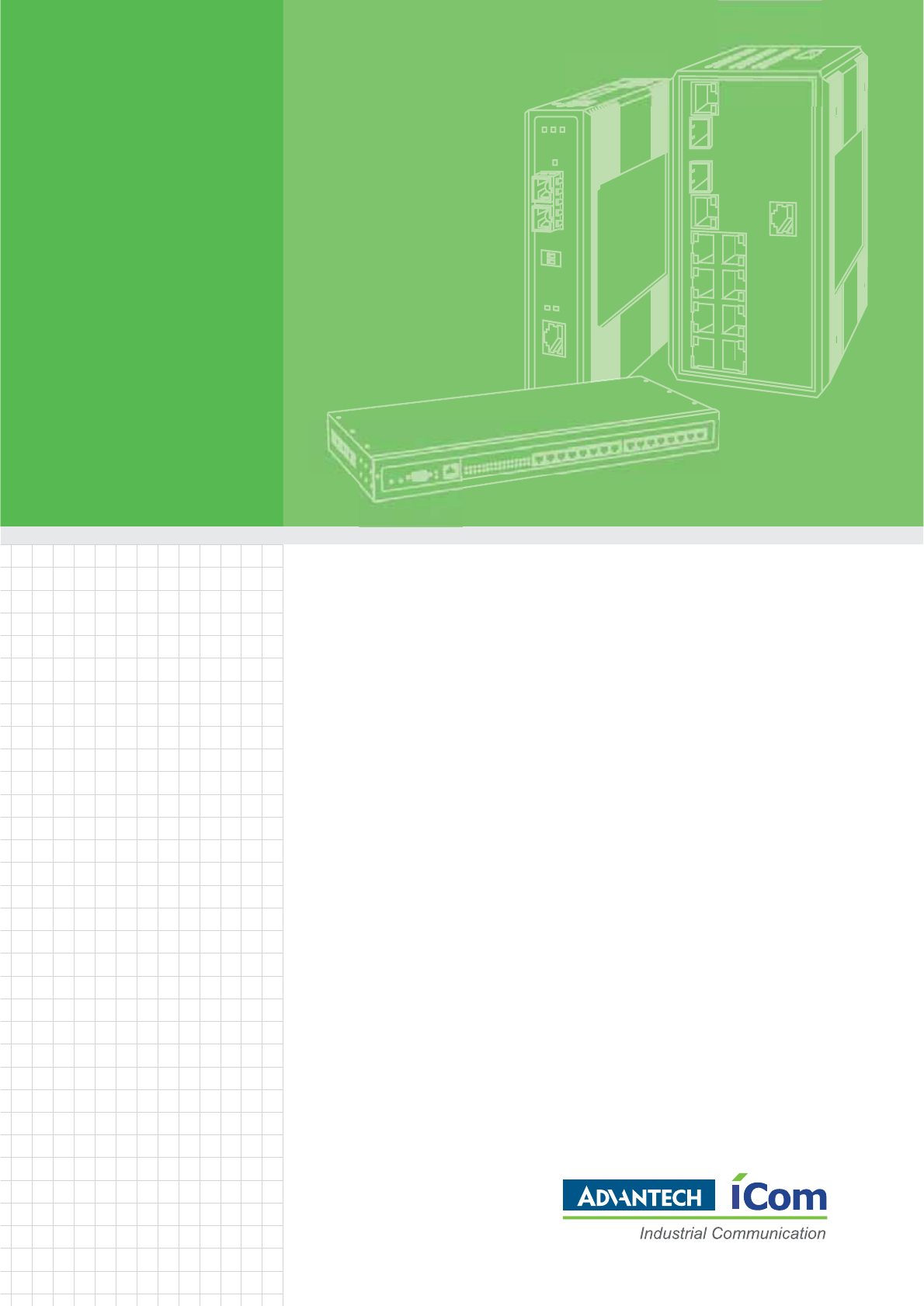
User Manual
EKI-1361/EKI-1362
1/2-port RS-232/422/485 to
802.11b/g/n WLAN Serial Device
Server

EKI-1361/EKI-1362 User Manual ii
Copyright
The documentation and the software included with this product are copyrighted 2013
by Advantech Co., Ltd. All rights are reserved. Advantech Co., Ltd. reserves the right
to make improvements in the products described in this manual at any time without
notice. No part of this manual may be reproduced, copied, translated or transmitted
in any form or by any means without the prior written permission of Advantech Co.,
Ltd. Information provided in this manual is intended to be accurate and reliable. How-
ever, Advantech Co., Ltd. assumes no responsibility for its use, nor for any infringe-
ments of the rights of third parties, which may result from its use.
Acknowledgements
Intel and Pentium are trademarks of Intel Corporation.
Microsoft Windows and MS-DOS are registered trademarks of Microsoft Corp.
All other product names or trademarks are properties of their respective owners.
Product Warranty (5 years)
Advantech warrants to you, the original purchaser, that each of its products will be
free from defects in materials and workmanship for two years from the date of pur-
chase.
This warranty does not apply to any products which have been repaired or altered by
persons other than repair personnel authorized by Advantech, or which have been
subject to misuse, abuse, accident or improper installation. Advantech assumes no
liability under the terms of this warranty as a consequence of such events.
Because of Advantech’s high quality-control standards and rigorous testing, most of
our customers never need to use our repair service. If an Advantech product is defec-
tive, it will be repaired or replaced at no charge during the warranty period. For out-
of-warranty repairs, you will be billed according to the cost of replacement materials,
service time and freight. Please consult your dealer for more details.
If you think you have a defective product, follow these steps:
1. Collect all the information about the problem encountered. (For example, CPU
speed, Advantech products used, other hardware and software used, etc.) Note
anything abnormal and list any onscreen messages you get when the problem
occurs.
2. Call your dealer and describe the problem. Please have your manual, product,
and any helpful information readily available.
3. If your product is diagnosed as defective, obtain an RMA (return merchandize
authorization) number from your dealer. This allows us to process your return
more quickly.
4. Carefully pack the defective product, a fully-completed Repair and Replacement
Order Card and a photocopy proof of purchase date (such as your sales receipt)
in a shippable container. A product returned without proof of the purchase date
is not eligible for warranty service.
5. Write the RMA number visibly on the outside of the package and ship it prepaid
to your dealer.
Part No. Edition 1
Printed in Taiwan December 2013

iii EKI-1361/EKI-1362 User Manual
Declaration of Conformity
CE
This product has passed the CE test for environmental specifications. Test conditions
for passing included the equipment being operated within an industrial enclosure. In
order to protect the product from being damaged by ESD (Electrostatic Discharge)
and EMI leakage, we strongly recommend the use of CE-compliant industrial enclo-
sure products.
FCC Class B
Note: This equipment has been tested and found to comply with the limits for a Class
B digital device, pursuant to part 15 of the FCC Rules. These limits are designed to
provide reasonable protection against harmful interference in a residential installa-
tion. This equipment generates, uses and can radiate radio frequency energy and, if
not installed and used in accordance with the instructions, may cause harmful inter-
ference to radio communications. However, there is no guarantee that interference
will not occur in a particular installation. If this equipment does cause harmful interfer-
ence to radio or television reception, which can be determined by turning the equip-
ment off and on, the user is encouraged to try to correct the interference by one or
more of the following measures:
Reorient or relocate the receiving antenna.
Increase the separation between the equipment and receiver.
Connect the equipment into an outlet on a circuit different from that to which the
receiver is connected.
Consult the dealer or an experienced radio/TV technician for help.
Declaration of Conformity
For Wireless Device
This device complies with Industry Canada licence-exempt RSS standard(s).Opera-
tion is subject to the following two conditions: (1) this device may not cause interfer-
ence, and (2) this device must accept any interference, including interference that
may cause undesired operation of the device.
For ITE Products
Industry Canada - Class B
This digital apparatus does not exceed the Class B limits for radio noise emissions
from digital apparatus as set out in the interference-causing equipment standard enti-
tled “Digital Apparatus”, ICES-003 of Industry Canada.

EKI-1361/EKI-1362 User Manual iv
Technical Support and Assistance
1. Visit the Advantech web site at www.advantech.com/support where you can find
the latest information about the product.
2. Contact your distributor, sales representative, or Advantech's customer service
center for technical support if you need additional assistance. Please have the
following information ready before you call:
–Product name and serial number
–Description of your peripheral attachments
–Description of your software (operating system, version, application software,
etc.)
–A complete description of the problem
–The exact wording of any error messages
Safety Instructions
1. Read these safety instructions carefully.
2. Keep this User Manual for later reference.
3. Disconnect this equipment from any AC outlet before cleaning. Use a damp
cloth. Do not use liquid or spray detergents for cleaning.
4. For plug-in equipment, the power outlet socket must be located near the equip-
ment and must be easily accessible.
5. Keep this equipment away from humidity.
6. Put this equipment on a reliable surface during installation. Dropping it or letting
it fall may cause damage.
7. The openings on the enclosure are for air convection. Protect the equipment
from overheating. DO NOT COVER THE OPENINGS.
8. Make sure the voltage of the power source is correct before connecting the
equipment to the power outlet.
9. Position the power cord so that people cannot step on it. Do not place anything
over the power cord.
10. All cautions and warnings on the equipment should be noted.
11. If the equipment is not used for a long time, disconnect it from the power source
to avoid damage by transient overvoltage.
12. Never pour any liquid into an opening. This may cause fire or electrical shock.
13. Never open the equipment. For safety reasons, the equipment should be
opened only by qualified service personnel.
14. If one of the following situations arises, get the equipment checked by service
personnel:
–The power cord or plug is damaged.
–Liquid has penetrated into the equipment.
–The equipment has been exposed to moisture.
–The equipment does not work well, or you cannot get it to work according to
the user's manual.
–The equipment has been dropped and damaged.
–The equipment has obvious signs of breakage.
15. DO NOT LEAVE THIS EQUIPMENT IN AN ENVIRONMENT WHERE THE
STORAGE TEMPERATURE MAY GO BELOW -40° C (-40° F) OR ABOVE 80°
C (140° F). THIS COULD DAMAGE THE EQUIPMENT. THE EQUIPMENT
SHOULD BE IN A CONTROLLED ENVIRONMENT.

v EKI-1361/EKI-1362 User Manual
16. CAUTION: DANGER OF EXPLOSION IF BATTERY IS INCORRECTLY
REPLACED. REPLACE ONLY WITH THE SAME OR EQUIVALENT TYPE
RECOMMENDED BY THE MANUFACTURER, DISCARD USED BATTERIES
ACCORDING TO THE MANUFACTURER'S INSTRUCTIONS.
17. The sound pressure level at the operator's position according to IEC 704-1:1982
is no more than 70 dB (A).
DISCLAIMER: This set of instructions is given according to IEC 704-1. Advantech
disclaims all responsibility for the accuracy of any statements contained herein.
Safety Precaution - Static Electricity
Follow these simple precautions to protect yourself from harm and the products from
damage.
To avoid electrical shock, always disconnect the power from your PC chassis
before you work on it. Don't touch any components on the CPU card or other
cards while the PC is on.
Disconnect power before making any configuration changes. The sudden rush
of power as you connect a jumper or install a card may damage sensitive elec-
tronic components.

EKI-1361/EKI-1362 User Manual vi

vii EKI-1361/EKI-1362 User Manual
Contents
Chapter 1 Overview...............................................1
1.1 Introduction ............................................................................................... 2
1.2 Features .................................................................................................... 3
1.3 Specifications ............................................................................................ 3
1.4 Package Check List .................................................................................. 5
Chapter 2 Getting Started.....................................7
2.1 Understanding EKI-1361/EKI-1362........................................................... 8
2.1.1 Product Description....................................................................... 8
Figure 2.1 Dual Ethernet Connections......................................... 8
2.1.2 COM Port Redirector (Virtual COM Port)...................................... 9
Figure 2.2 COM Port Redirector .................................................. 9
Figure 2.3 Multi-Access Mode ................................................... 10
2.1.3 TCP Server Mode ....................................................................... 11
Figure 2.4 TCP Server Mode..................................................... 11
2.1.4 TCP Client Mode......................................................................... 11
Figure 2.5 TCP Client Mode ...................................................... 11
2.1.5 Serial Tunneling Mode ................................................................ 12
Figure 2.6 Serial Tunneling Mode.............................................. 12
2.1.6 UDP Server/Client Mode............................................................. 12
2.1.7 Control Mode .............................................................................. 12
2.2 Hardware................................................................................................. 13
2.2.1 LED Indicators ............................................................................ 13
Table 2.1: EKI-1361/1362 series LED Indicators ...................... 13
2.2.2 Dimensions (Units: mm).............................................................. 14
Figure 2.7 DIN-Rail Mount of EKI-1361 ..................................... 14
Figure 2.8 Wall Mount of EKI-1361............................................ 14
Figure 2.9 DIN-Rail Mount of EKI-1362 ..................................... 15
Figure 2.10Wall Mount of EKI-1362............................................ 15
2.3 Connecting Hardware ............................................................................. 16
2.3.1 Choosing the Location ................................................................ 16
Figure 2.11Combine the Metal Mounting Kit .............................. 16
Figure 2.12DIN-rail Step 2 .......................................................... 16
2.3.2 Wireless Connection ................................................................... 17
2.3.3 Network Connection.................................................................... 17
2.3.4 Power Connection....................................................................... 17
Figure 2.13Power Connector...................................................... 17
2.3.5 Serial Connection........................................................................ 18
Table 2.2: EKI-152X series Serial Pin Assignments.................. 18
2.4 Installing the Configuration Utility............................................................ 18
Chapter 3 Configuration .....................................21
21
3.1 Configuration Utility Overview ................................................................. 22
3.2 Discovering Serial Device Servers.......................................................... 23
3.2.1 Auto Searching ........................................................................... 23
3.2.2 Clear Device List and Search Again ........................................... 25
3.2.3 Manual Appending ...................................................................... 25
3.3 Network Settings ..................................................................................... 26
3.4 Administrator Settings ............................................................................. 28

EKI-1361/EKI-1362 User Manual viii
3.4.1 Locate the Serial Device Server ................................................. 28
3.4.2 Lock the Serial Device Server (Password Protection) ................ 28
3.4.3 Restore to Factory Default Settings............................................ 30
3.4.4 Update Firmware ........................................................................ 31
Chapter 4 Setting COM Redirector ................... 33
4.1 Setting COM Redirector (Virtual COM port)............................................ 34
4.1.1 Auto Mapping.............................................................................. 34
4.1.2 Manual Mapping ......................................................................... 36
4.1.3 Manual Direct Mapping Virtual COM Port................................... 38
4.1.4 Remove the Virtual COM Port .................................................... 38
Chapter 5 Web-Based Configuration................ 41
5.1 Overview ................................................................................................. 42
5.2 Accessing the Web Page........................................................................ 42
5.3 System .................................................................................................... 43
5.4 Network Configuration ............................................................................ 44
5.5 Wireless Configuration............................................................................ 45
5.6 Port Configuration ................................................................................... 48
5.6.1 Basic Port Configuration............................................................. 49
5.6.2 Operation Mode .......................................................................... 49
5.7 Monitor .................................................................................................... 57
5.8 Auto Warning (Alarm) ............................................................................. 58
5.8.1 Email Alert .................................................................................. 58
5.8.2 SNMP Trap ................................................................................. 59
5.8.3 System Event.............................................................................. 59
5.8.4 Serial Port Event......................................................................... 60
5.9 Change Password................................................................................... 60
5.10 Import/Export Device Settings ................................................................ 61
5.11 Reboot .................................................................................................... 62
Chapter 6 Telnet Configuration......................... 63
6.1 Overview ................................................................................................. 64
6.2 Telnet Console........................................................................................ 64
6.3 Command List......................................................................................... 65
Table 6.1: Console Command List ............................................ 65
Appendix A Pin Assignments............................... 79
A.1 Pin Assignments ..................................................................................... 80
A.1.1 RS-232 Pin Assignments............................................................ 80
A.1.2 RS-422/485 Pin Assignments..................................................... 80
Appendix B List of Known TCP and UDP Port
Numbers ............................................ 81
B.1 List of Known TCP and UDP Port Numbers ........................................... 82

Chapter 1
1Overview

EKI-1361/EKI-1362 User Manual 2
1.1 Introduction
Advantech's EKI-1300 series of Industrial Device Servers are a robust, feature-rich,
and cost effective way to network-enable equipment in an industrial automation envi-
ronment. The EKI-1361/1362 provides one or two serial ports, 802.11b/g/n wireless
LAN interface to connect any RS-232/422/485 devices to wireless LAN. These wire-
less serial device servers provide serial-to-wireless network connectivity as an alter-
native to wired Ethernet connectivity and enable virtually any serial device or
equipment to be remotely accessed, controlled, monitored, or shared on an 802.11b/
g/n wireless network.
By encapsulating serial data and transporting it over Ethernet, the EKI-1361/1362
allows virtual serial links over Ethernet IP-based networks. After Advantech Serial
Device Server Configuration Utility installed, standard serial operation calls with vir-
tual COM port could be transparently redirected to the serial device servers, guaran-
teeing compatibility with legacy serial devices and enabling backward compatibility
with existing software. EKI-1361/1362 also supports serial tunneling, allowing two
native serial devices to communicate over a network without any hosts or program-
ming. As a result, you can extend limited distance, point-to-point, direct serial con-
nections within the plant, throughout the factory, the facility, the office building, or
across the global enterprise.
The EKI-1361/1362 provides an impressive list of features and functions enabling
multiple industrial devices to be connected, controlled, configured, managed, and
updated over a network. With serial ports and 802.11b/g/n wireless LAN, the EKI-
1361/1362 can easily connects multiple serial devices to a network. The transmission
speed of the EKI-1361/1362 is up to 921.6 Kbps totally outstripping the competition to
meet the demand for high-speed exchange. Functionally transparent and efficient,
the EKI-1361/1362 is especially designed for remotely controlling and monitoring
devices via the Internet.
The EKI-1361/1362 provides roaming ability. EKI-1361/1362 can midgrate from AP to
AP during certain condition. In some field applications, the device can't use a fixed
physical connection, such as AGV, transportation, and cross wide space communica-
tion. EKI-1361/1362 can easily installed to fulfill this requirement. With compact size
and lightweight design, EKI-1361/1362 could be installed onto the moving vehicle
without much extra loading.
Types of supported devices:
Human Machine Interface (HMI)
Programmable Controller(PLC)
Flow meters
Temperature / pressure monitoring equipment
Gas leak detection device
Scales
Power monitoring equipment
Data Acquisition Modules
EKI-136X series provides various operation modes: COM port redirection (Virtual
COM port), TCP/UDP server/client mode. Serial devices can be connected by means
of multi-access modes.

3 EKI-1361/EKI-1362 User Manual
Chapter 1 Overview
1.2 Features
Support standard Wireless 802.11 b/g/n
Support MIMO 2x2 technology
Expand up 4096 serial ports for one single host
Provides 10/100/1000 Mbps auto-sensing Ethernet ports for easy diagnostic
Supports any baud rate setting from 50 bps up to 921.6 Kbps
Supports various operation modes: COM port redirection (Virtual COM port),
TCP server/client, UDP server/client, control mode and RFC-2217 mode
Easy to diagnostic LED indicators
Supports multi-access features: allows maximum 5 hosts to access one serial
port simultaneously
Allows maximum 16 peers in TCP/UDP client mode
Mounts on DIN rail, wall, or panel easily
Surge protection for RS-422/485 line and power supply
SNMP MIB-II for network management
1.3 Specifications
WLAN Interface
Standard Conformance: 802.11b, 802.11g, and 802.11n
Network Modes: Infrastructure, Ad-Hoc
Transmit Power:
– 802.11b: +16 dBm (typical)
– 802.11g: +16 dBm @ 6~36 Mbps, +11 dBm @ 54Mbps
– 802.11n/HT20: +16 bBm @ MCS 0 ~ 3, +9 dBm @ MCS 7, +19dBm @ MCS
9, +11 dBm @ MCS 15
– 802.11n/HT40: +16 bBm @ MCS 0 ~ 3, +8 dBm @ MCS 7, +19dBm @ MCS
9, +11 dBm @ MCS 15
Receive Sensditivity: -82 dBm (Max.)
Data Rate:
–802.11b: 1, 2, 5.5, and 11 Mbps
–802.11g: 6, 9, 12, 18, 24, 36, 48, and 54 Mbps
–802.11n:
- 20 MHz Channel:
1Nss: 65 Mbps @ 800 GI, 72.2 Mbps @ 400 GI (Max.)
2Nss: 130 Mbps @ 800 GI, 144.4 Mbps @ 400 GI (Max.)
- 40 MHz Channel:
1Nss: 135 Mbps @ 800 GI, 150 Mbps @ 400 GI (Max.)
2Nss: 270 Mbps @ 800 GI, 300 Mbps @ 400 GI (Max.)
Transmission Distance: Up to 100 meters (in open areas with bundle external
antenna)
Wireless Security:
–WEP: 64-bit/128-bit data encryption
–WPA, WPA2, 802.11i: Enterprise mode and Pre-Share Key (PSK) mode
–Encryption: EAP-TLS, EAP-TTLS, EAP-PEAP
Antenna Connector: Reverse SMA

EKI-1361/EKI-1362 User Manual 4
Bundle Externel Antenna
Frequency Range: 2.4GHz ~ 2.5GHz
Impedanc: 50 Nominal
VSWR: 1.92:1Max.
Return Loss: 10dB Max.
Radiation: Omni-directional
Gain(Peak): 2dBi
Polarization: Linear; Vertical
Admitted Power: 1W
LAN
Ethernet: 10/100 Mbps auto sensing
No. of Ports: 1
Port Connector: RJ45
Protection: Built-in 1.5 KV magnetic isolation
Serial Interface
Interface: RS-232/422/485, software selectable
No. of Ports:
–EKI-1361: 1
–EKI-1362: 2
Port Connector: DB9 male
Baud Rate: 50 bps to 921.6 Kbps
Parity: None, Even, Odd, Space, Mark
Data bits: 5, 6, 7, 8
Stop bits: 1, 1.5, 2
Flow control: XON/XOFF, RTS/CTS, DTR/DSR
Signals:
–RS-232: TxD, RxD, CTS, RTS, DTR, DSR, DCD, RI, GND
–RS-422: TxD+, TxD-, RxD+, RxD-, GND
–RS-485: Data+, Data-, GND
Protection: 15 KV ESD for all signals, enhanced protection for RS-422/485 lines
Software
Utility: Advantech Serial Device Server Configuration Utility
Driver support: Windows 2000/XP/Vista/7, Windows Server 2003/2008, Linux
Operation Mode:
–COM port redirection (Virtual COM)
–TCP/UDP server (polling) mode
–TCP/UDP client (event handling) mode
–Pair connection mode
Configuration: Web interface, Windows utility, Telnet console
Protocol: ICMP, IP, TCP, UDP, BOOTP, DHCP, Auto IP, Telnet, SNMP, HTTP,
DNS, SMTP, ARP, NTP
Management: SNMP MIB-II

5 EKI-1361/EKI-1362 User Manual
Chapter 1 Overview
General
LED indicators:
–System: Power, System Status
–WLAN: Signal Strength, Link
–LAN: Speed, Link/Active
–Serial: Tx, Rx
Power
Power input: 12 ~ 48 V(DC), redundant dual inputs
Power connector: Terminal block
Power Consumption:
–EKI-1361: 8W
–EKI-1362: 9W
Power Line Protection: 1 KV burst (EN61000-4-4), 0.5 KV surge (EN51000-4-5)
Environmental
Operation Temperature: -30 ~ 65°C (-22 ~ 149°F)
Storage Temperature: -40 ~ 80°C (-40 ~ 176°F)
Operating Humidity: 5 to 95% RH
Regulatory Approvals
ECM: CE, FCC Part 15 Subpart B (Class B)
1.4 Package Check List
1 x EKI-1361/1362 Serial Device Server
Panel/Wall mounting bracket
DIN-rail mounting kit
CD-ROM for utility and user manual
Optional Accessory:
OPT1-DB9-AE D-sub 9 (female) to terminal block connector (for EKI-1000
series RS-422/485 use)

EKI-1361/EKI-1362 User Manual 6

Chapter 2
2Getting Started
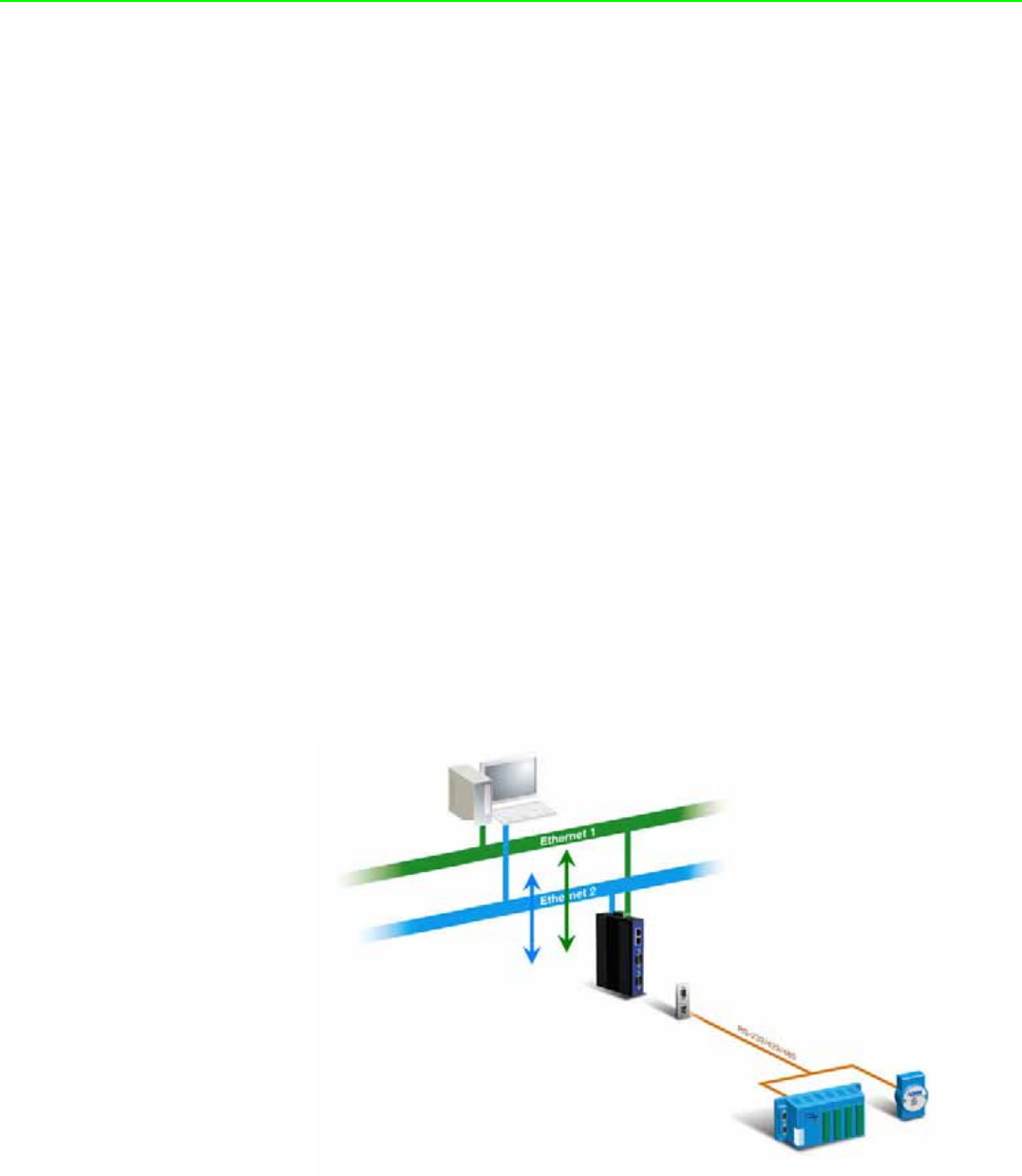
EKI-1361/EKI-1362 User Manual 8
2.1 Understanding EKI-1361/EKI-1362
The EKI-136X series are wireless-based, serial device servers for connecting RS-
232/422/485 devices to a TCP/IP network. Once connected through EKI series, the
serial device will be able to send and receive data on a network like any other net-
work device. It extends traditional COM ports of a PC with access over a TCP/IP net-
work. Through networking, you can control and monitor remote serial devices either
over a LAN or over the WAN. Since the EKI series is connected through a TCP/IP
network, you might need to know some basic facts about networking in order to get
the server hooked up correctly.
2.1.1 Product Description
The EKI series is designed to network-enable any RS-232/422/485 serial device and
provide industry-grade hardware and easy-use software to make connecting serial
devices to an Ethernet network a surprisingly simple process. These units immedi-
ately upgrade your existing serial devices for integration into the Internet world. The
EKI series features a lot of powerful functions such as: high speed data transfer,
access-control, auto-detection of all EKI series products, remote connection from dif-
ferent network domain, remote firmware download, and more.
After the simple installation steps to attach your network and serial device to the
appropriate connectors on the serial device servers and driver installation, you will
then be able to communicate with the serial devices via its own application software
and with the EKI serial device server. COM port redirector, TCP server mode, TCP
client mode, UDP server mode, UDP client mode and Control mode are all different
schemes to make a serial connection across using one or more Serial device server.
Figure 2.1 Dual Ethernet Connections
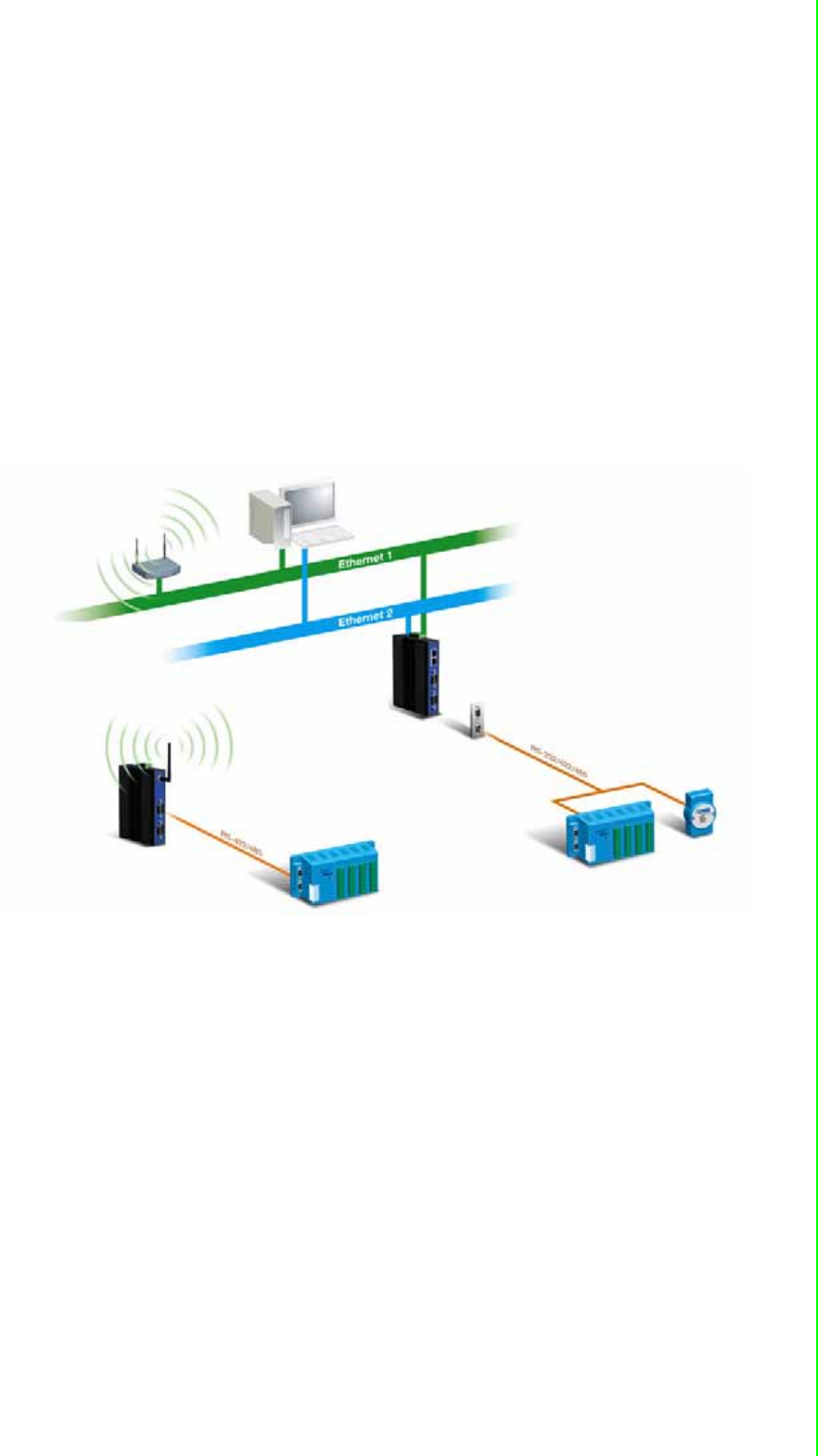
9 EKI-1361/EKI-1362 User Manual
Chapter 2 Getting Started
2.1.2 COM Port Redirector (Virtual COM Port)
Advantech Serial Device Server Configuration Utility is a serial COM port redirector
that creates virtual COM ports and provides access to serial device connected to
Advantech serial device server. You can configure the serial device server and
enable the Virtual COM port using one integrated utility. Advantech Serial Device
Server Configuration Utility allows you to configure Microsoft applications to
communicate with network enabled serial device servers as easily as if they were
physically installed in or directly connected on the PC.
The Advantech redirector can create up to 4096 virtual COM ports. Application on the
host can open virtual COM port to access the serial device servers at the same time.
The redirector will handle each active virtual COM port as a separate TCP
connection to Advantech serial device servers.
Figure 2.2 COM Port Redirector
2.1.2.1 Normal Mode
The Advantech redirector connects the Advantech serial device servers while an
application open the COM port and disconnects from the Advantech serial device
servers when the application closes the COM port. The redirector uses TCP network
connections to the Advantech serial device server to gain the access to the
connected serial devices.
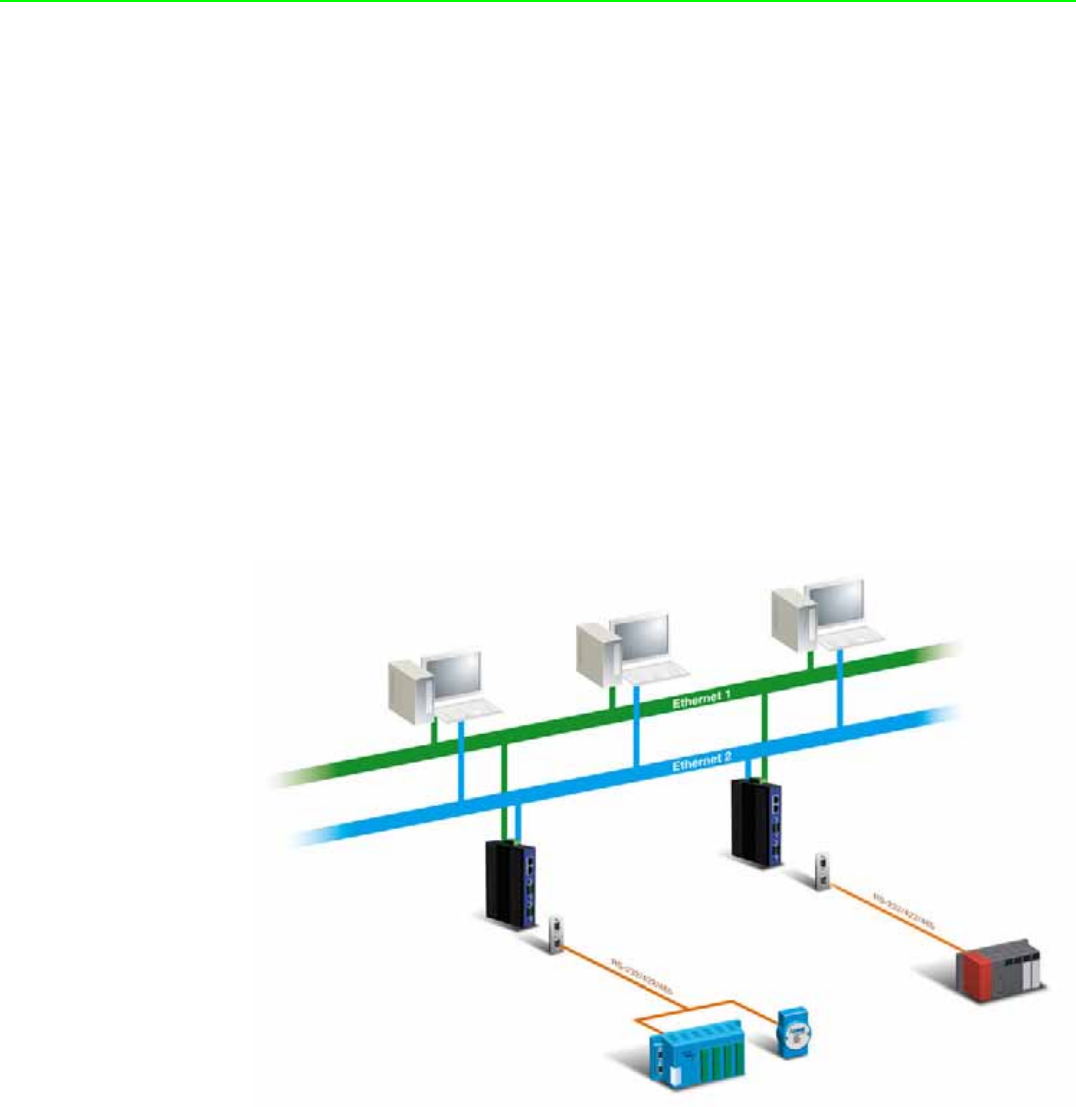
EKI-1361/EKI-1362 User Manual 10
2.1.2.2 Multi-Access Mode (Shared COM port mode)
Most of serial devices are connected directly and physically to the PC serial ports via
a cable. The operation system, ex. Windows XP, provides the COM ports that user’s
application can access, and control the serial device through the serial cable. This
means that the serial device can be connected to one host and only one application
on this host can handle input, output and control operation on this device.
If you want to run more than one applications to use a serial device, you can employ
EKI serial device servers that provide a virtual COM port for a host or multi-hosts on
an Ethernet network. EKI serial device server is located between hosts and serial
devices. Each serial port on the EKI serial device server can allow max. five host
connections through one Ethernet port or two Ethernet ports. There are two major
operation modes for Multi-Access Mode. First one is broadcast mode; EKI serial
device server handles a command from one application and replies the data from the
serial port to all applications that are connecting this serial port. Another one is polling
mode; EKI serial device server handles the command from one application and reply
to this application only. Query from other applications must be queued and wait for
current process completing.
Figure 2.3 Multi-Access Mode
By using a serial derive server to share serial device, you eliminate the separate
serial lines and serial devices that can be attached to individual hosts. Collecting the
data from these serial devices become more easily and more effectively.
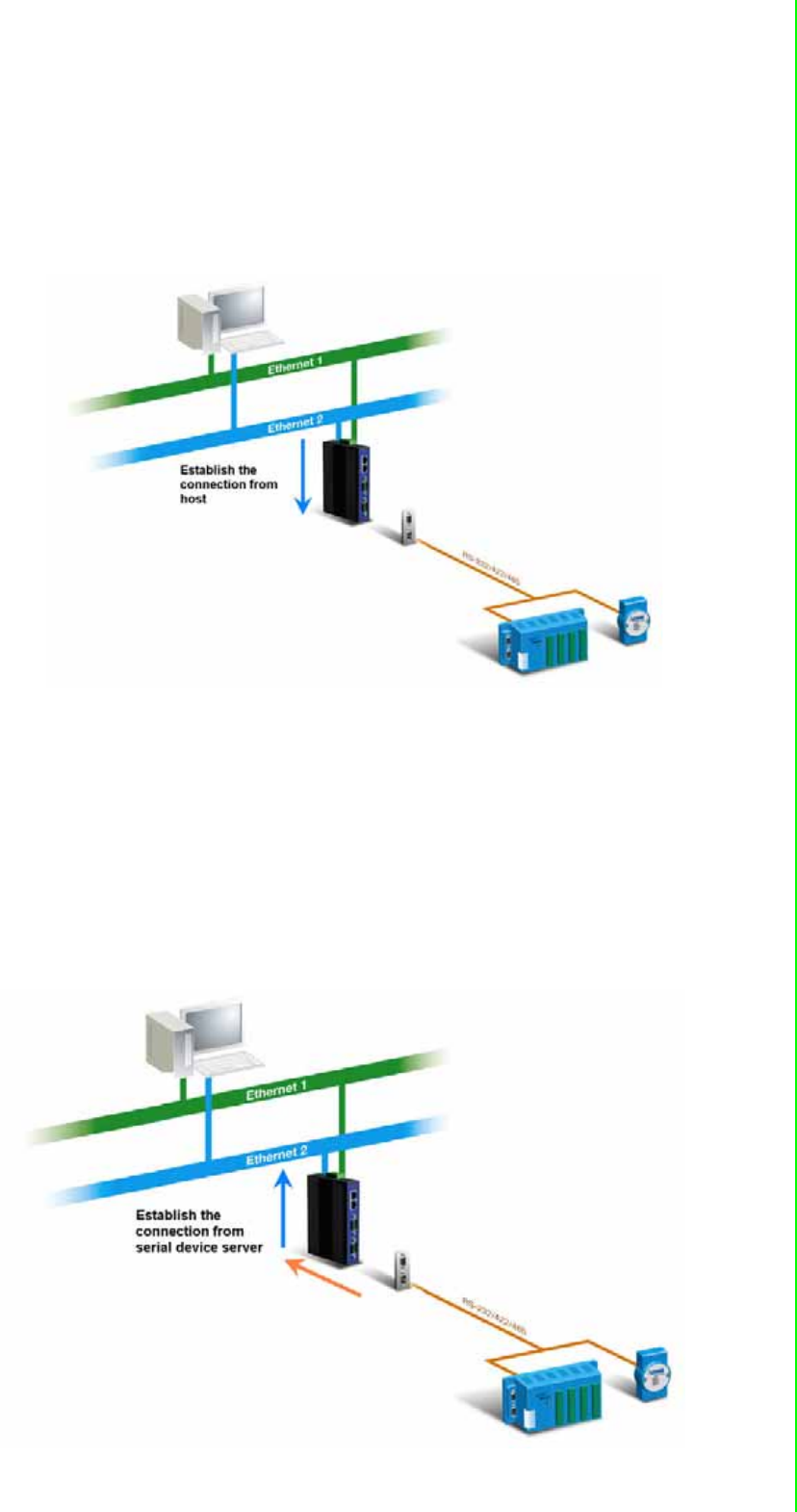
11 EKI-1361/EKI-1362 User Manual
Chapter 2 Getting Started
2.1.3 TCP Server Mode
In TCP server mode, you might initiate the TCP connection from host to EKI serial
device server. This operation mode support max. 5 simultaneous connections for
each serial port on EKI serial device server from one host or several hosts, however
multi-hosts collect the data from one serial port at the same time
Figure 2.4 TCP Server Mode
2.1.4 TCP Client Mode
In TCP Client mode, the TCP connection will be established from EKI serial device
server. This operation mode supports max.16 simultaneous connections for each
serial port on EKI series to one host or several hosts. You should configure the IP
address and TCP port number of the network hosts which the EKI serial device
server connect to using Advantech Serial Device Server Configuration Utility. After
configuration, when EKI serial device server receives the data from serial port, the
device server will employ the connection to hosts which are configured.
Figure 2.5 TCP Client Mode
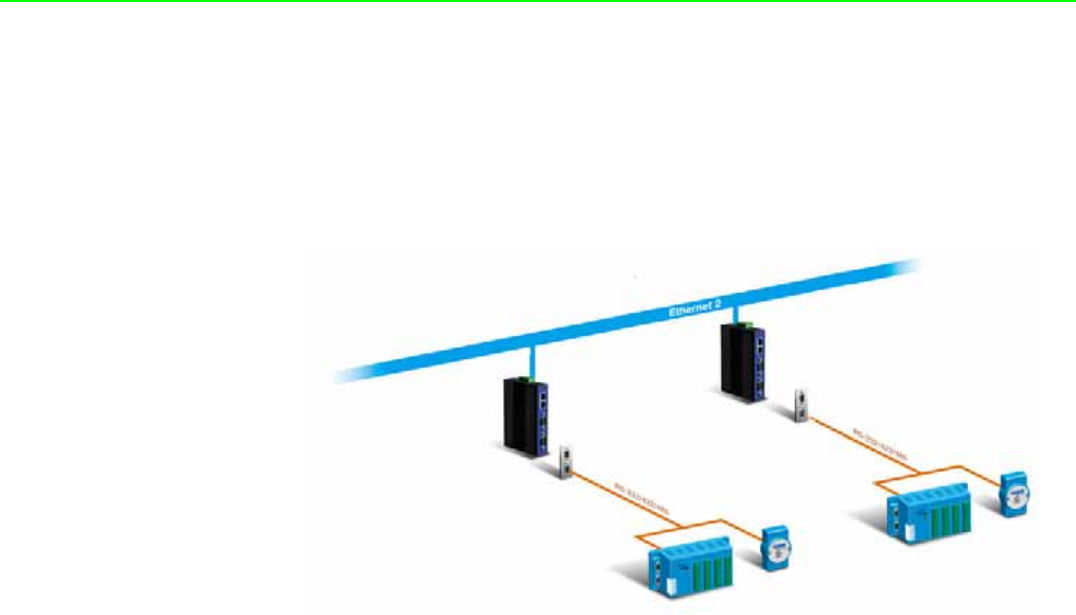
EKI-1361/EKI-1362 User Manual 12
2.1.5 Serial Tunneling Mode
Two native serial devices can communicate over an Ethernet network without any
intermediate host PC and software programming. Serial Tunneling is very simple to
use. You can use Advantech Serial Device Server Configuration Utility to designate
one serial port as the tunneling master and another serial device server port as the
tunneling slave.
Figure 2.6 Serial Tunneling Mode
2.1.6 UDP Server/Client Mode
UDP is used primarily for broadcasting messages over a network. In the UDP server
mode, EKI series access max. 8 hosts’ UDP message. In the UDP client mode, EKI
serial device servers transmit UDP message to max. 16 hosts simultaneously.
2.1.7 Control Mode
In controlling mode, the EKI serial device server presents a modem interface to the
attached serial device: it accepts AT-style modem commands to connect / disconnect
to other networking device. If you want serial device running application program to
connect/disconnect to different devices by request, you can use controlling mode.
The controlling mode provides three kinds of modem AT-style commands. The serial
devices can use these commands to control EKI series connecting or disconnecting
to remote networking devices. Thus intelligent serial devices such as stand-alone
PLC will send /receive data to/from devices one by one via Ethernet.

13 EKI-1361/EKI-1362 User Manual
Chapter 2 Getting Started
2.2 Hardware
In this section, we will give you an overview of EKI-1361/EKI-1362 hardware and
installation.
2.2.1 LED Indicators
There are LEDs display the power status, network status, and serial communication
status located on the front panel of EKI-1361/EKI-1362, each of them has its own
specific meaning as below table.
Table 2.1: EKI-1361/1362 series LED Indicators
LED Name LED Color LED Description
PWR1 Green Power 1 is on.
Off Power 1 is off, or power error condition exists.
PWR2 Green Power 2 is on.
Off Power 2 is off, or power error condition exists.
Status Status
Blinking: System is ready.
Steady on: The device server has been located by utility’s location
function.
Off System is not working.
LAN Green
Blinking: Ethernet port is transmitting or receiving data.
Steady on: Ethernet has the good link for 10Mbps or 100Mbps
operations.
Off Ethernet is not working.
WLAN Orange Steady on: WLAN link is ready
Off WLAN is not working.
Signal
Strength
Off 0~25% WLAN signal strength.
Orange
(One) 25~50% WLAN signal strength.
Orange
(Two) 50~75% WLAN signal strength.
Orange
(Three) 75~100% WLAN signal strength.
Serial
Tx, Orange Serial port is transmitting data.
Rx, Green Serial port is receiving data.
Off No data is transmitted or received through the serial port.
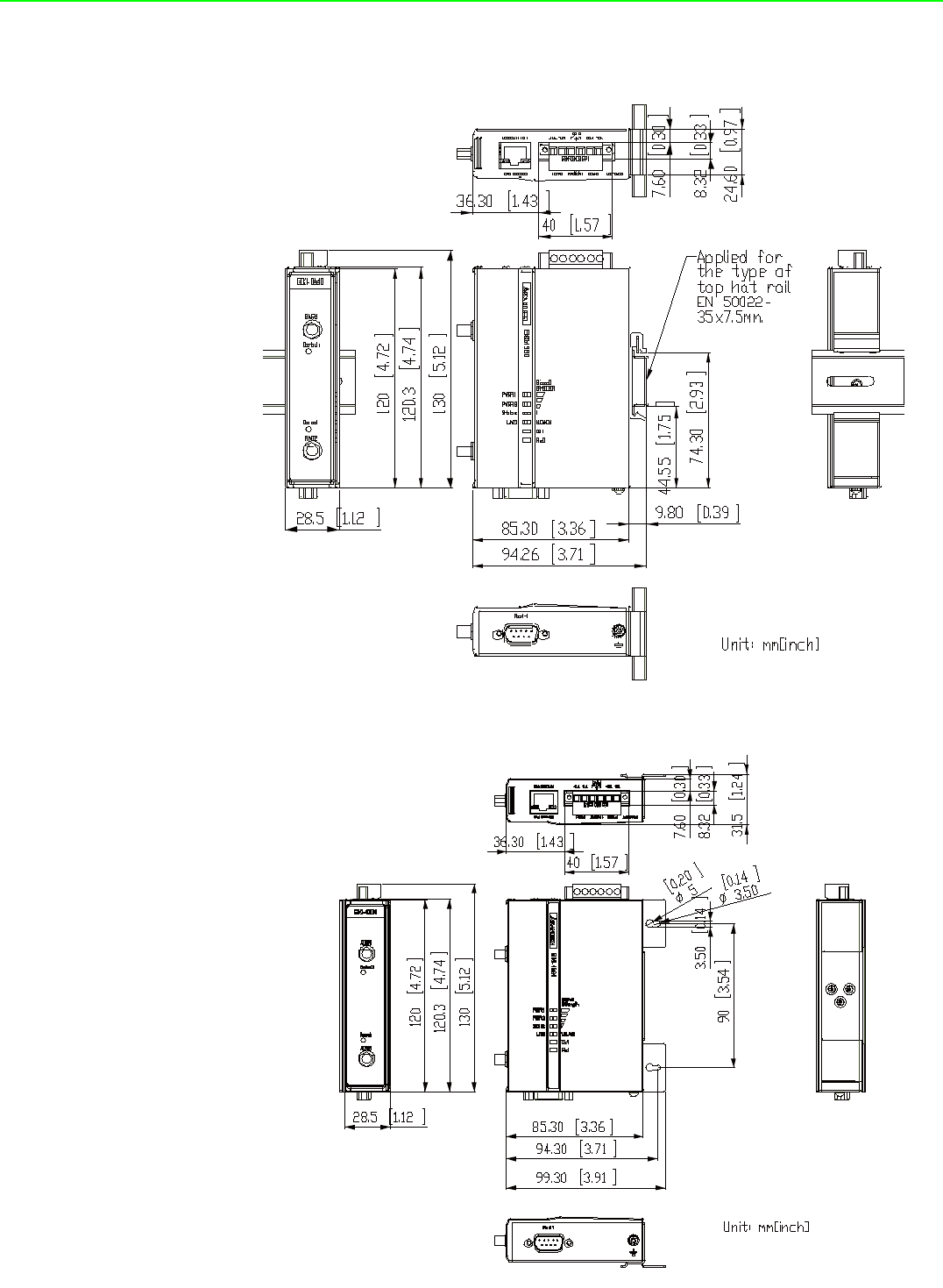
EKI-1361/EKI-1362 User Manual 14
2.2.2 Dimensions (Units: mm)
Figure 2.7 DIN-Rail Mount of EKI-1361
Figure 2.8 Wall Mount of EKI-1361
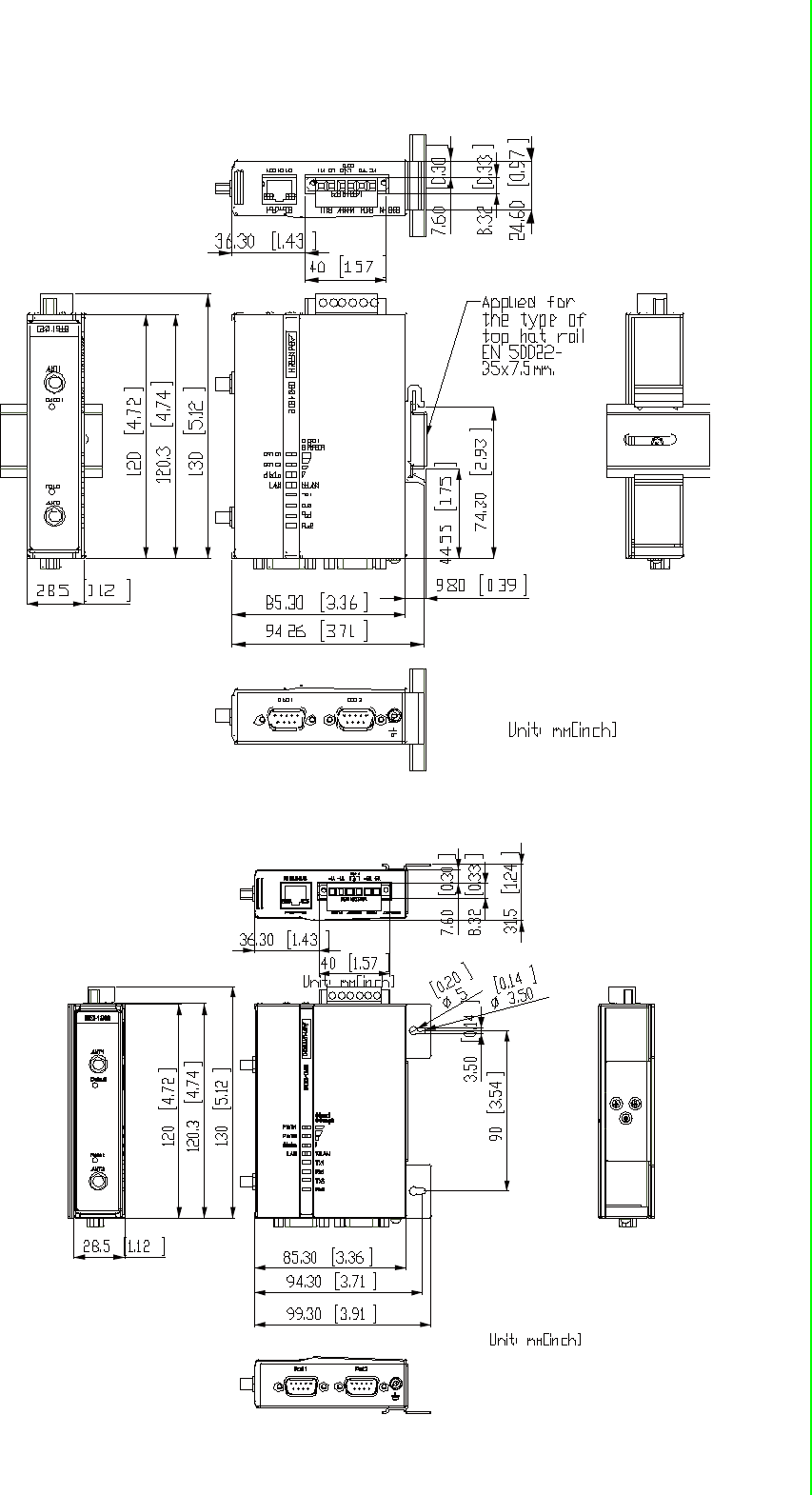
15 EKI-1361/EKI-1362 User Manual
Chapter 2 Getting Started
Figure 2.9 DIN-Rail Mount of EKI-1362
Figure 2.10 Wall Mount of EKI-1362
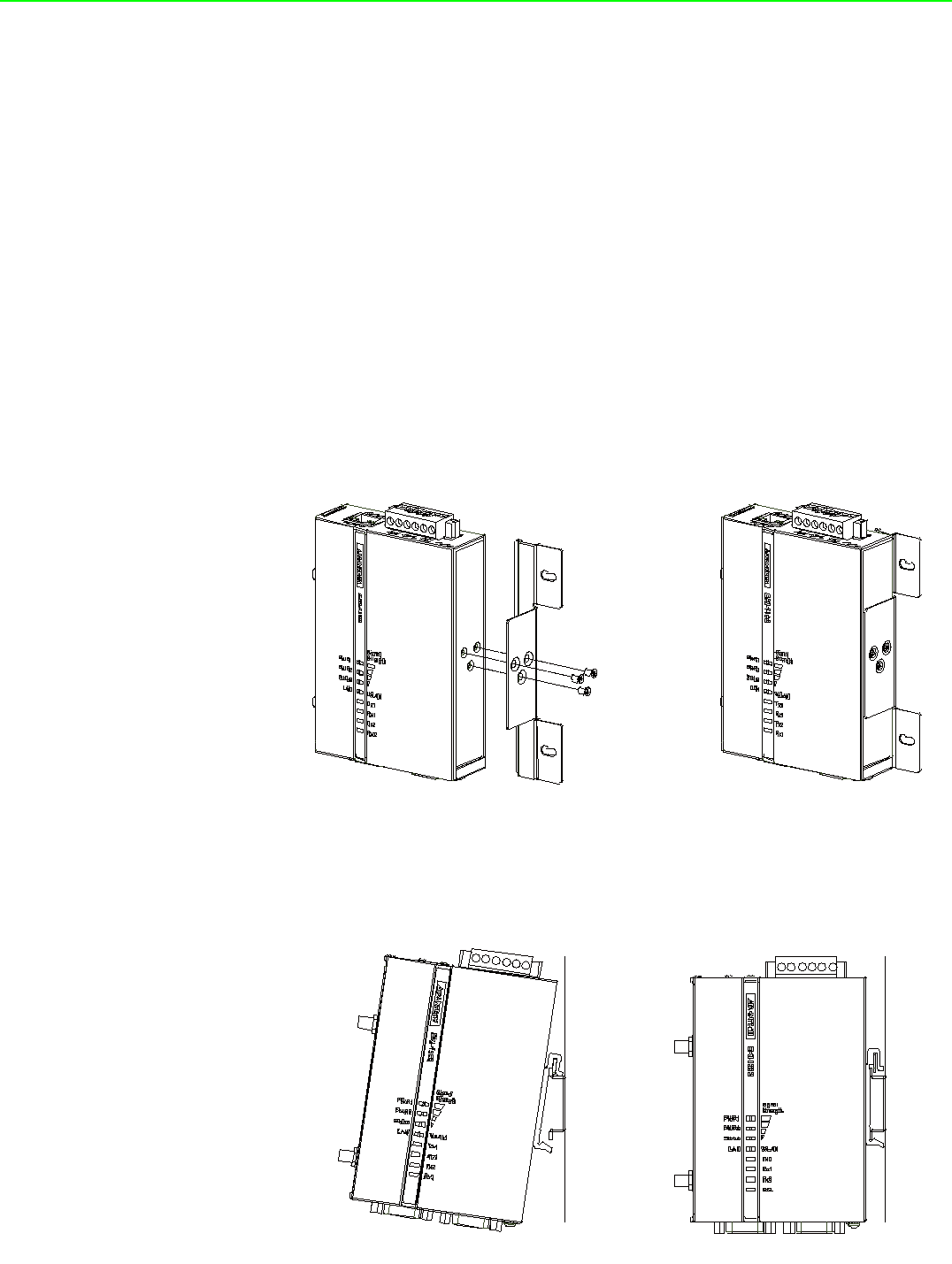
EKI-1361/EKI-1362 User Manual 16
2.3 Connecting Hardware
Next, we will explain how to find a proper location for your EKI series, and then
explain how to connect to the network, hook up the power cable, and connect to the
EKI series serial port.
2.3.1 Choosing the Location
Due to its versatility and innovative design, EKI serial device server can be:
Fixed to a panel/wall mount
Fixed to a DIN-rail
2.3.1.1 Panel/Wall Mounting
The EKI-1361/EKI-1362 can be attached to a wall using the included metal brackets.
Each bracket comes with 3 screws; and then you can install the device firmly via the
components, please see the figure as below.
Figure 2.11 Combine the Metal Mounting Kit
2.3.1.2 DIN Rail Mounting
You can mount the EKI-152X series on a standard DIN-rail. Please screw the DIN-rail
kit on the serial device server first.
Figure 2.12 DIN-rail Step 2
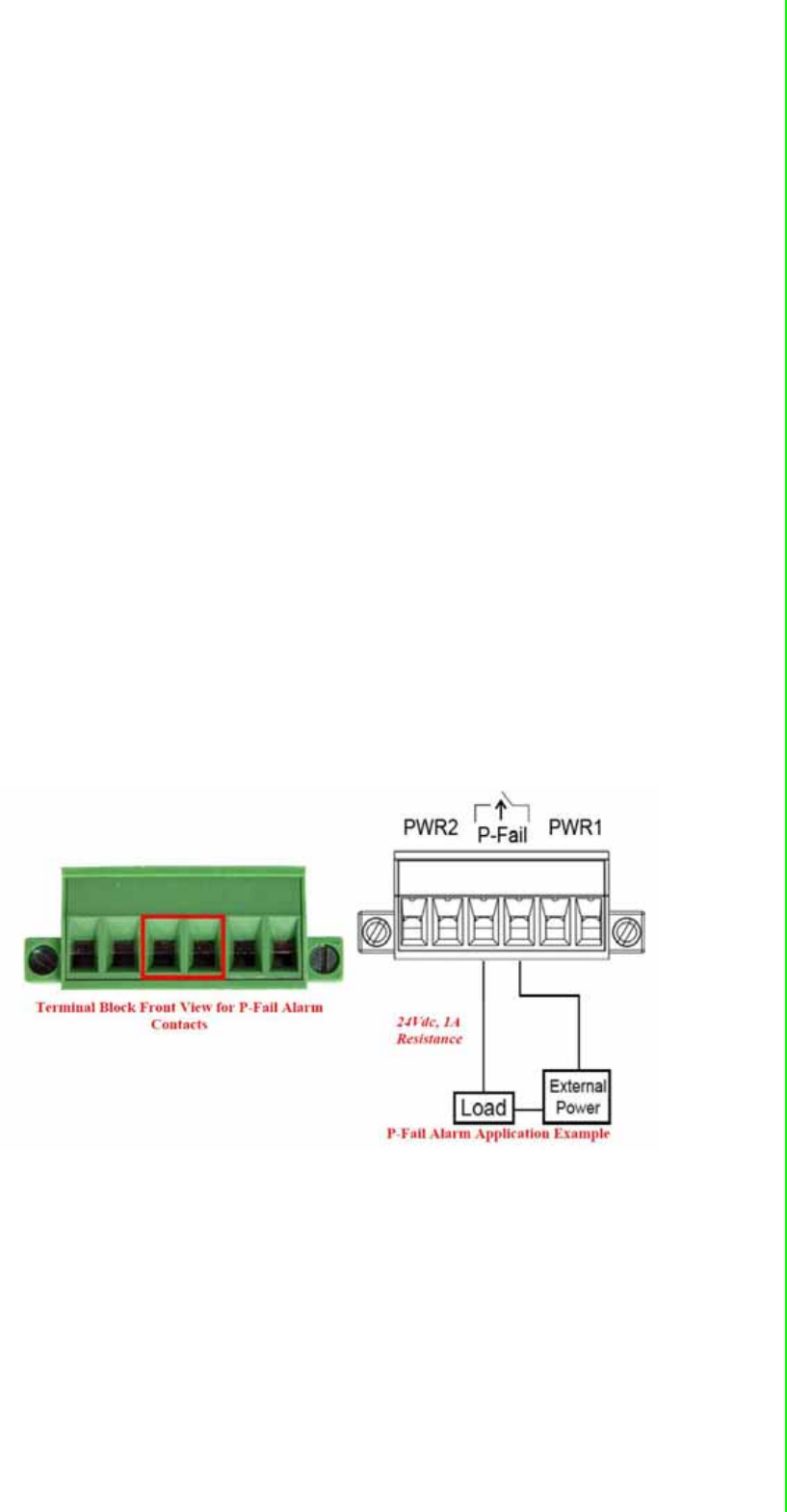
17 EKI-1361/EKI-1362 User Manual
Chapter 2 Getting Started
2.3.2 Wireless Connection
EKI-1361/EKI-1362 operates in the 802.11b/g/n WLAN environment, which is cre-
ated by an access point working with 802.11b/g/n protocols. When configuring EKI-
1361/EKI-1362 in unknown status, user can use the Ethernet port and Configuration
Utility to locate device easily. After found device in the Configuration Utility, user can
configure the Ethernet and Wireless IP address to access web interface for advanced
settings including serial port operation mode and wireless configurations. More detail
description can be found in next chapters.
You can check the signal access strength with the WLAN signal strength LED indica-
tors. Adjust the antenna of the EKI serial device server to optimize communication
quality.
2.3.3 Network Connection
EKI-1361/EKI-1362 has a RJ-45 Ethernet port that supports 10 Mbps Ethernet, or
100 Mbps Fast Ethernet, and half or full duplex operation. EKI-1361/EKI-1362 can be
connected to other hubs or switches through a twisted-pair straight through the cable
or a crossover cable up to 100m long. When use EKI-1361/EKI-1362 for first time,
user can connect to device with Configuration Utility. Or you can set the host's ip
address in the same domain with device. Then user can use popular browser to
connect web interface EKI-1361/EKI-1362 built-in for advanced configuration.
2.3.4 Power Connection
The EKI-1361/EKI-1362 supports dual 12 to 48 VDC power inputs and power-fail
relay output.
Figure 2.13 Power Connector
You can connect an alarm indicator, buzzer or other signaling equipment through the
relay output. The relay opens if power input 1 or 2 fails (“Open” means if you connect
relay output with an LED, the light would be off).
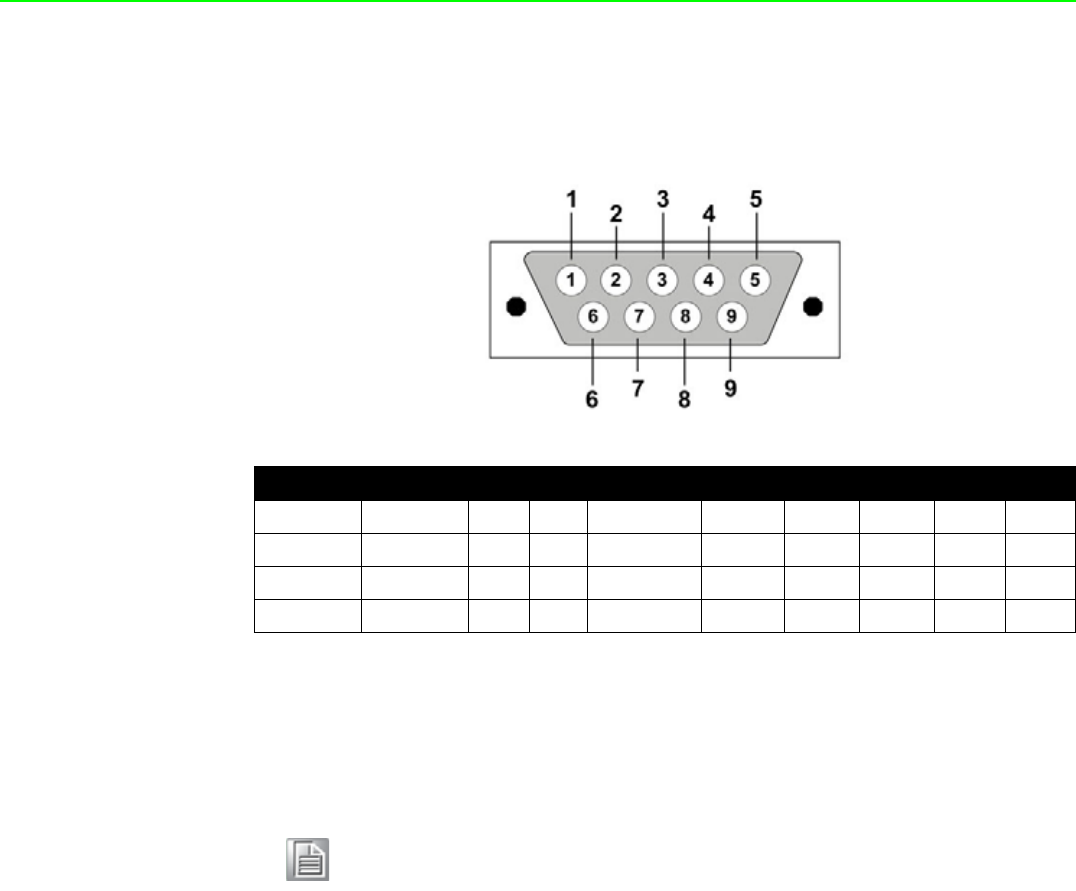
EKI-1361/EKI-1362 User Manual 18
2.3.5 Serial Connection
EKI-1361/EKI-1362 provides 1 or 2 serial ports with DB9 (male) connectors. RS-232/
422/485 pin assignments as below:
2.4 Installing the Configuration Utility
The following section will show you how to install the Advantech serial device server
configuration utility, a tool to set up and monitor the EKI serial device servers.
1. Insert the Advantech industrial communication IEDG series driver utility CD into
the CD-ROM drive (e.g. E:\) on the host PC.
2. Use Windows explorer or the Windows Run command to execute the setup pro-
gram, the path for the setup program on the CD-ROM should be: E:\Util-
ity&Driver\SerialDeviceServerConfigurationUtility\Serial_Device_Server_Config
uration_Utility_[Version]_Release_[date].exe
Table 2.2: EKI-152X series Serial Pin Assignments
Pin 1 2 3 4 5 6 7 8 9
RS-232 DCD RX TX DTR GND DSR RTS CTS RI
RS-422 TX- - - TX+ GND - RX+ - RX-
RS-485 DATA- - - DATA+ GND - - - -
Note! Be sure the Microsoft .NET Framework on your host PC is greater than
version 2.0.
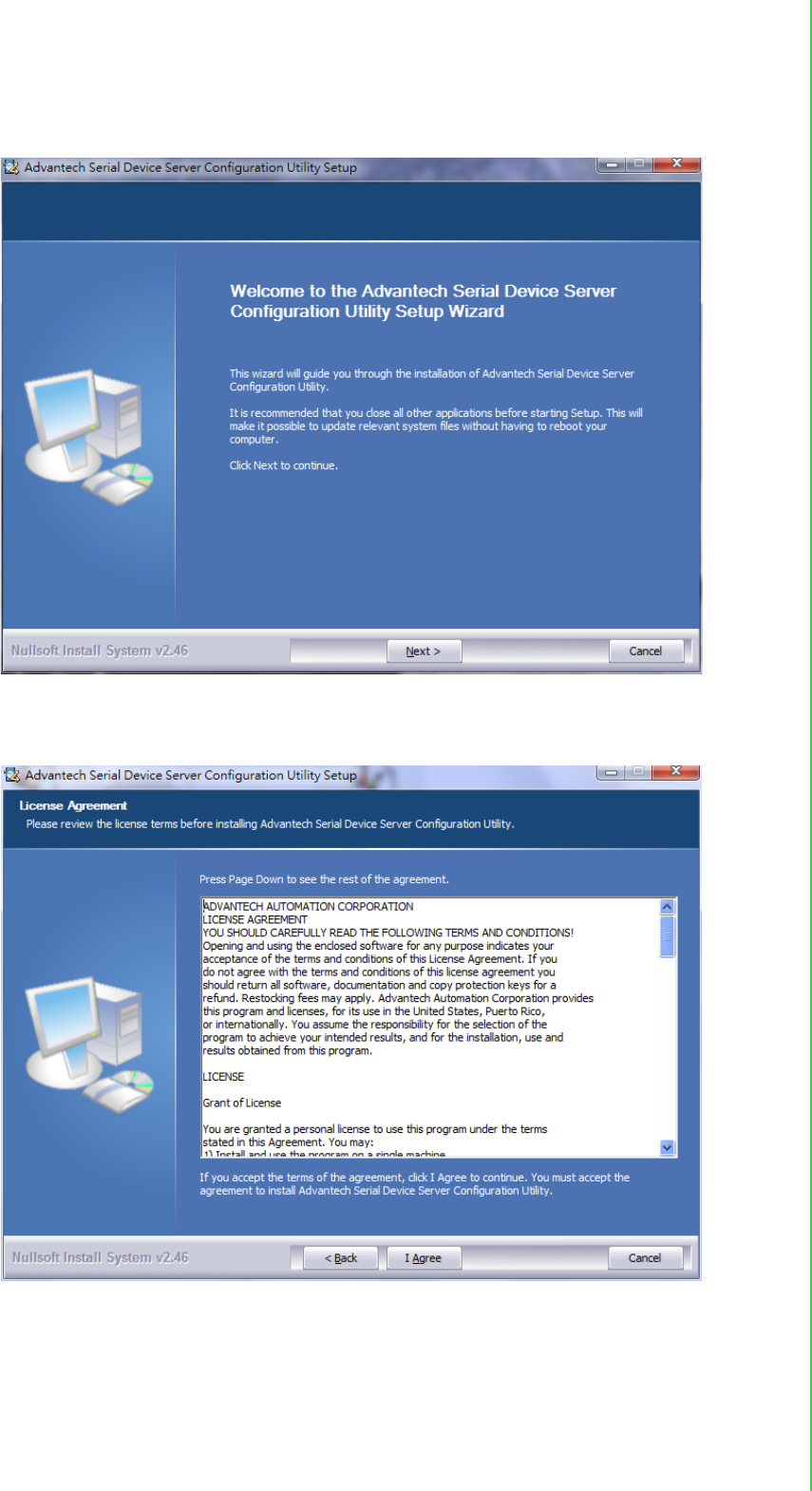
19 EKI-1361/EKI-1362 User Manual
Chapter 2 Getting Started
3. Upon executing the setup program, the Welcome Dialog Box will be pop-up.
Press the "Next" button to continue.
4. Carefully read the Software License Agreement, and press "Yes" to continue.
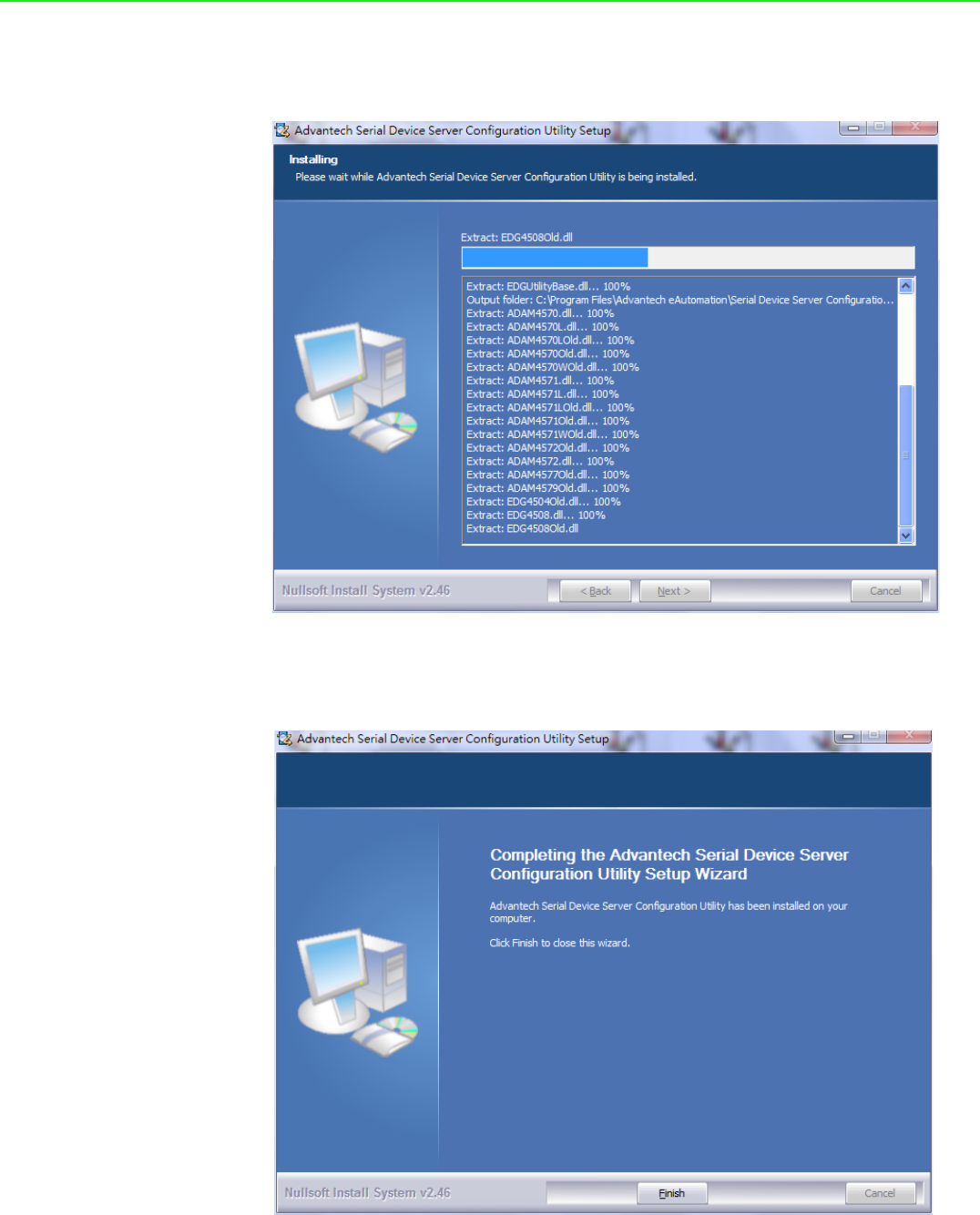
EKI-1361/EKI-1362 User Manual 20
5. The Setup program will specify a default installation path: C:\Program
Files\Advantech eAutomation\Serial Device Server Configuration Utility\
6. After setup has copied all program files to your computer, click the <Finish> but-
ton to finish the installation.

Chapter 3
3Configuration
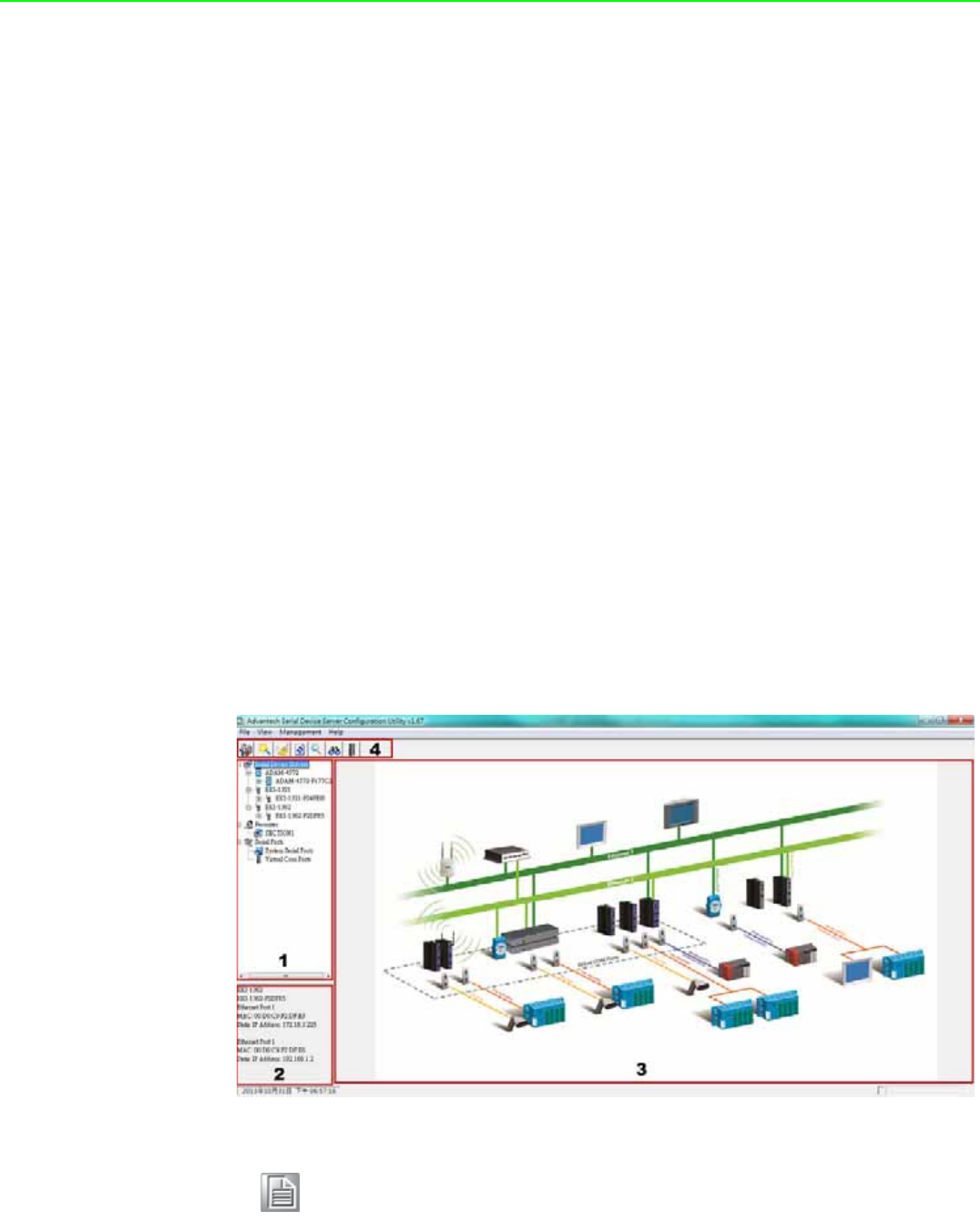
EKI-1361/EKI-1362 User Manual 22
3.1 Configuration Utility Overview
Advantech provides an easy-to-use utility to configure the serial device servers
through an Ethernet connection. User can use the utility to search or locate the
device and configure it, even don't know the exactly ip address of the device.
Advantech Serial Device Server Configuration Utility is an excellent device server
management tool. You can connect and configure the local and remote Advantech
serial device servers easily. Moreover, Virtual COM port will be enabled in the same
utility.
You may open the Serial Device Server Configuration Utility from the Windows Start
Menu by clicking Start
Æ
All Programs
Æ
Advantech eAutomation
Æ
Serial
Device Server Configuration Utility. The Serial Device Server Configuration Utility
will appear as below.
There are four major areas in the serial device server configuration utility.
1. Serial Device Server List Area: All devices will be searched and listed in this
area. You can arrange different favorite group and virtual COM ports.
2. Serial Device Server Information Area: Click on the serial device server or move
cursor to the serial device server, the related information will be shown on this
area.
3. Configuration Area: Click on the item on the Device Server List Area, the
configuration page will display on the area.
4. Quick Tool Bar: Useful management functions shortcut.
Note! Please reserve TCP/UDP port 5048 and 5058 in your Ethernet network,
configuration utility will use these ports to communicate with Advantech
EKI-1000, ADAM-4570, and EDG-4500 serial device servers.
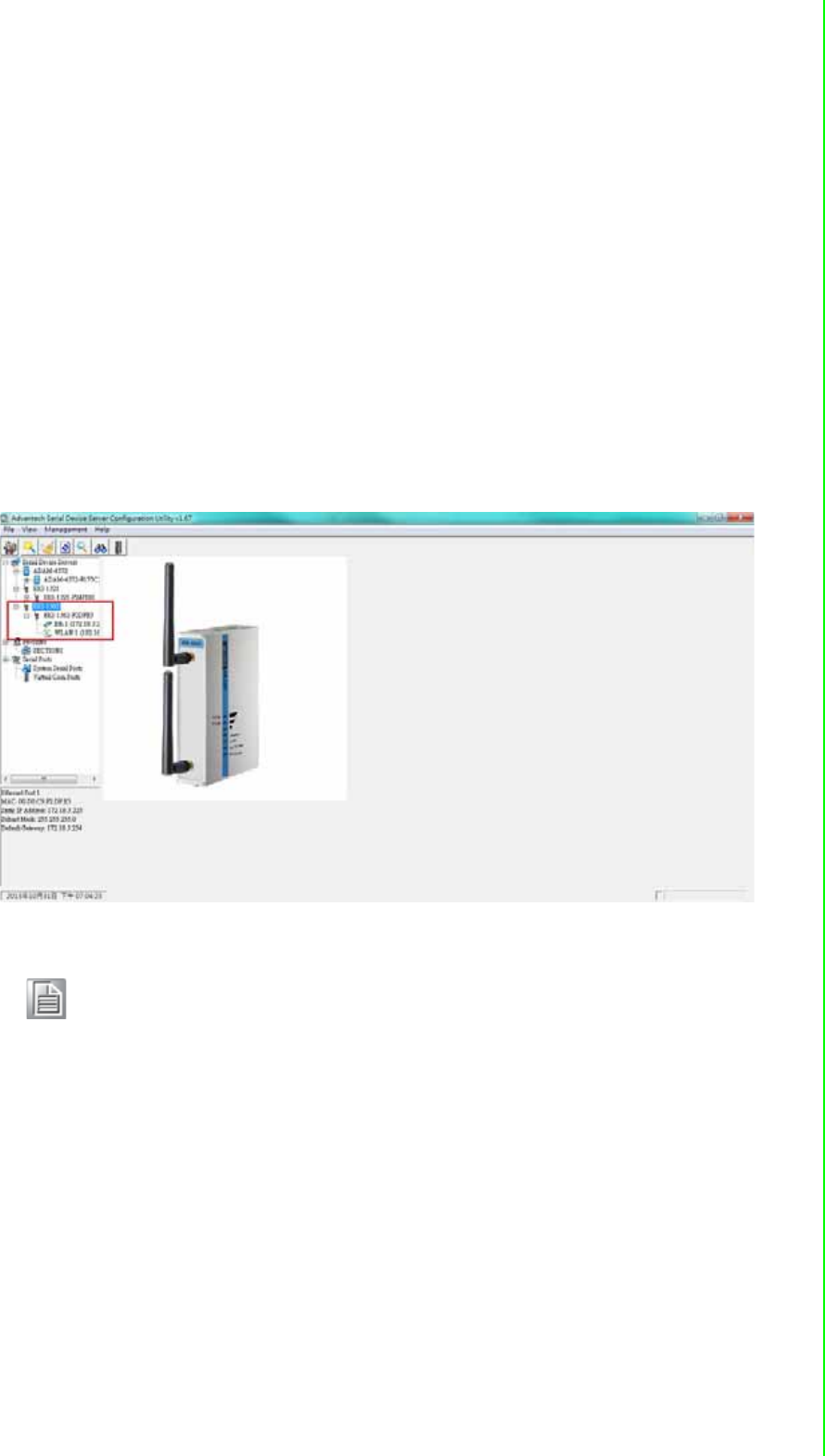
23 EKI-1361/EKI-1362 User Manual
Chapter 3 Configuration
3.2 Discovering Serial Device Servers
3.2.1 Auto Searching
Advantech Serial Device Server Configuration Utility will automatically search all the
EKI-1000, ADAM-4570 and EDG-4500 series device servers on the network and
show them on the Serial Device Server List Area of the utility. The utility provides an
auto-search function to show your device(s) by simply executing the configuration
utility program from the Start Menu.
From here all device on the same network domain will be searched and display on
Device Server List Area. You can click on the device name to show the features of
the specific device. Click on the “+” before the model name, and the utility will expand
the tree structure to show the individual device name. Click on the “-” before the
model name, and the utility will collapse the tree structure.
Note! The default device name shown in the Configuration Utility will be the
device model name appended with last 3 bytes of MAC address. You
can change to a meaningful name for identification.
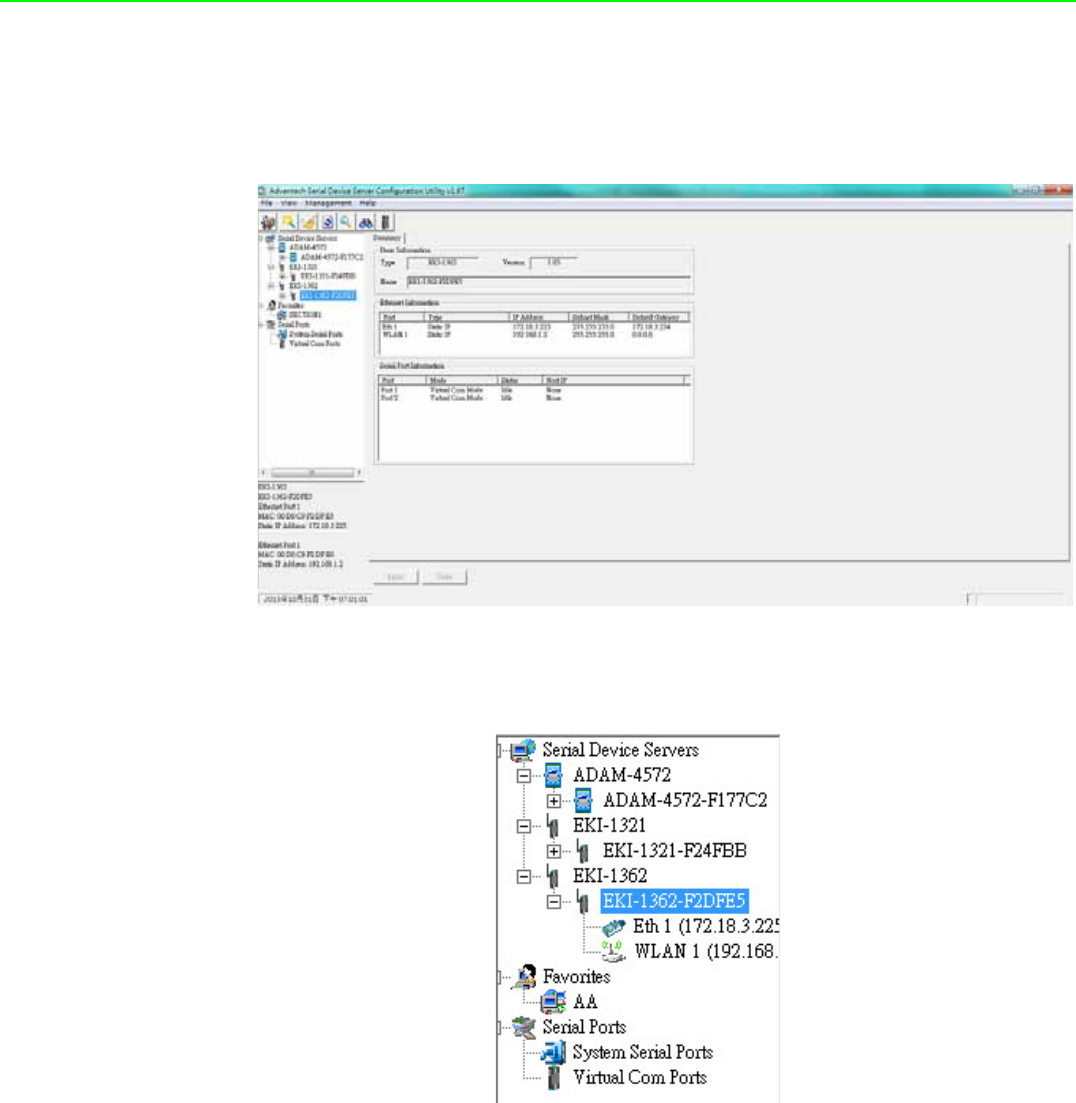
EKI-1361/EKI-1362 User Manual 24
Select the device in this sub-tree. The first tab on the “Configuration Area” shows the
summary of “Basic Information” included device type, version, and name, “Ethernet
Information”, and “Serial Port Information”. In the serial port information frame, it dis-
plays the operation mode, status and connected host IP.
Click on the “+” before the device name, and the utility will expand the interfaces on
this device server.
Click on each item, you will entry the configuration page to change the setting. The
configuration will be introduced on following sections.
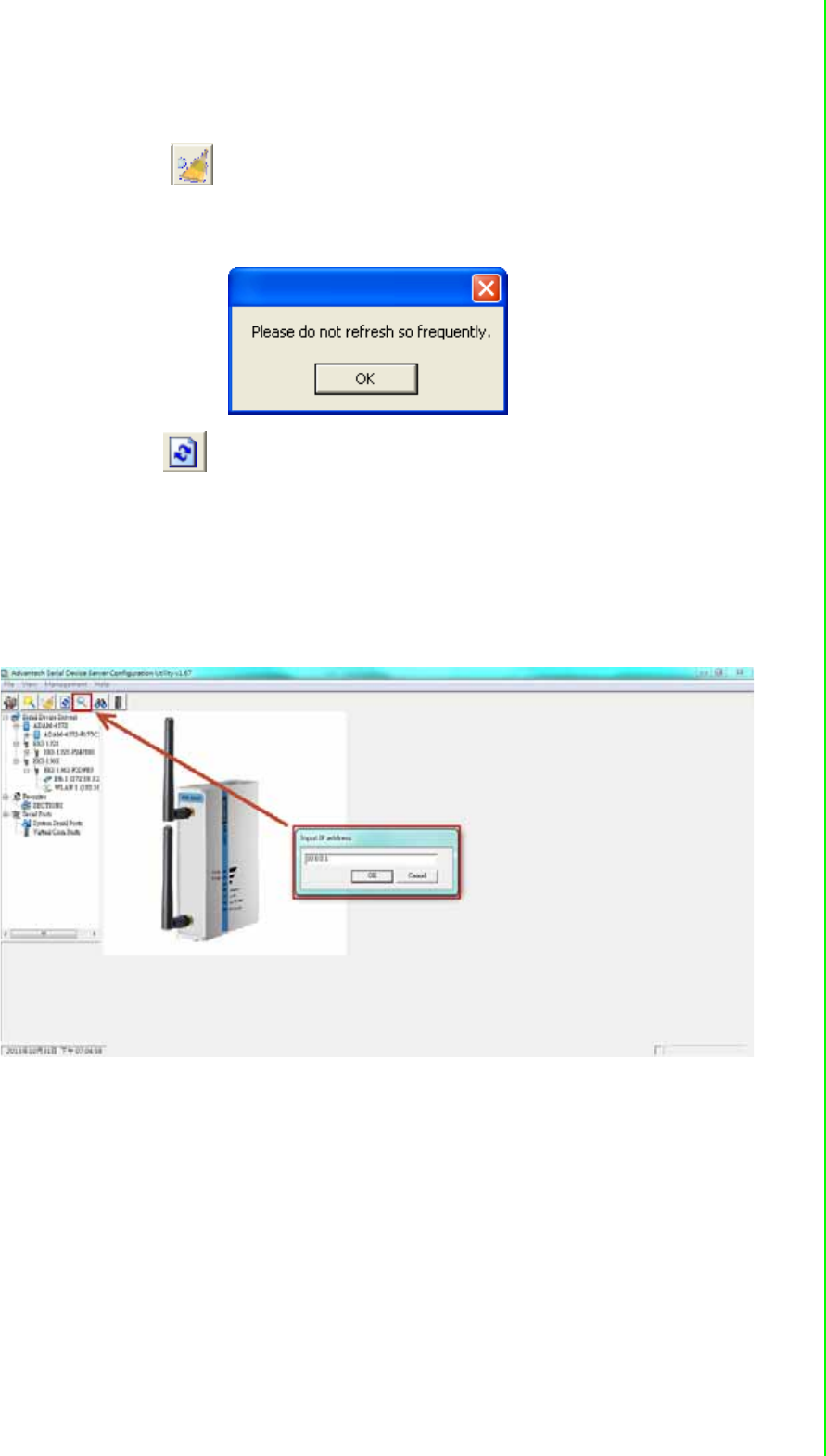
25 EKI-1361/EKI-1362 User Manual
Chapter 3 Configuration
3.2.2 Clear Device List and Search Again
You can click the button on the Quick Tool Bar. The utility will clear all list
device servers in the Serial Device Server List Area and re-search again. Don’t use
this function frequently. The warning message will be pop-up when you double click
this button.
You can click the button on the “Quick Tool Bar”. The utility will search serial
device server on local LAN.
3.2.3 Manual Appending
Using “Add IP address to Favorite” or “Search a Range of IP addresses” function,
you are able to add one device or group of devices to “Favorites”. These devices can
locate on local network domain or other network domain.
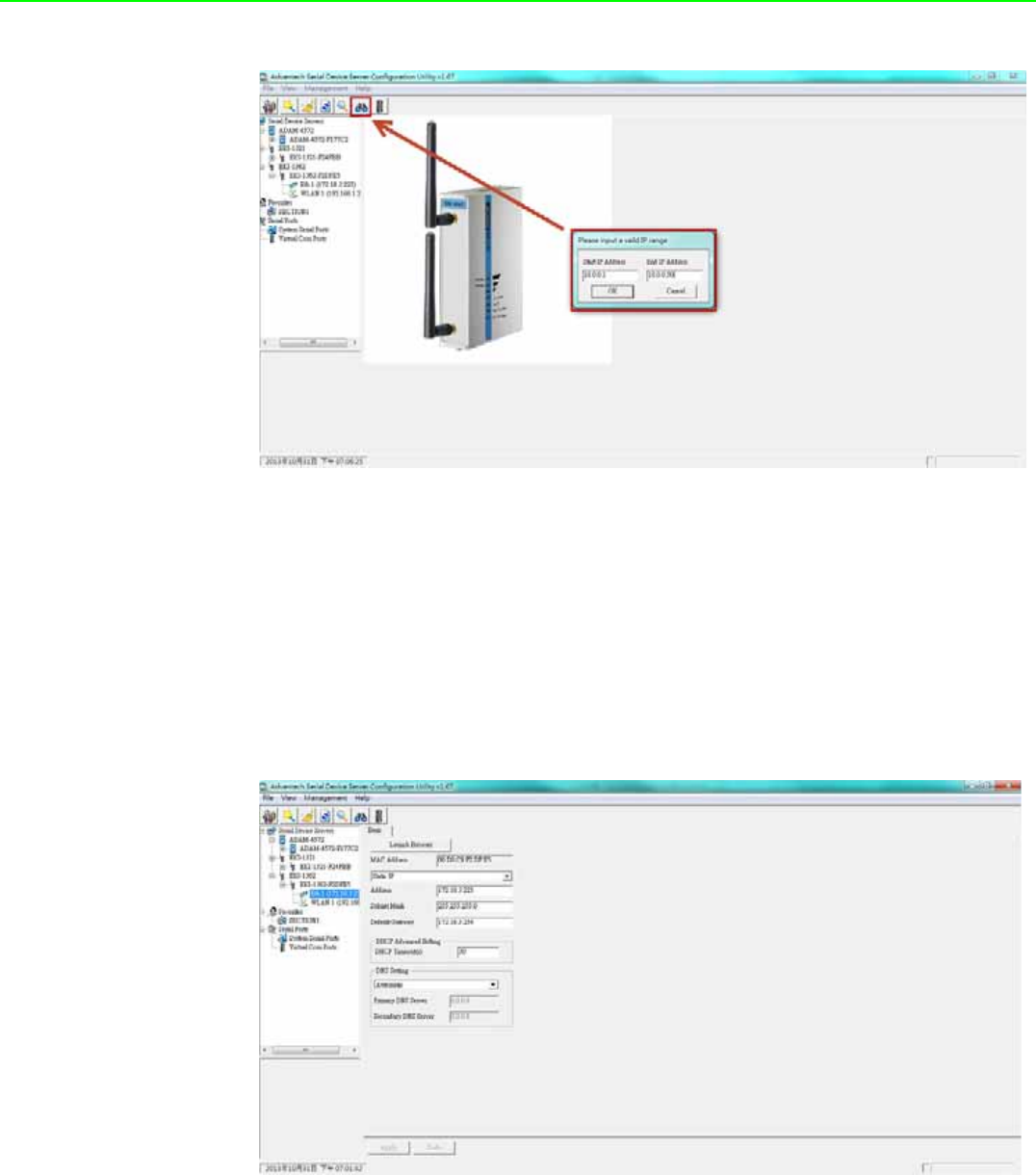
EKI-1361/EKI-1362 User Manual 26
3.3 Network Settings
This section explains how to configure the network setting of EKI device using this
utility so that it can communicate over a network with serial devices.
Click on the “+” before the model name, and the utility will expand the tree structure
to show the individual device name. And click on the “+” before the device name, and
the utility will expand the interfaces on this device server. Select the Ethernet
interface. (Select Eth1 or Eth2, these are two individual Ethernet ports)
MAC address:
The MAC address is for the local system to identify and locate each serial device
servers. This MAC address is already set before delivery from factory, hence no need
for further configuration.
IP address, Subnet Mask, Default Gateway:
You can choose from four possible IP Configuration modes --- Static,DHCP,
BOOTP, and DHCP/BOOTP.
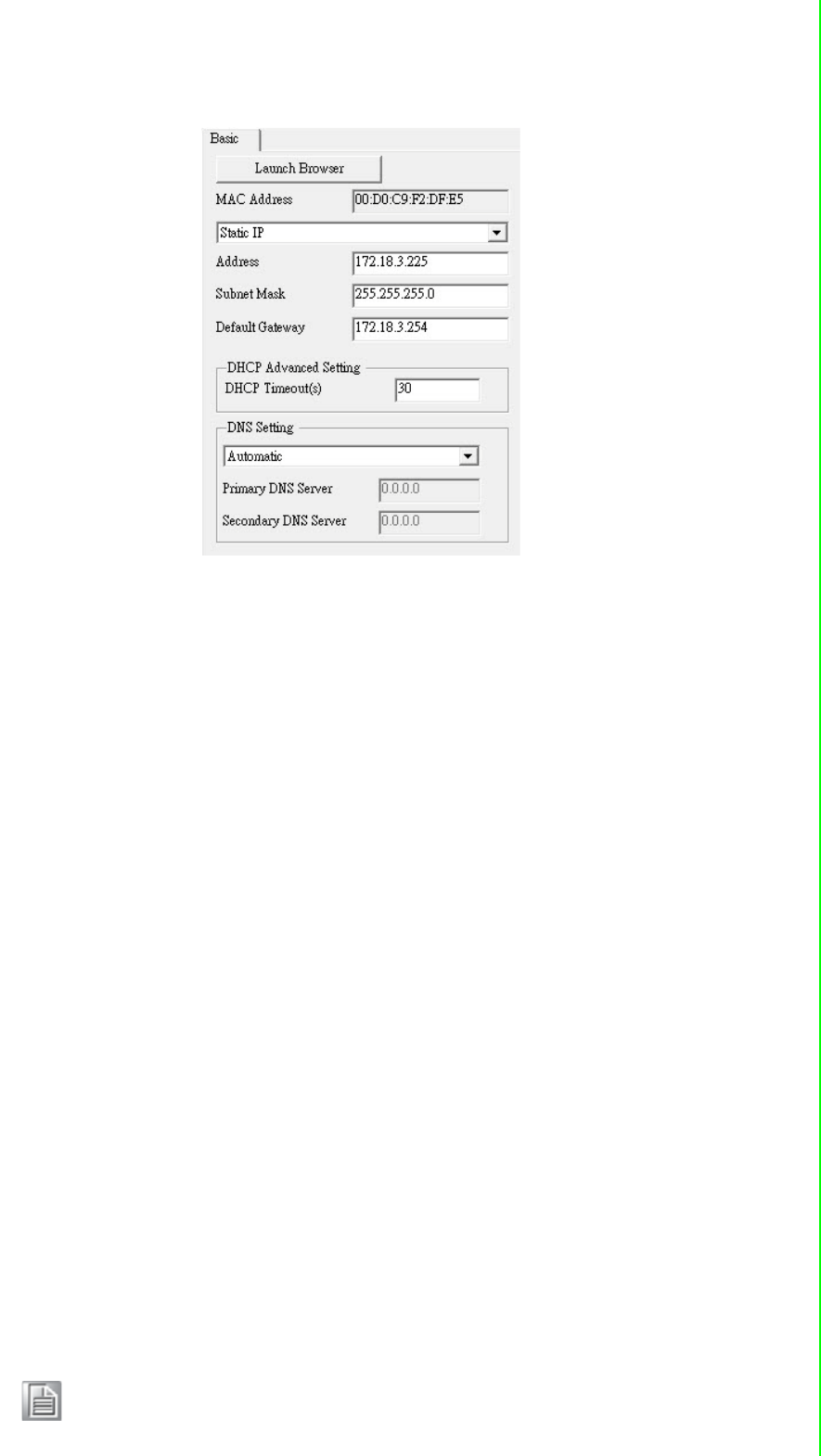
27 EKI-1361/EKI-1362 User Manual
Chapter 3 Configuration
Static IP
User defined IP address, Subnet Mask, and Default Gateway.
DHCP + Auto-IP
DHCP Server assigned IP address, Subnet Mask, Default Gateway, and DNS.
BOOTP + Auto-IP
BOOTP Server assigned IP address.
DHCP + BOOTP + Auto-IP
DHCP Server assigned IP address, Subnet Mask, Default Gateway, and DNS, or
BOOTP Server assigned IP address. (If the DHCP Server does not respond)
DHCP Timeout
When EKI device doesn't get response from DHCP server within specific timeout, the
EKI device will give up the request and take next action.
DNS Setting
In order to use DNS feature, you need to set the IP address of the DNS server to be
able to access the host with the domain name. The EKI-152X series serial device
server provides Primary DNS Server and Secondary DNS Server configuration items
to set the IP address of the DNS server. Secondary DNS Server is included for use
when Primary DNS server is unavailable.
DHCP Advanced Setting
When you enabling DHCP protocol to get IP address, it will be waited DHCP server
to give IP within DHCP timeout. The default value is 30 seconds.
Note! When you have finished the configuration of these settings for each cat-
egory, please press the “Apply” button in order to make these settings
effective on the Serial Device Server. (Will reboot your Serial Device
Server immediately)
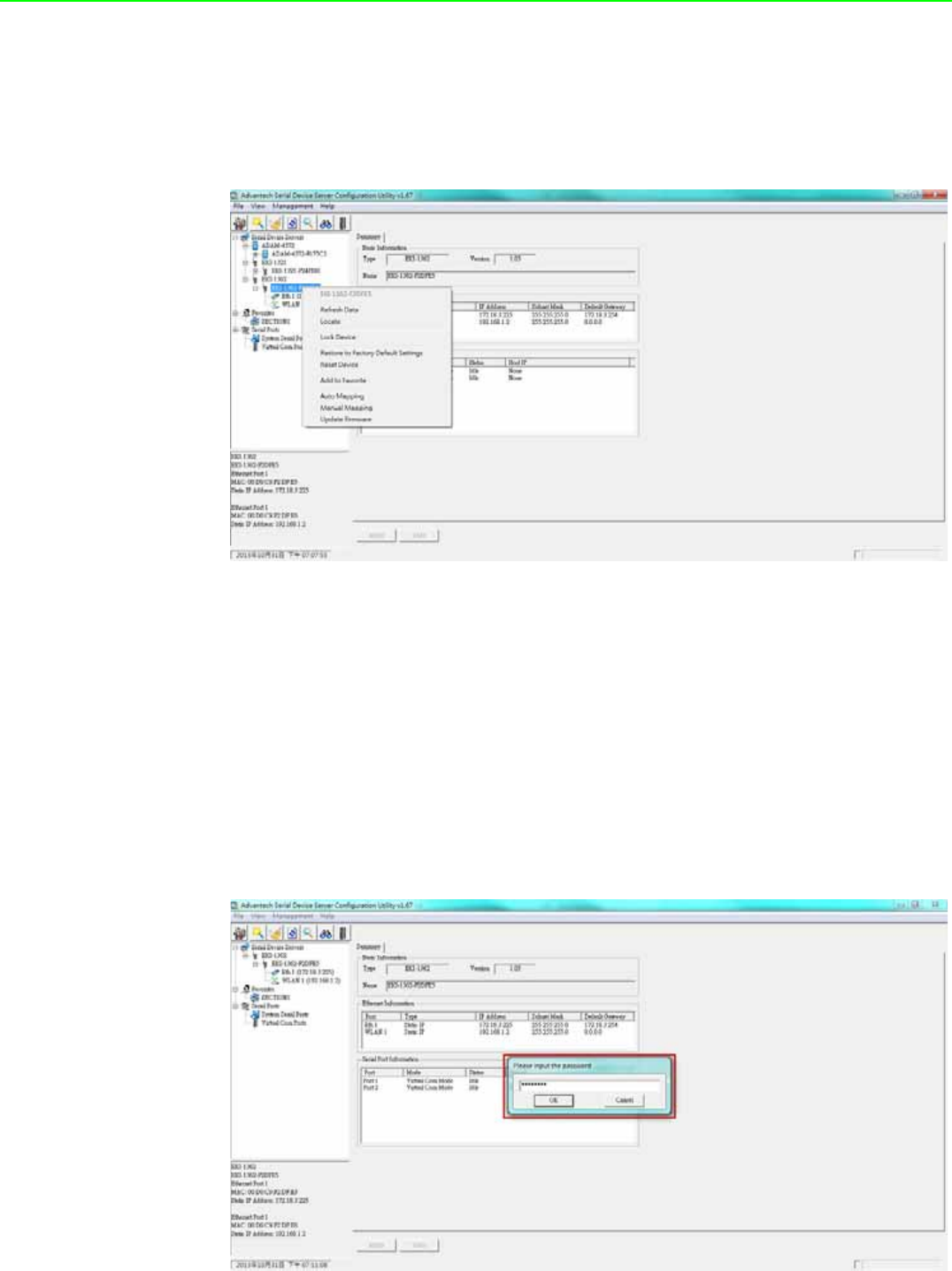
EKI-1361/EKI-1362 User Manual 28
3.4 Administrator Settings
The configuration utility provides several administrator settings for easy management
and configuration. Right click the mouse on the device name in the sub-tree of Serial
Device Sever List Area, and select these administrator settings.
3.4.1 Locate the Serial Device Server
If there are many serial device severs need your management, you may need to
identify which unit is correct to configuration on utility. Click “Locate” to make that
unit’s “Status” LED be steady on and the buzzer will make the beep sound until you
click “Stop Locate”.
3.4.2 Lock the Serial Device Server (Password Protection)
The configuration utility provides the “Lock Device” function to make it more confiden-
tial. You need to set up a password while the first time clicking “Lock Device”. Be sure
to click “Reset Device” to restart the serial device server and store your setting pass-
word into the memory.
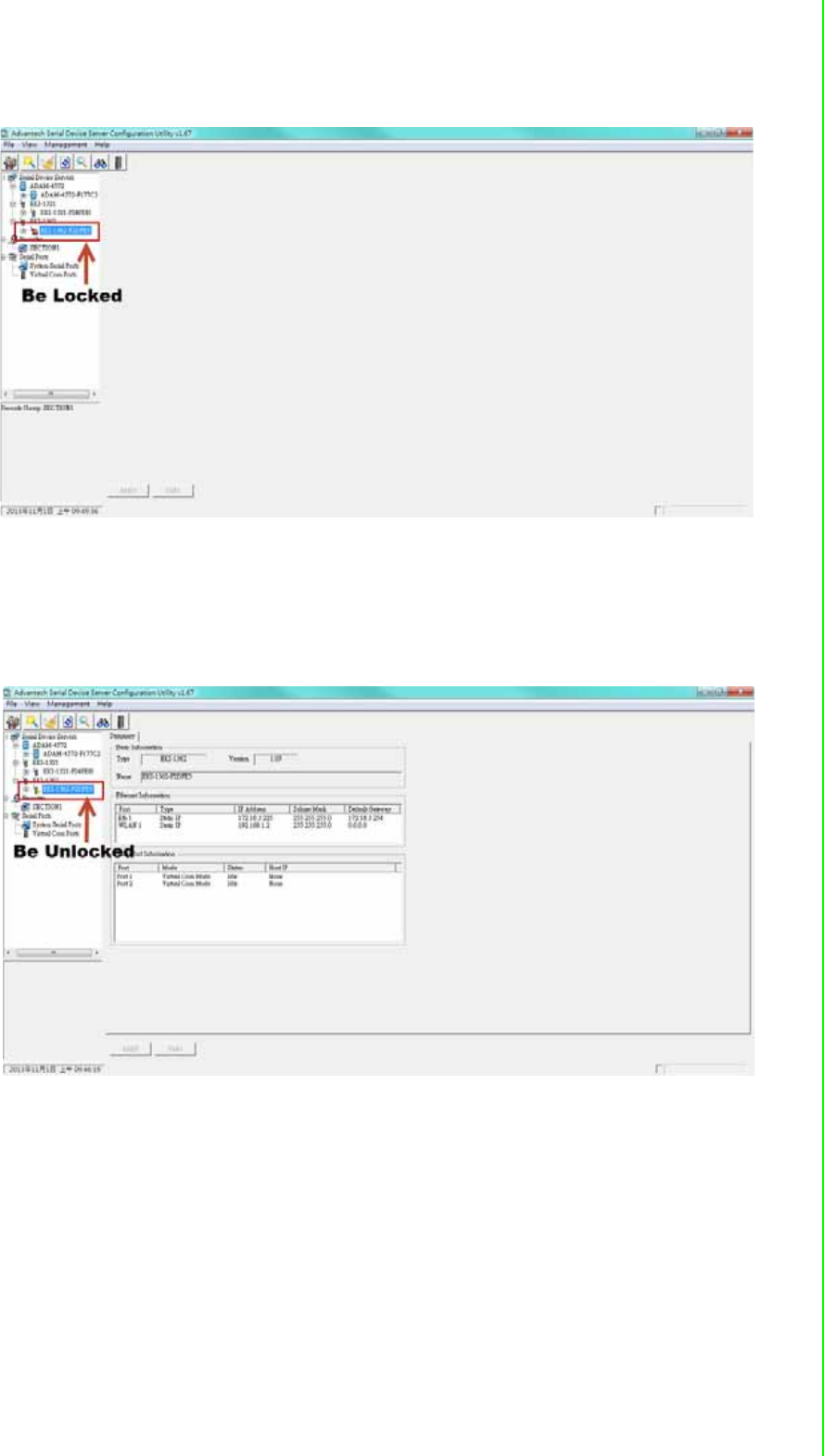
29 EKI-1361/EKI-1362 User Manual
Chapter 3 Configuration
Click “Unlock Device” to unlock the serial device sever, and you need to fill in the
password you have set up before. If you forgot the password, the only way to solve
this problem is to restore the setting of the serial device server to the factory default
which will be introduced next section.
If you want to disable this function or change the password, click “Change Password”
to change the password to default “None” (leave the new password and confirm new
password columns blank) to disable this function or other password you want to
change. Be sure to click “Reset Device” to restart the serial device sever and store
the new password into the memory.
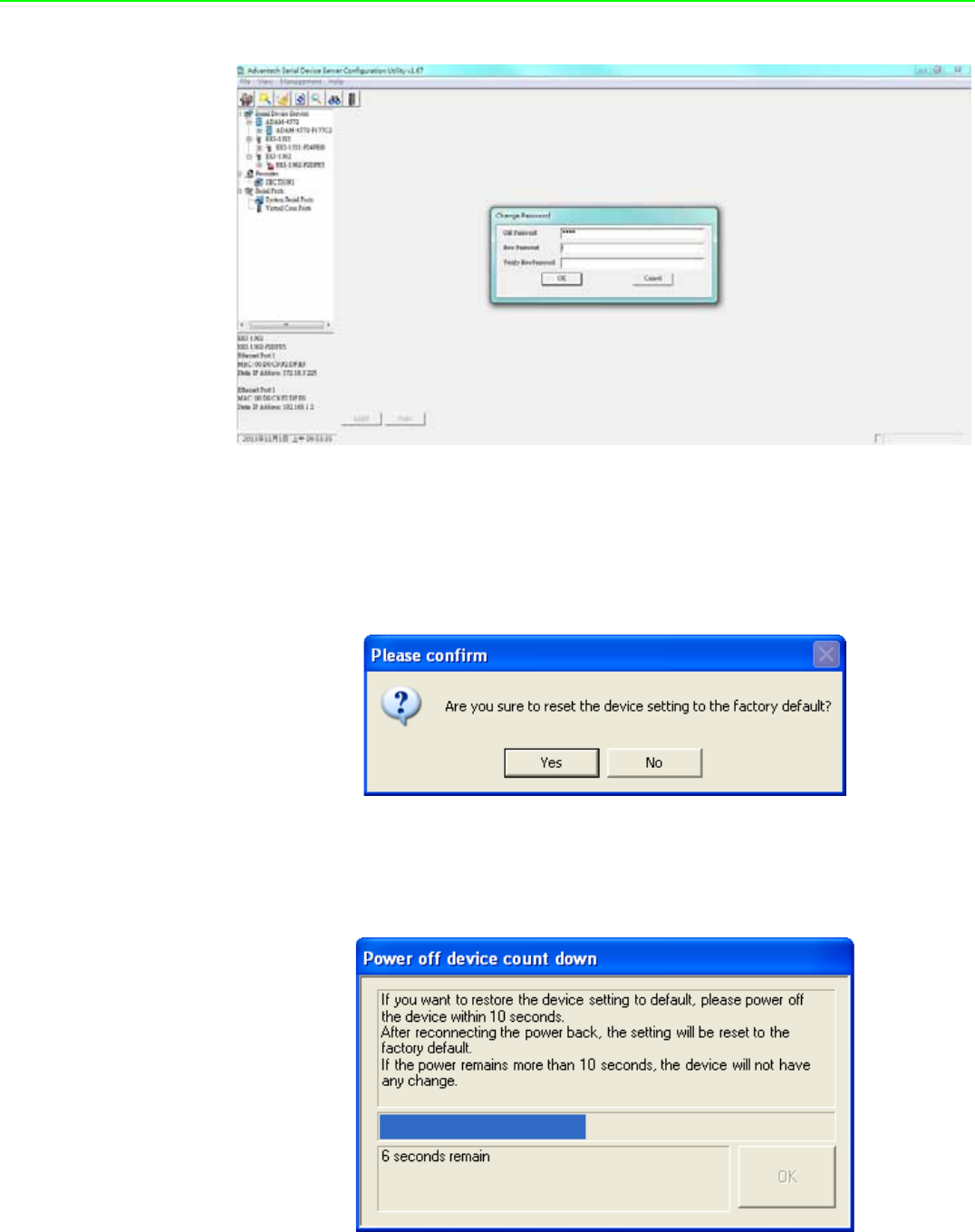
EKI-1361/EKI-1362 User Manual 30
3.4.3 Restore to Factory Default Settings
The configuration utility provides this function to let you can restore the serial device
server to factory default settings. The confirm message will be pop-up while clicking
“Restore to Factory Default Settings”. If you really want to restore the serial device
sever to factory default settings, please click “Yes” button to continue.
Then, please power off the serial device server within ten seconds, after reconnect-
ing the power back, the all setting will be reset to the factory default. If the power
remains more than ten seconds, the serial device server will not have any changes.
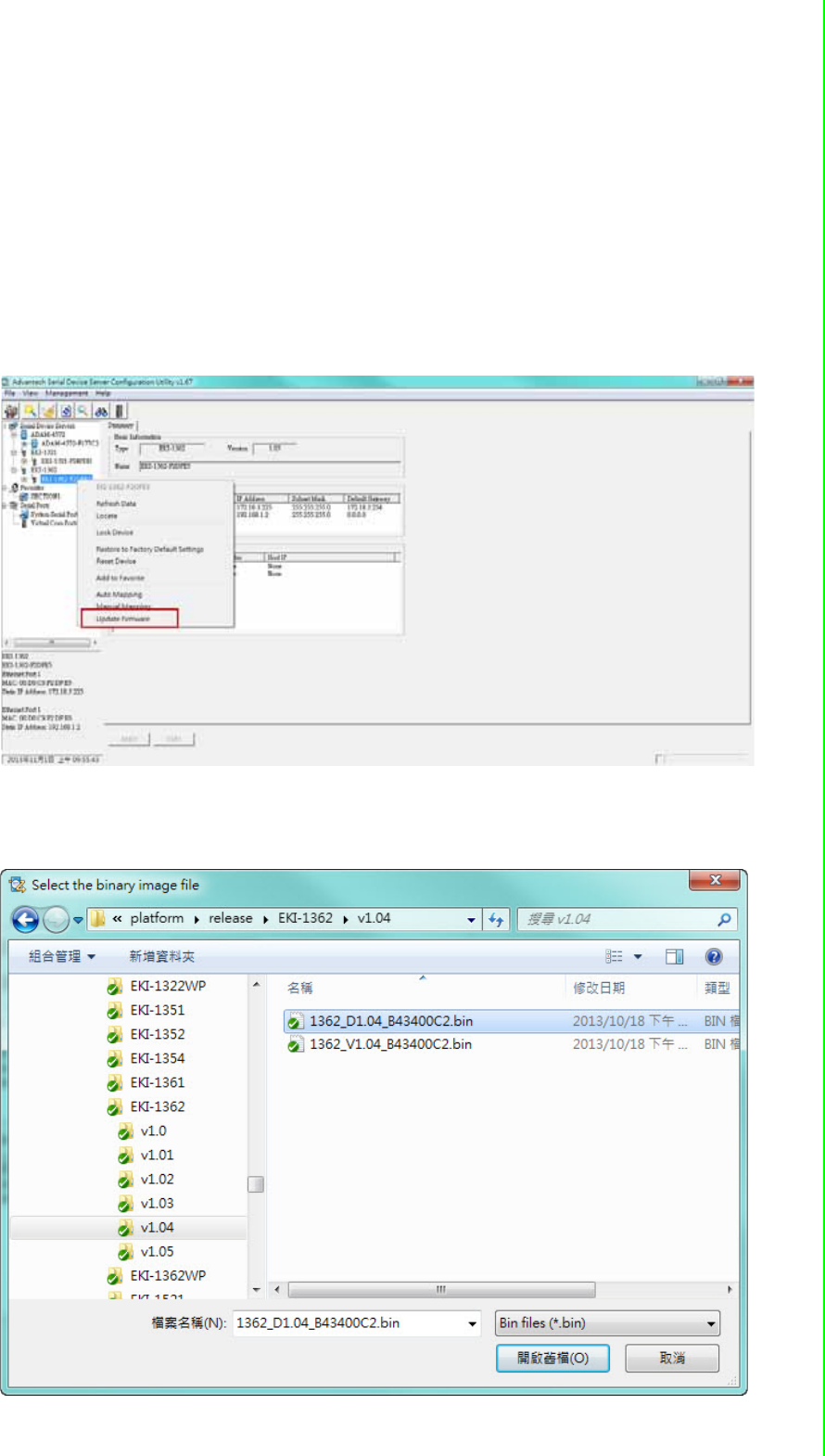
31 EKI-1361/EKI-1362 User Manual
Chapter 3 Configuration
3.4.4 Update Firmware
Advantech continually upgrades its firmware to keep up with the ever-expending
world of computing. You can use the update firmware function in the utility to carry
out the upgrade procedure. Please access Advantech’s website: http://www.advan-
tech.com to download the latest version of the firmware. Before update the firmware,
make sure that your host’s Network domain is as same as the serial device server or
the host can establish the TCP connection to the serial device server.
Right Click on the device name and select “Update Firmware” function.
Select the firmware file you want to update.
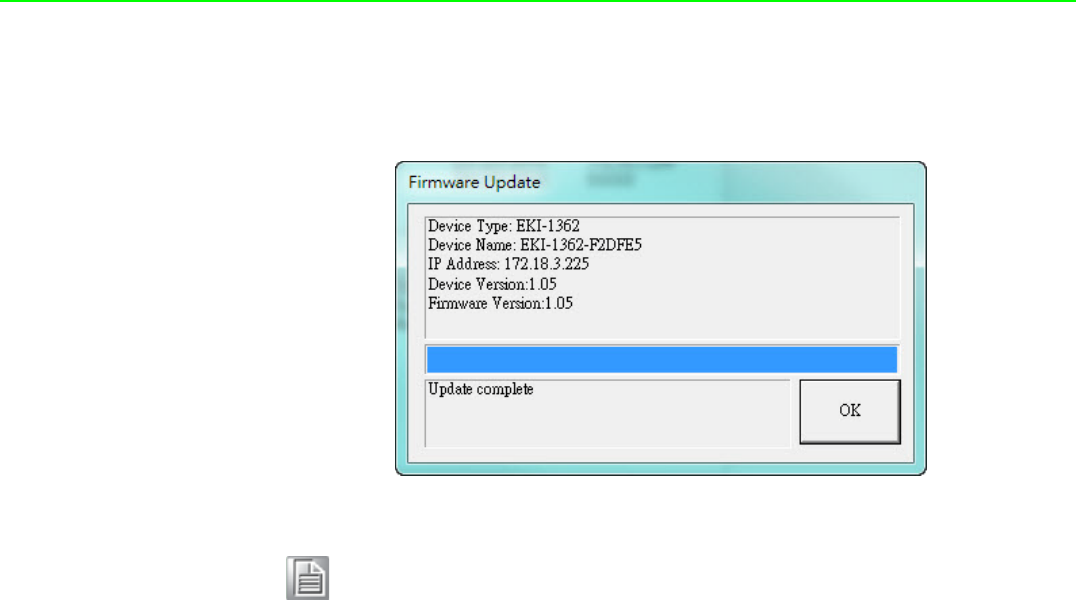
EKI-1361/EKI-1362 User Manual 32
Wait for few seconds to process the updating firmware. After downloading the firm-
ware completely, click on the “OK” button. The serial device server will restart auto-
matically.
Note! Be sure that the host PC Ethernet network domain is as same as the
serial device server or the host PC can establish the TCP connection
with the serial device server while doing the updating firmware process.

Chapter 4
4Setting COM
Redirector
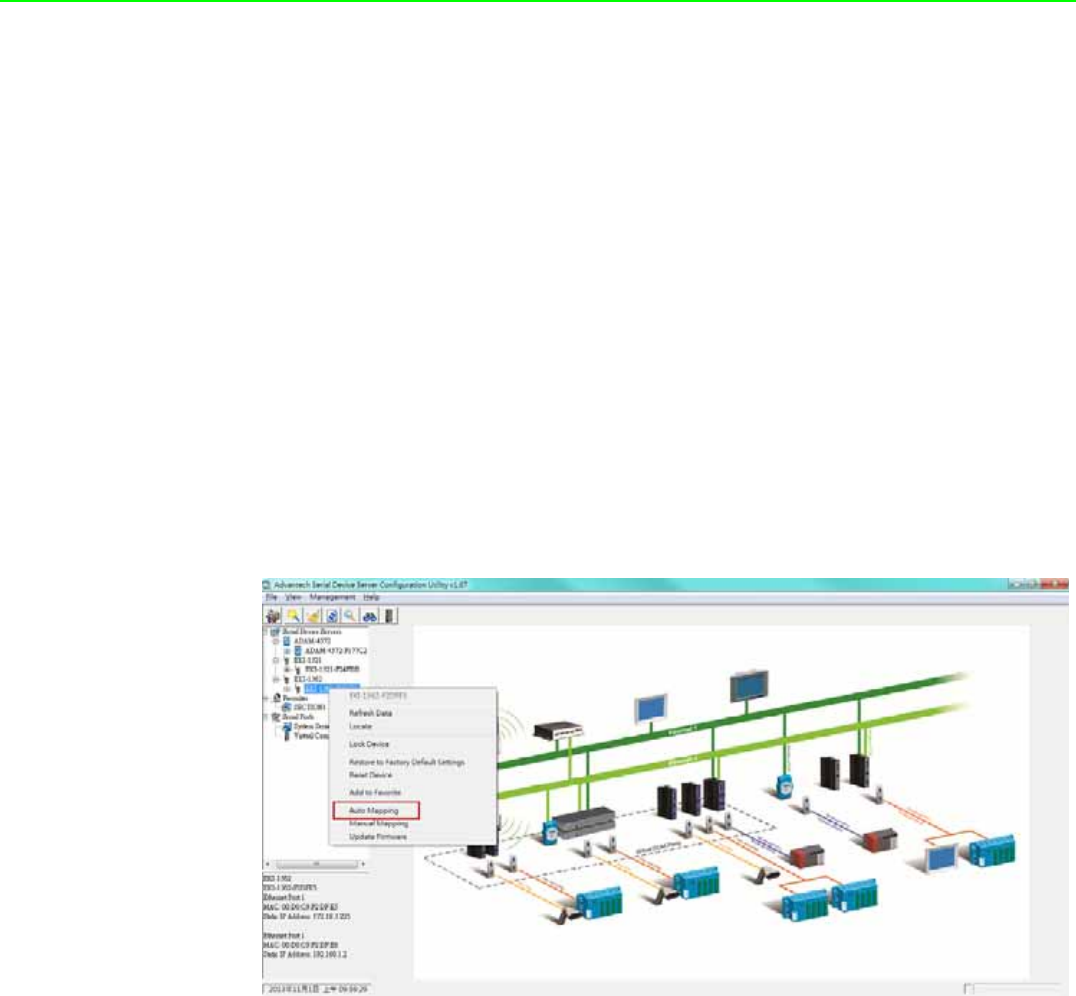
EKI-1361/EKI-1362 User Manual 34
4.1 Setting COM Redirector (Virtual COM port)
Advantech COM port mapping software is a serial COM port redirector that creates
virtual COM ports and provides access to serial devices connected to Advantech
serial device servers. Your serial device applications can communicate with serial
devices connected to Advantech serial device servers without software changes.
Since the virtual COM ports work like standard Windows COM ports, your application
software sees no difference between a local serial device and one connected to a
Advantech serial device server.
COM redirector utility and Virtual COM port Management utility are integrated into
one utility with same GUI. Advantech Serial Device Server Configuration Utility can
create all Virtual COM ports using “Auto Mapping” function. You can map the Virtual
COM port by yourself.
4.1.1 Auto Mapping
Right click the serial device name on the sub-tree of Device Server List area and
select the “Auto Mapping” function.
The serial ports that can be assigned to virtual COM will be shown in this window.
Select the serial ports you wish to map or click the <Select All> button and press
<Map Selected Ports> button. The selected serial ports will be mapped to virtual
COM ports in sequential order.
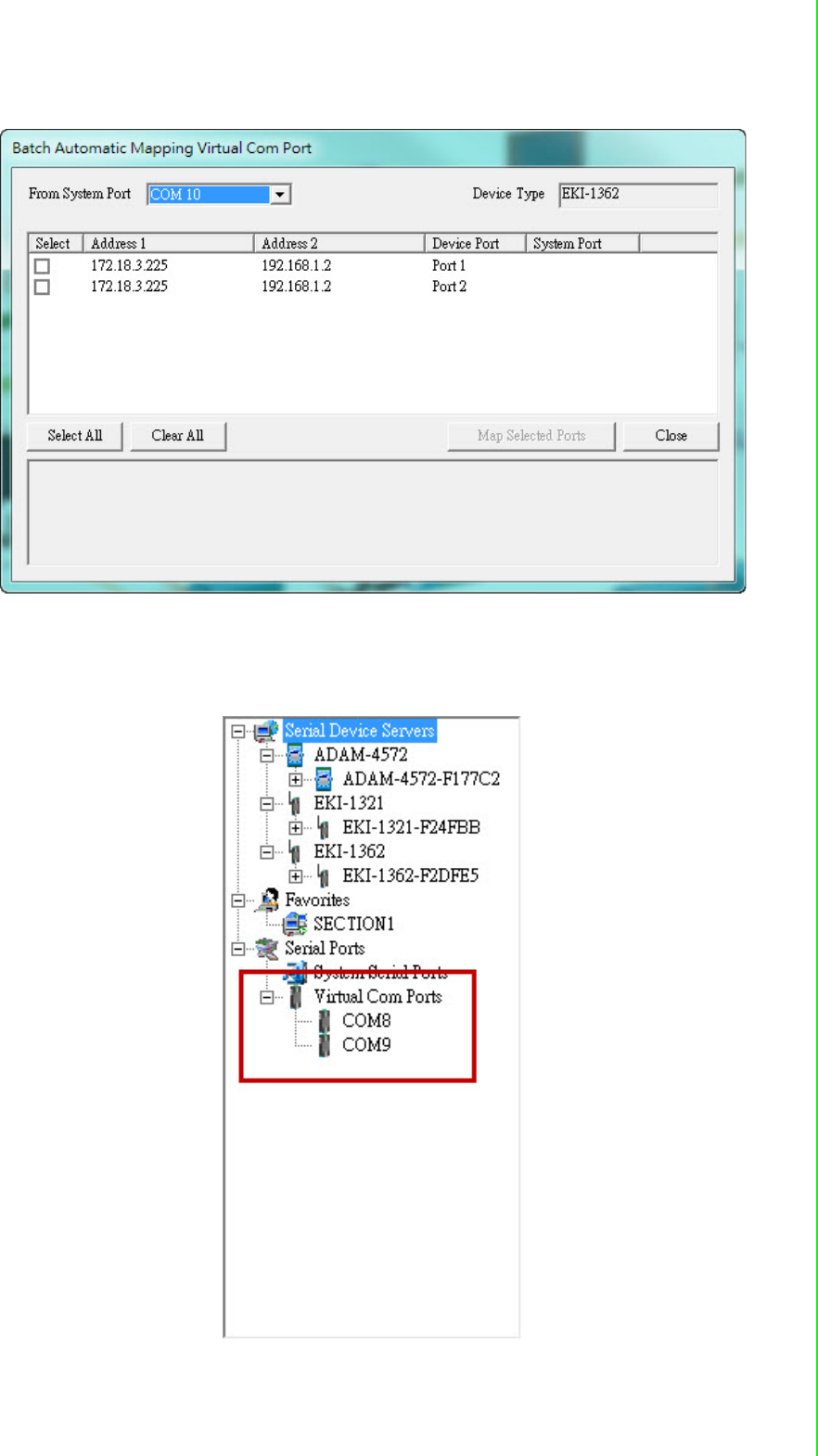
35 EKI-1361/EKI-1362User Manual
Chapter 4 Setting COM Redirector
The COM ports in the “Virtual Com Ports” listing are now available for use by Win-
dows applications.
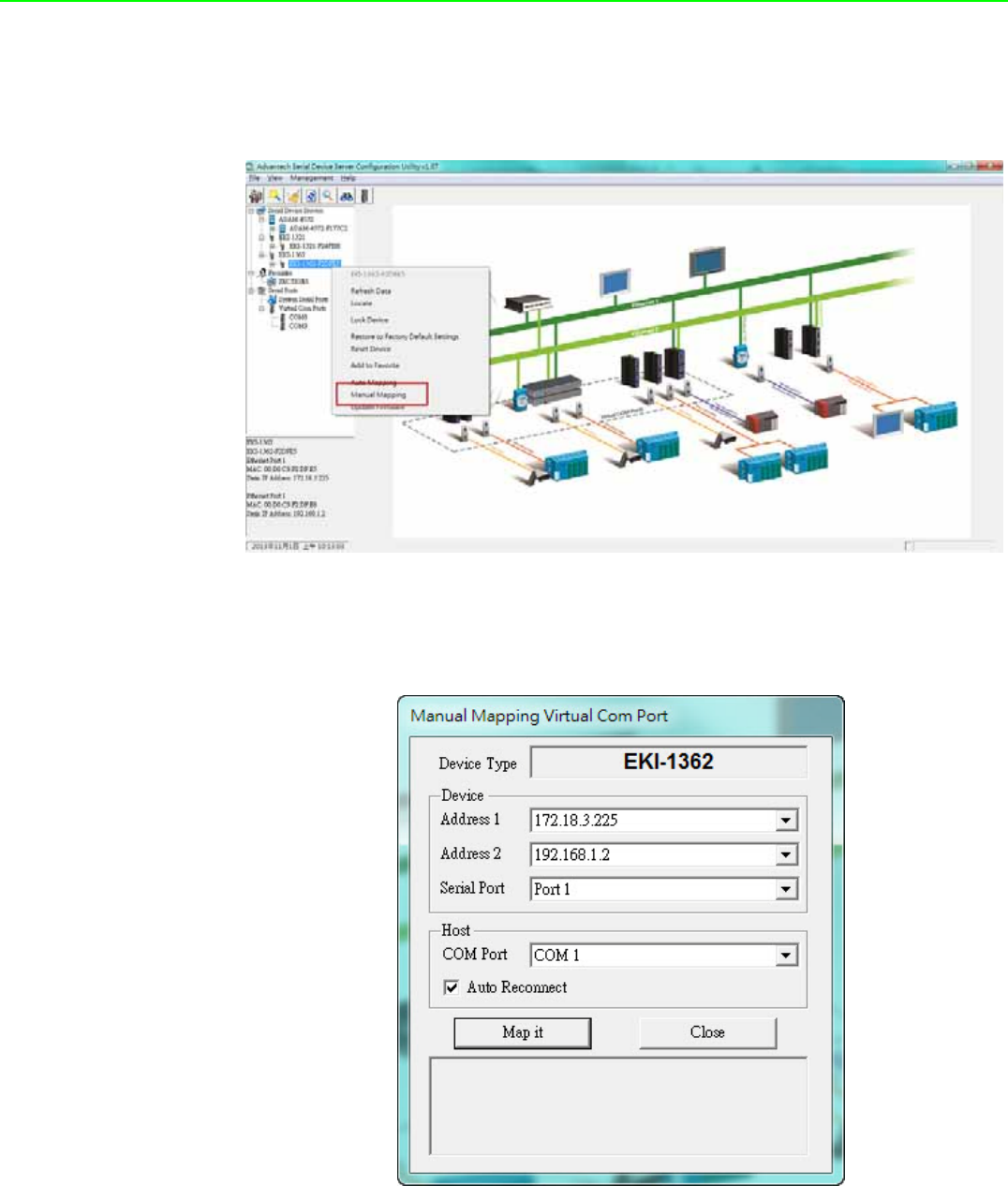
EKI-1361/EKI-1362 User Manual 36
4.1.2 Manual Mapping
Right click the serial device name on the sub-tree of Device Server List area and
select the “Manual Mapping” function.
ADAM series, EDG series, and EKI wireless series have only one IP address. Select
the serial port on the device server and the host COM that you want to set. Press
<Map it> to establish the virtual COM port on the host.
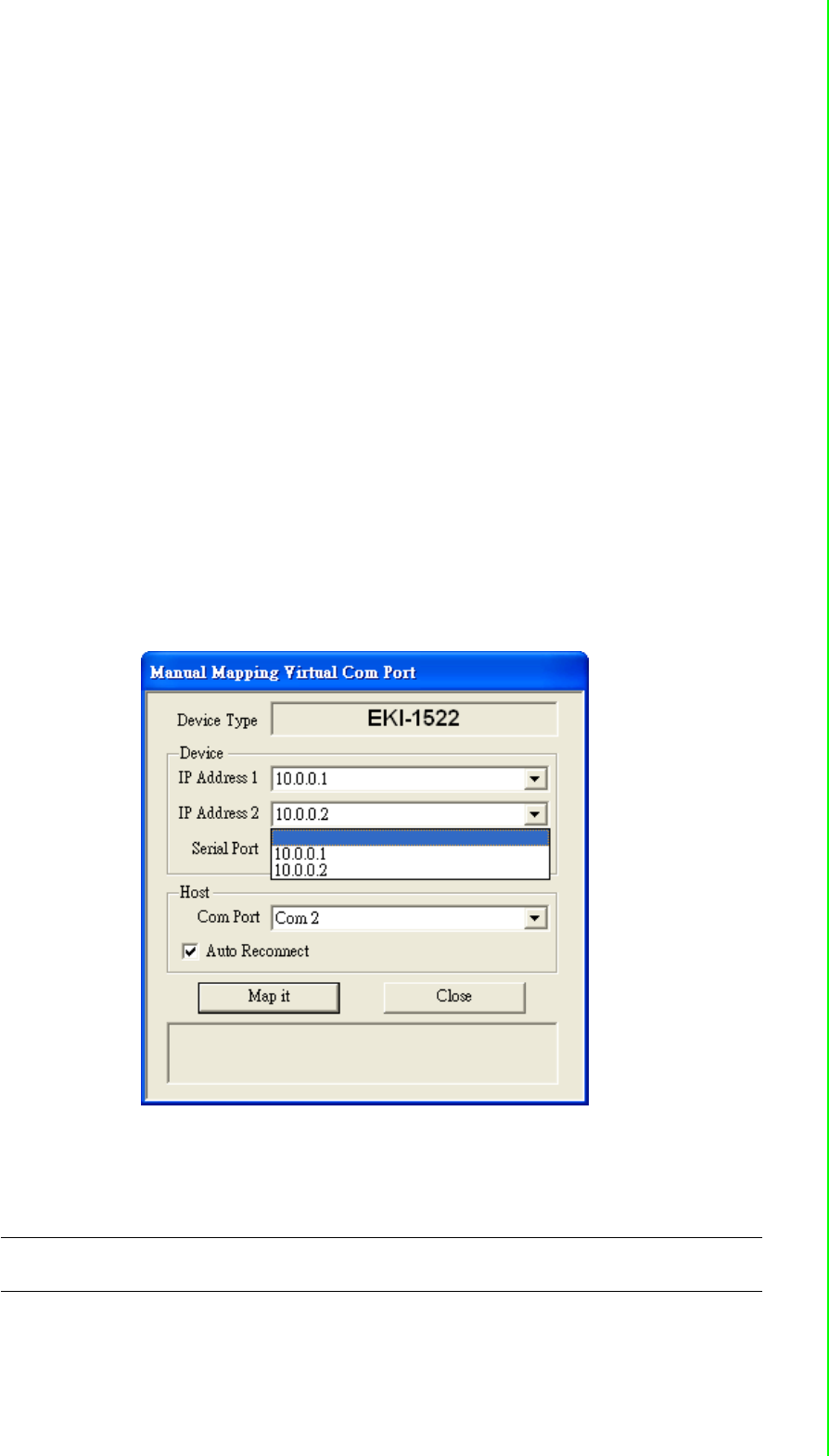
37 EKI-1361/EKI-1362User Manual
Chapter 4 Setting COM Redirector
Auto Reconnect Property
Sometimes, the connection between Advantech serial device server and HOST is
interrupted by network traffic or powered-off by accident. In such a situation, the host
has to reconnect to Advantech serial device server. The function "Auto Reconnect" is
for this purpose, if the Advantech serial server loses the connection to its host, the
COM redirector will try to re-establish the connection while the host’s AP access the
virtual COM port. The COM redirector DOES NOT re-establish the connection auto-
matically. When the connection is working again, the host's commands will be auto-
matically received by the Advantech serial device server again. Reconfiguration is
not necessary, so this function enhances the reliability of the system.
If the function is disabled, the connection can not be re-established again unless the
COM redirector or host is restarted.
Serial device server has two Ethernet ports. You can select two Ethernet port to
establish two Ethernet connections with one virtual COM port. It means that COM
redirector will use one connection with the COM port on device server to
communicate. If this connection failed, COM redirector will establish another Ethernet
connection to communicate with device. The switch time will be 3 seconds ~ 5
seconds depending on the network traffic and host status.
If you don’t use the redundant function, just select the correct IP address in the IP
address 1 field.
Note If you set the wrong IP address, COM redirector will still try to connect the
device. It might cause the system performance low or other issue.
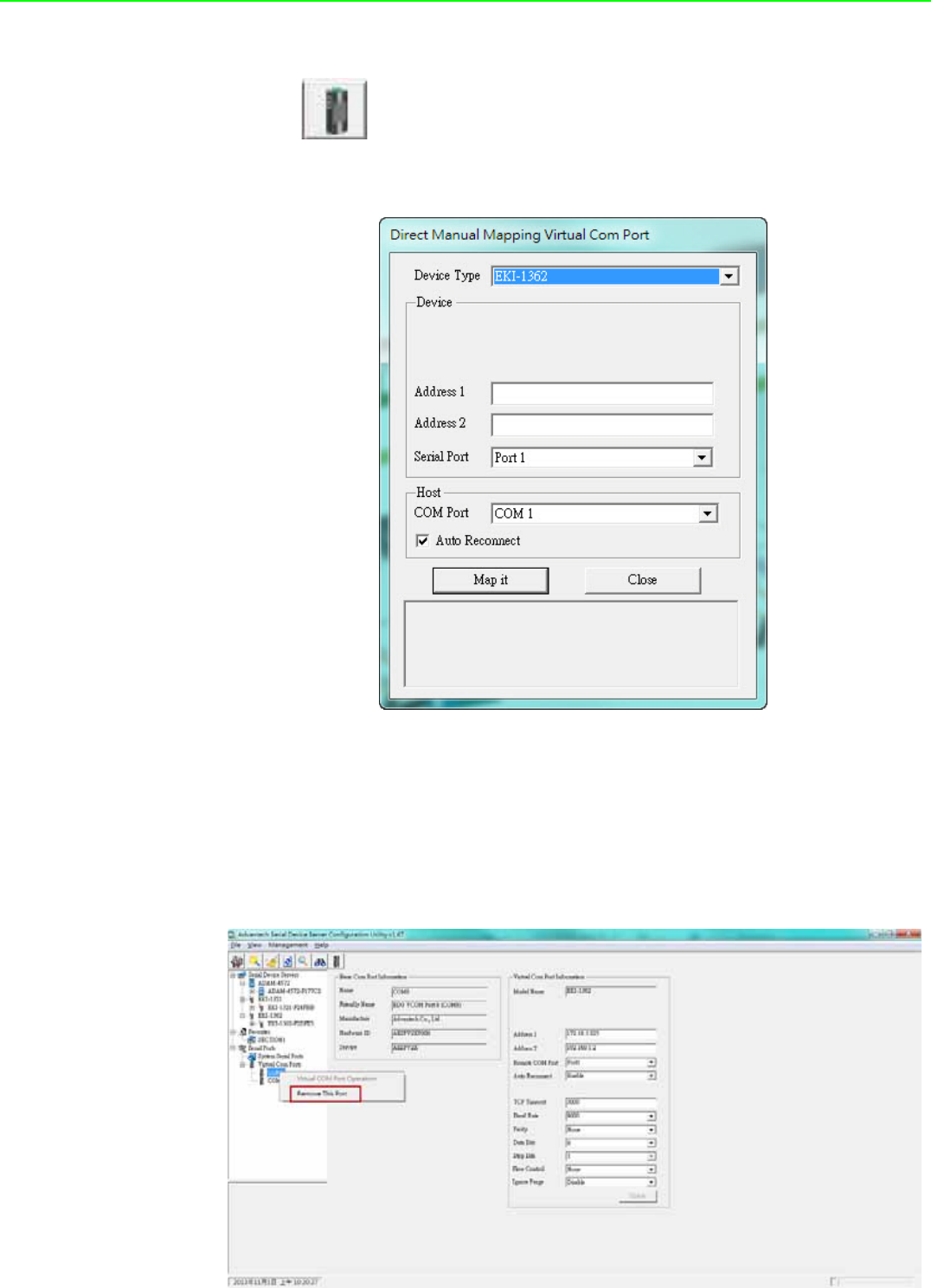
EKI-1361/EKI-1362 User Manual 38
4.1.3 Manual Direct Mapping Virtual COM Port
Click the button on the Quick Took area, you can add a target by selecting
the Device Type and inputting the IP address without physically connecting the serial
device server to the network.
4.1.4 Remove the Virtual COM Port
If you want to remove the virtual COM port, you can remove them one by one or
group remove ports.
Individually Remove
Right click on COM port you have mapped and select “Remove This Port”.
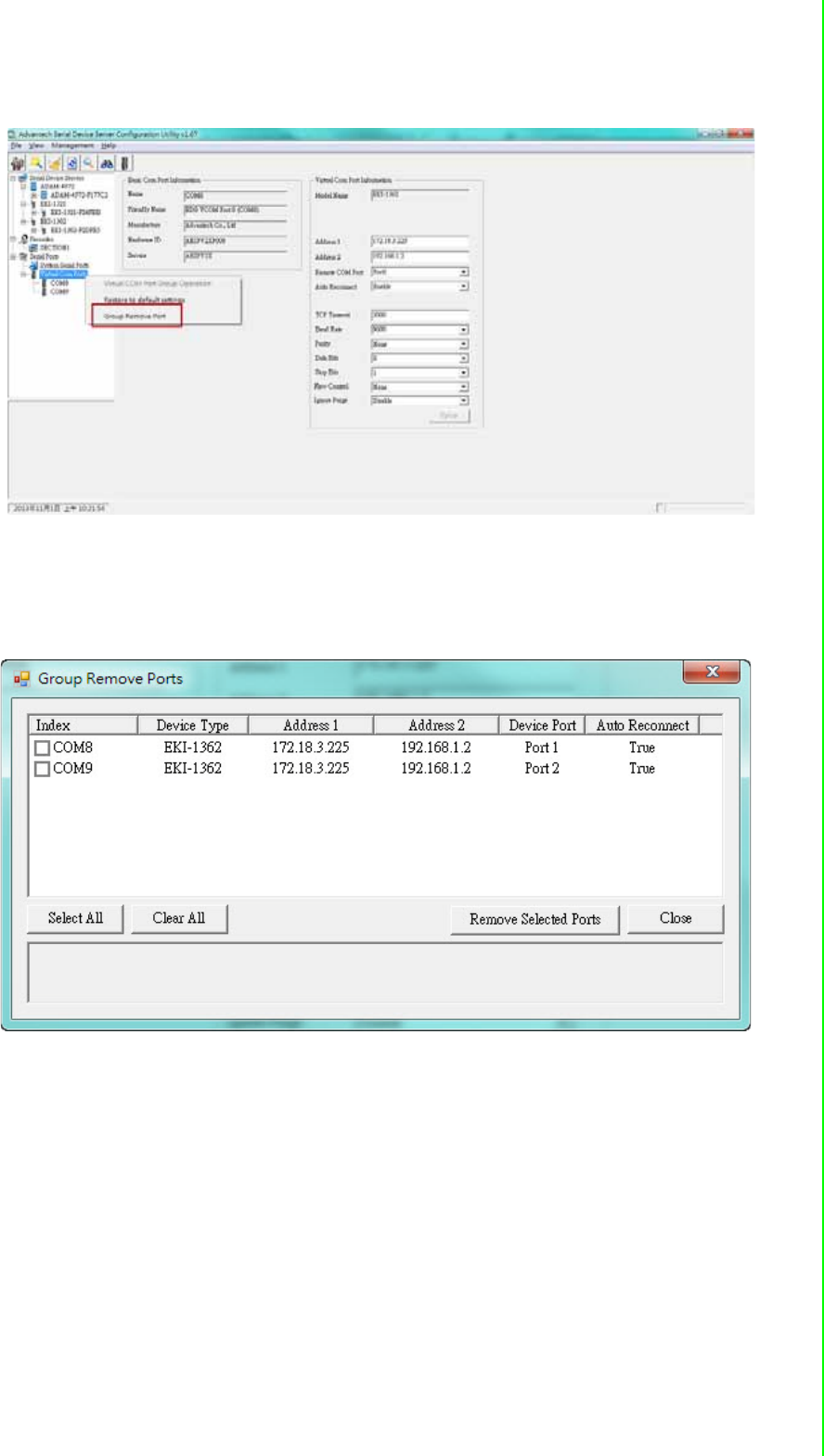
39 EKI-1361/EKI-1362User Manual
Chapter 4 Setting COM Redirector
Group Remove Port
Right click on Virtual Com Ports on Device Server List Area and select “Group
Remove Port”, you can choose which ports you want to remove.

EKI-1361/EKI-1362 User Manual 40

Chapter 5
5Web-Based
Configuration
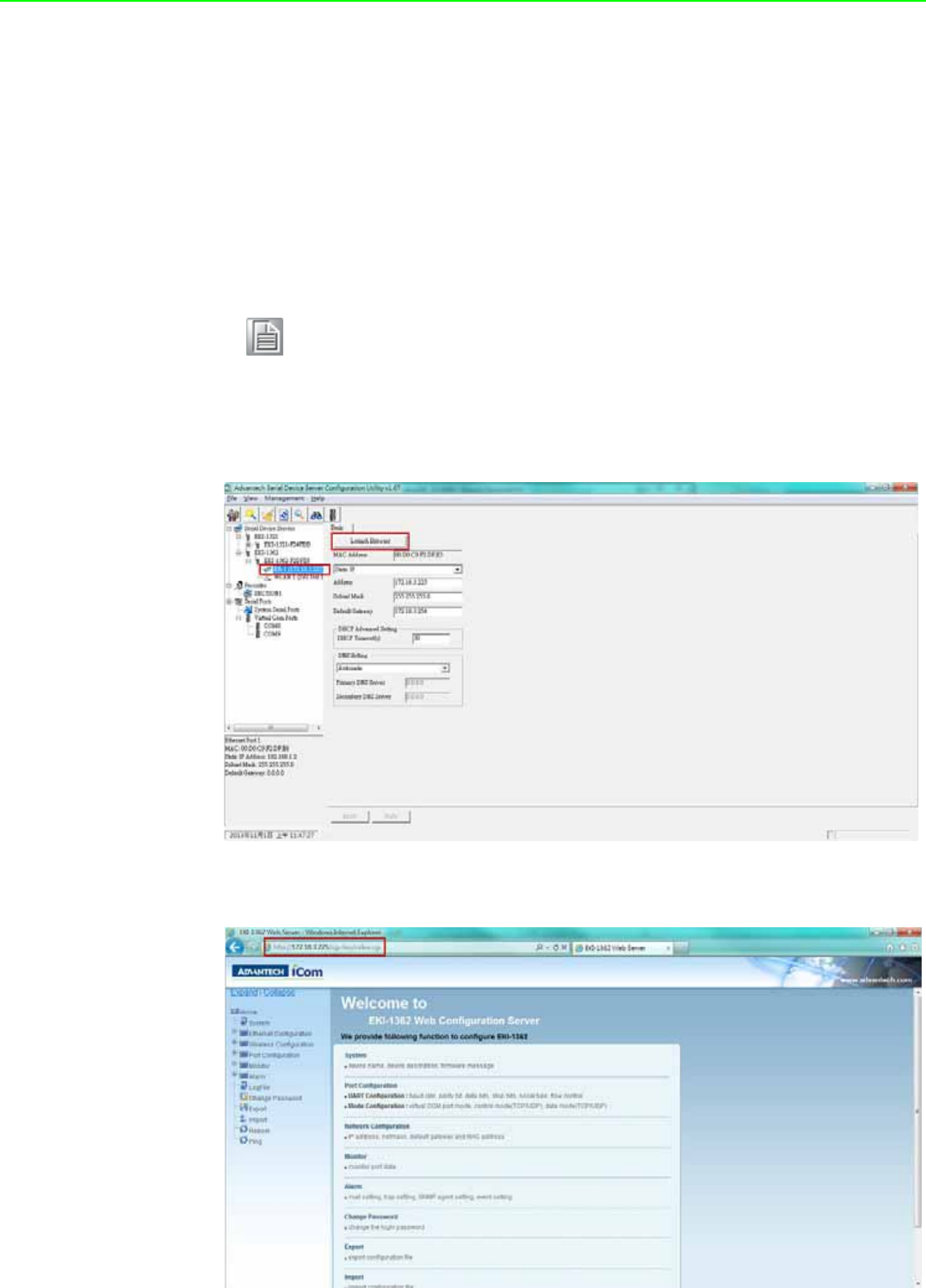
EKI-1361/EKI-1362 User Manual 42
5.1 Overview
EKI series serial device server provides web interface configuration. You can
configure EKI device with most popular standard browsers. can be configured
through a web interface. By using a standard web browser, you can configure EKI
device with the same procedure as with the Windows configuration utility can be
used. In the browser’s address field, enter the IP Address of your EKI-152X series
serial device server. The default IP setting is 10.0.0.1, but you should use the
IP which you have previously assigned for this device. Once the IP is entered, you
will be presented with the following windows.
5.2 Accessing the Web Page
By configuration utility
By Windows Internet Explorer
Note! Before using the web-based configuration, make sure your host PC
Ethernet network IP domain is as same as the serial device server, or it
can establish the TCP connection with the serial device server.
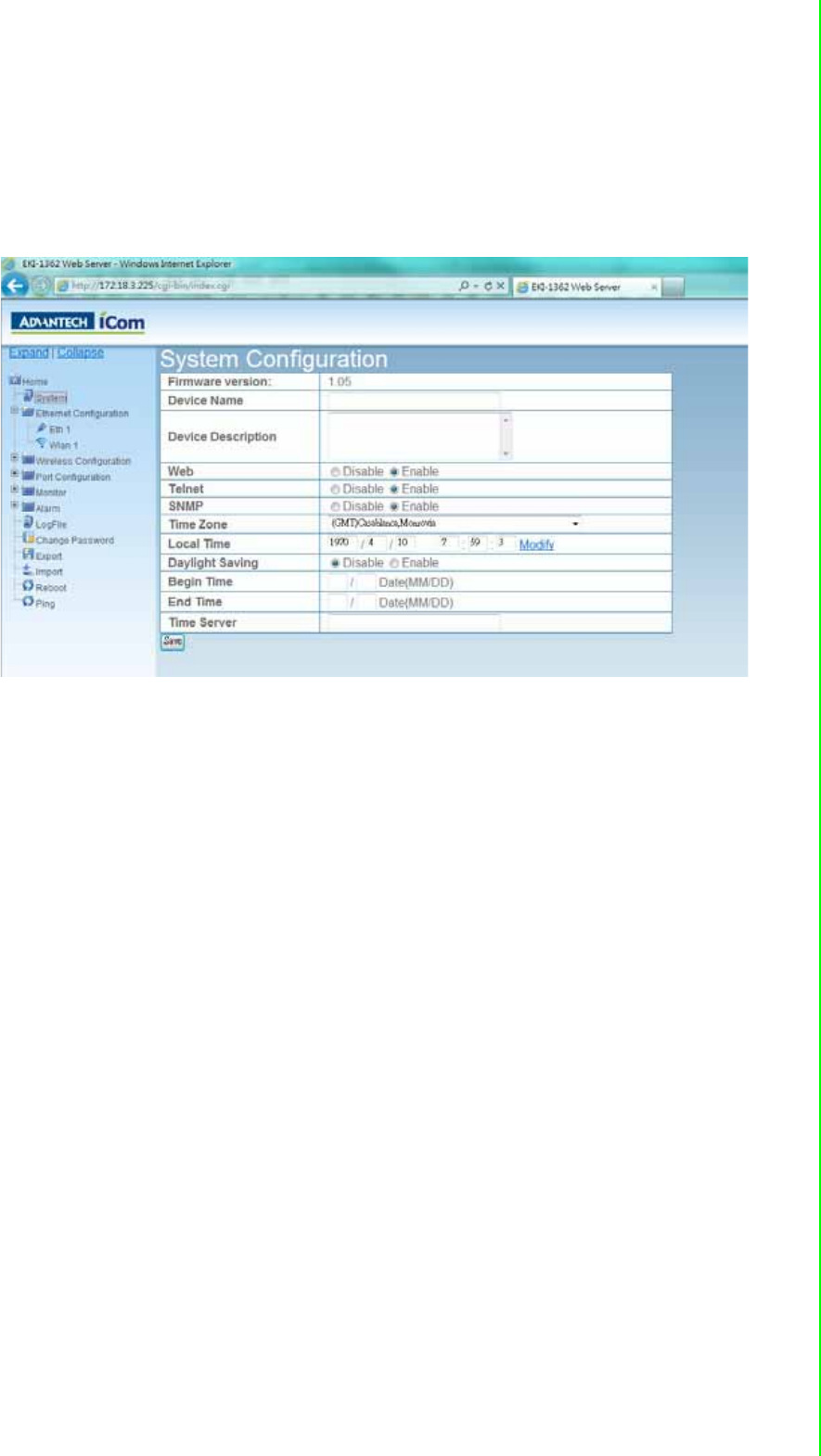
43 EKI-1361/EKI-1362 User Manual
Chapter 5 Web-Based Configuration
5.3 System
You can change the Device Name and Device Description on this page. You can also
enable or disable the Web, Telnet, and SNMP functions. Moreover, you can set the
Timezone related setting.
Device Name
User can change the default device name to a meaningful name for easy identi-
fication.
Device Description
User can place a note about the device in this field for tracking, remind, and etc.
Device Services
User can disable the default services to avoid unauthorized access about the
device settings.
Device Time
User can set the device time for the SNMP trap, mail alarm and etc. That can
help identify the time when the event happened. User can set the Time Server
to use the NTP function to sync the device time with time server automatically.
Or user can set the time manually. Device will keep the time setting even power
off.
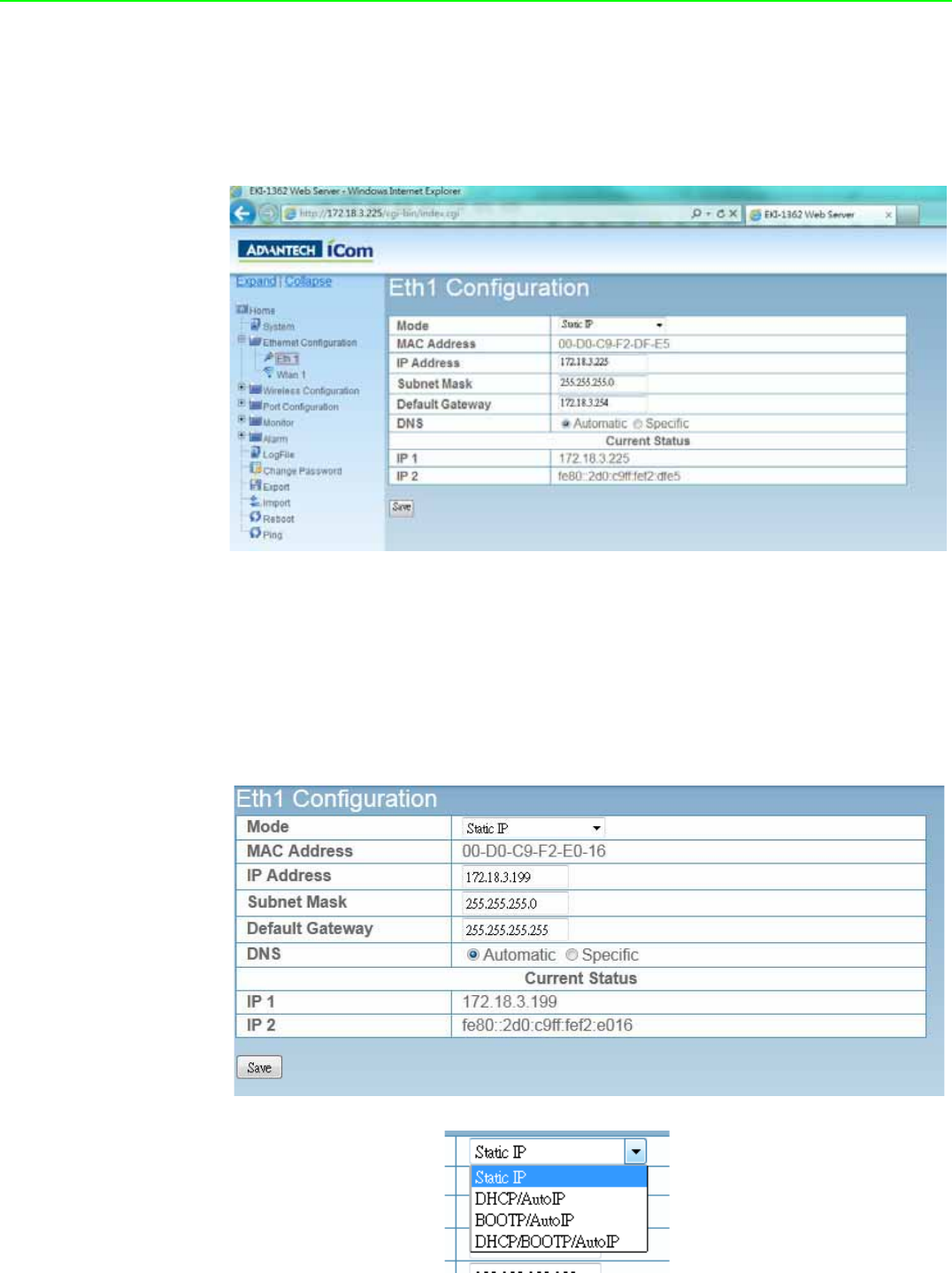
EKI-1361/EKI-1362 User Manual 44
5.4 Network Configuration
Click the Net Configuration and chose either Net 1 or Net 2, there are Net Mode, IP
Address, Subnet Mask, Default Gateway and DNS. Enter the corresponding values
for your network environment. Remember press “Save” after fill in all values.
MAC address:
The MAC address is for the local system to identify and locate each serial
device servers. This MAC address is already set before delivery from factory,
hence no need for further configuration.
IP address, Subnet Mask, Default Gateway:
You can choose from four possible IP Configuration modes --- Static,
DHCP, BOOTP, and DHCP/BOOTP.
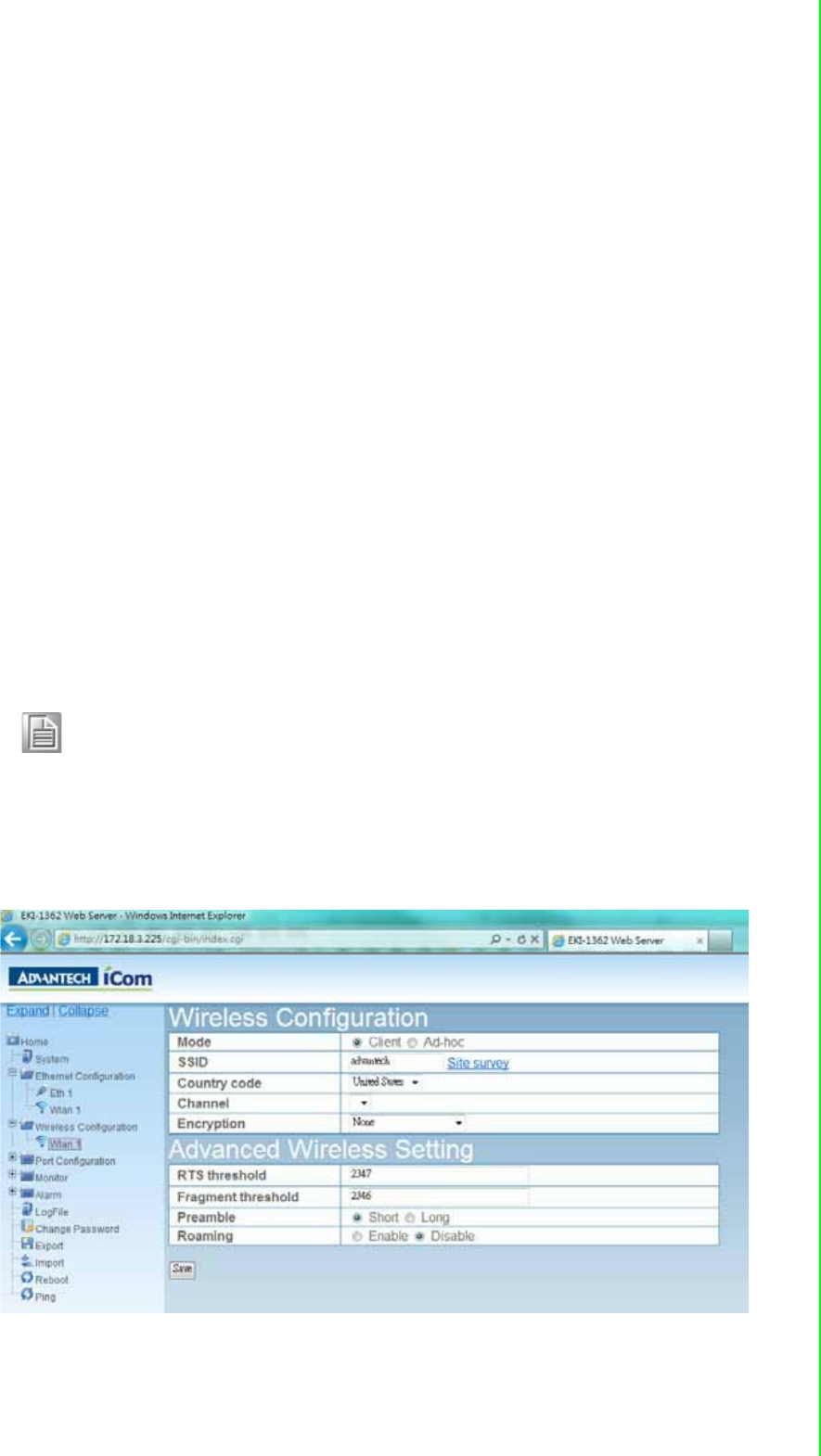
45 EKI-1361/EKI-1362 User Manual
Chapter 5 Web-Based Configuration
Static IP
User defined IP address, Subnet Mask, and Default Gateway.
DHCP + Auto-IP
DHCP Server assigned IP address, Subnet Mask, Default Gateway, and DNS.
BOOTP + Auto-IP
BOOTP Server assigned IP address.
DHCP + BOOTP + Auto-IP
DHCP Server assigned IP address, Subnet Mask, Default Gateway, and
DNS, or BOOTP Server assigned IP address. (If the DHCP Server does not
respond)
DHCP Timeout
When EKI device doesn't get response from DHCP server within specific time-
out, the EKI device will give up the request and take next action.\
DNS Setting
In order to use DNS feature, you need to set the IP address of the DNS server
to be able to access the host with the domain name. The EKI-152X series serial
device server provides Primary DNS Server and Secondary DNS Server config-
uration items to set the IP address of the DNS server. Secondary DNS Server is
included for use when Primary DNS server is unavailable.
DHCP Advanced Setting
When you enabling DHCP protocol to get IP address, it will be waited DHCP
server to give IP within DHCP timeout. The default value is 30 seconds.
5.5 Wireless Configuration
You may onfigure the detail wireless configuration in this page.
Note! All new configurations will take effect after rebooting. The reboot func-
tion is located on the main menu of the Web Configuration.
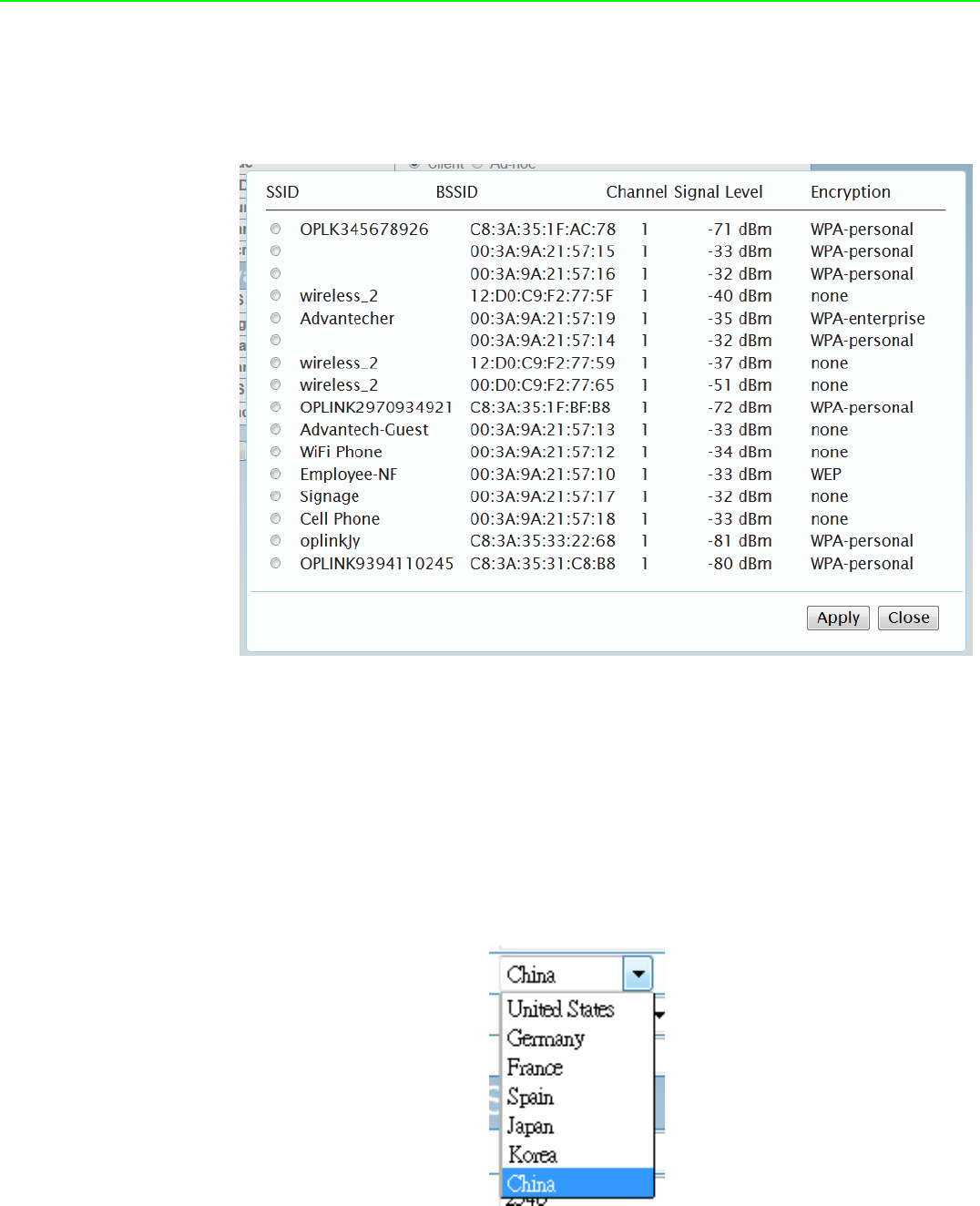
EKI-1361/EKI-1362 User Manual 46
Mode
User can set EKI as Client mode to connect EKI device to a wireless access
point or set EKI as Ad-hoc mode to connect with other wireless device directly
without wireless access point.
Site survey
User can use this function to discovery the wirelees access point near EKI
device. Sometimes, due to the wireless access point setting and environment
issue, the specific wireless access point may not be listed in the result. User can
try to refresh the list several times.
SSID
When using Client mode, user can specify the SSID that EKI device should con-
nect to; When using Ad-hoc mode, user can specify the SSID and channel that
forms a ad-hoc network.
Country code
Differet country code specify different selectable channels. User should choose
the correct corresponding country code to avoid breaking the local law.
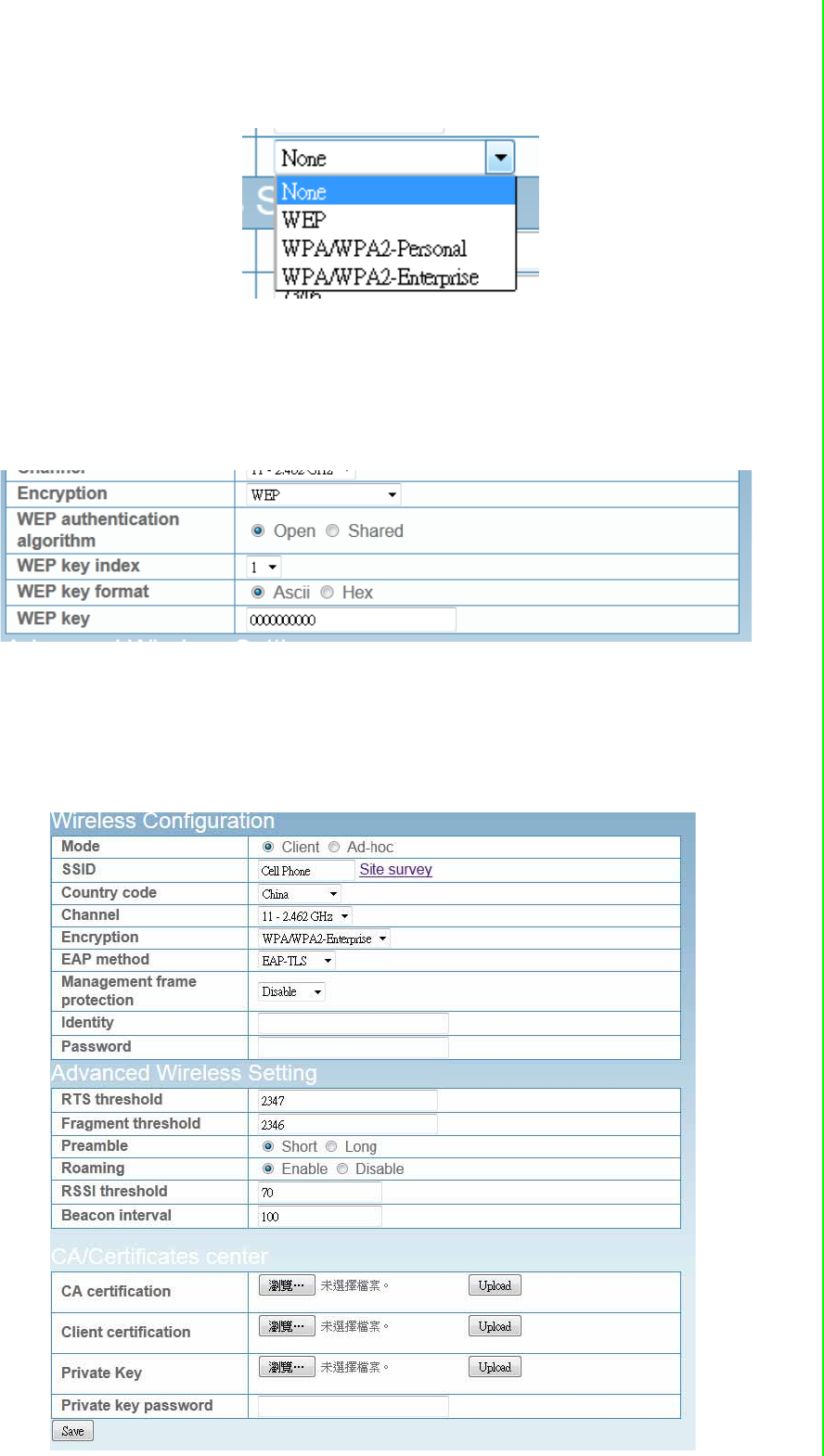
47 EKI-1361/EKI-1362 User Manual
Chapter 5 Web-Based Configuration
Encryption
User can choose using wireless communication without encryption, or choose
with "WEP", "WPA/WPA2-Personal", or "WPA/WPA2-Enterprise" that can use
standard encryption method to protect the data.
WEP
Wired Equivalent Privacy (WEP) is a security algorithm for IEEE 802.11 wireless
networks. When using WEP encryption, user should also choose the authenti-
cation algorithm, key index, key format and fill in the key content repspectively.
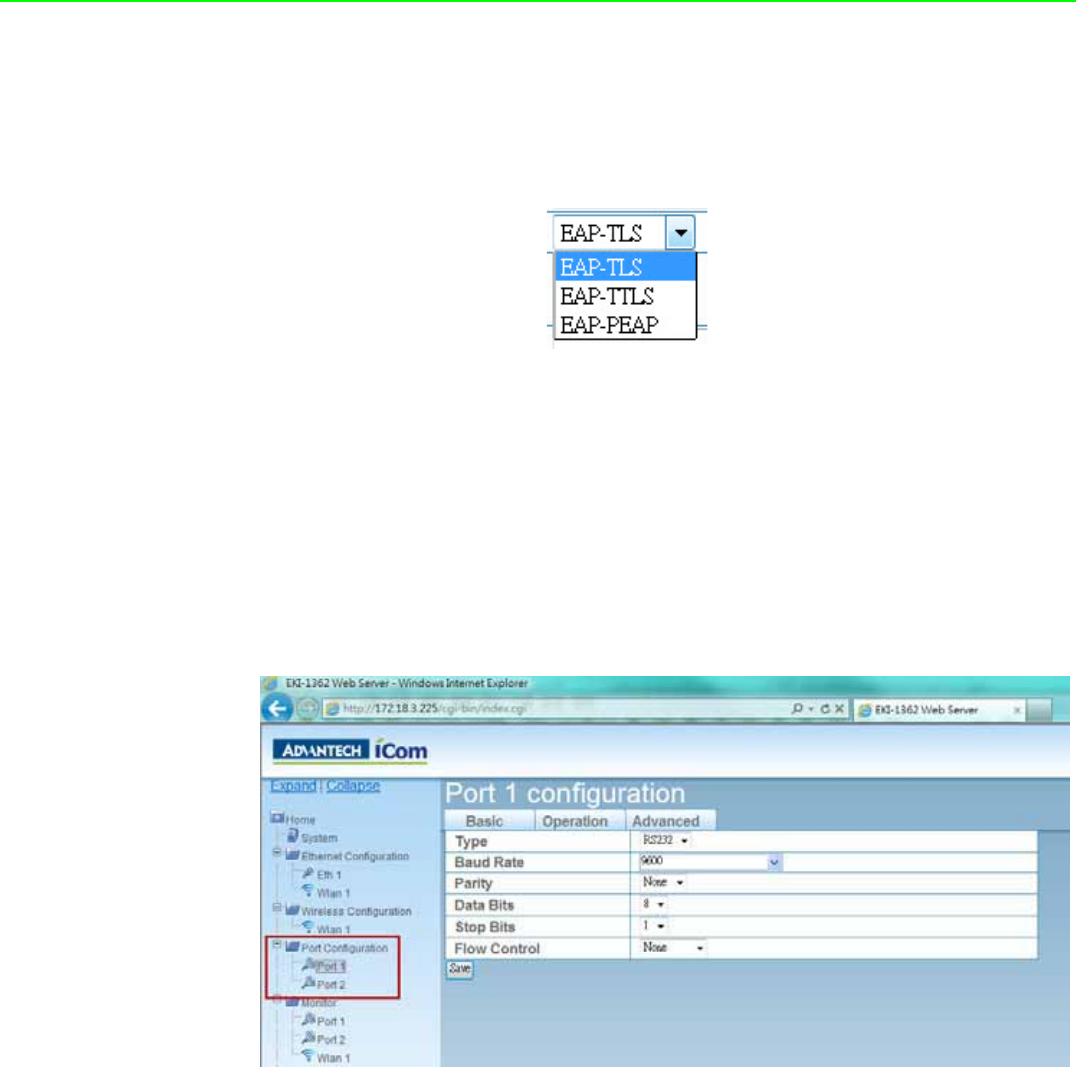
EKI-1361/EKI-1362 User Manual 48
WPA/WPA2-Personal, WPA/WPA2-Enterprise
The main difference between WPA/WPA2-Personal and WPA/WPA2-Enterprise
is the authentication method. WPA/WPA2-Enterprise uses additional certifica-
tion to identify the specific device. User should provide the extra certification
and private key files.
If using WPA/WPA2 encryption, user should also choose which EAP method is using
with: TLS, TTLS, or PEAP. User should also provide the relative parameters: Man-
agement frame protection, Identity, Password, Inner Authertication.
5.6 Port Configuration
There are Basic, Operation Mode, and Advanced Setting in the serial port
configuration. For more detailed information for setting, please refer to chapter 3.4
and chapter 3.5.
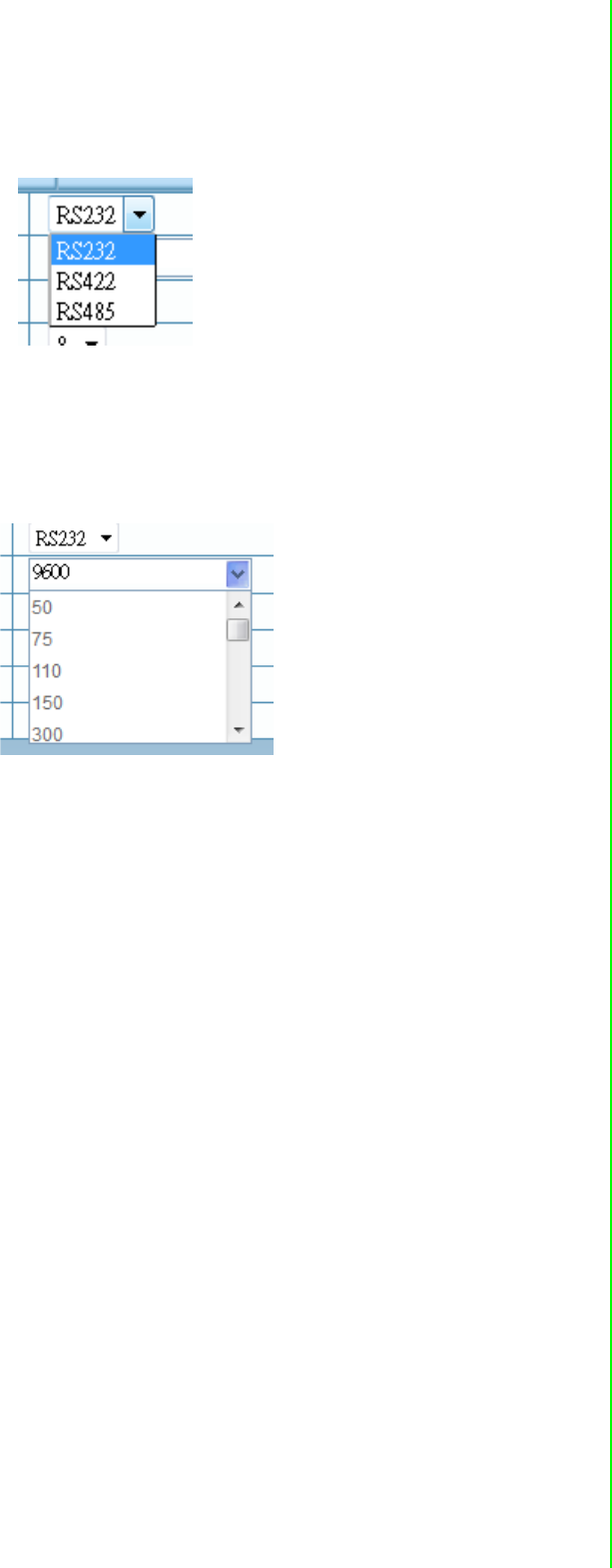
49 EKI-1361/EKI-1362 User Manual
Chapter 5 Web-Based Configuration
5.6.1 Basic Port Configuration
Type
The EKI-152X series serial device server offers three kinds of serial interfaces,
RS-232, RS-485 and RS-422. User can use any of the three serial interfaces
according to user’s requirements.
Baud Rate
User can choose the regular baud rate from the drop down list or key in any par-
ticular baud rate manually.
Parity
The EKI serial device server provides five options for parity: None, Odd, Even,
Space, and Mark.
Data Bits
The EKI serial device server provides four options for data bits: 5, 6, 7, and 8.
Stop Bits
The EKI serial device server provides three options for stop bits: 1, 1.5, and 2.
Flow Control
The EKI serial device server provides four options for flow control: None, XON/
XOFF, RTS/CTS, and DTR/DSR.
5.6.2 Operation Mode
5.6.2.1 Virtual COM Mode
The EKI serial device server extends traditional COM ports of a PC to Ethernet
access. Through Ethernet networking, users can control and monitor remote serial
devices and equipment over LAN or WAN. The EKI device server comes with a COM
port redirector (Virtual COM driver) that transmits all serial signals intact. This means
that your existing COM-based software can be preserved, without modifying to fulfill
the needs. The Virtual COM mode allows user to continue using RS-232/422/485
serial communications software that was written for pure serial communication appli-
cations.
The EKI series comes with COM port redirector (virtual COM driver) that work with
Window 2000/XP/Vista(X86) systems. The driver establishes a transparent con-
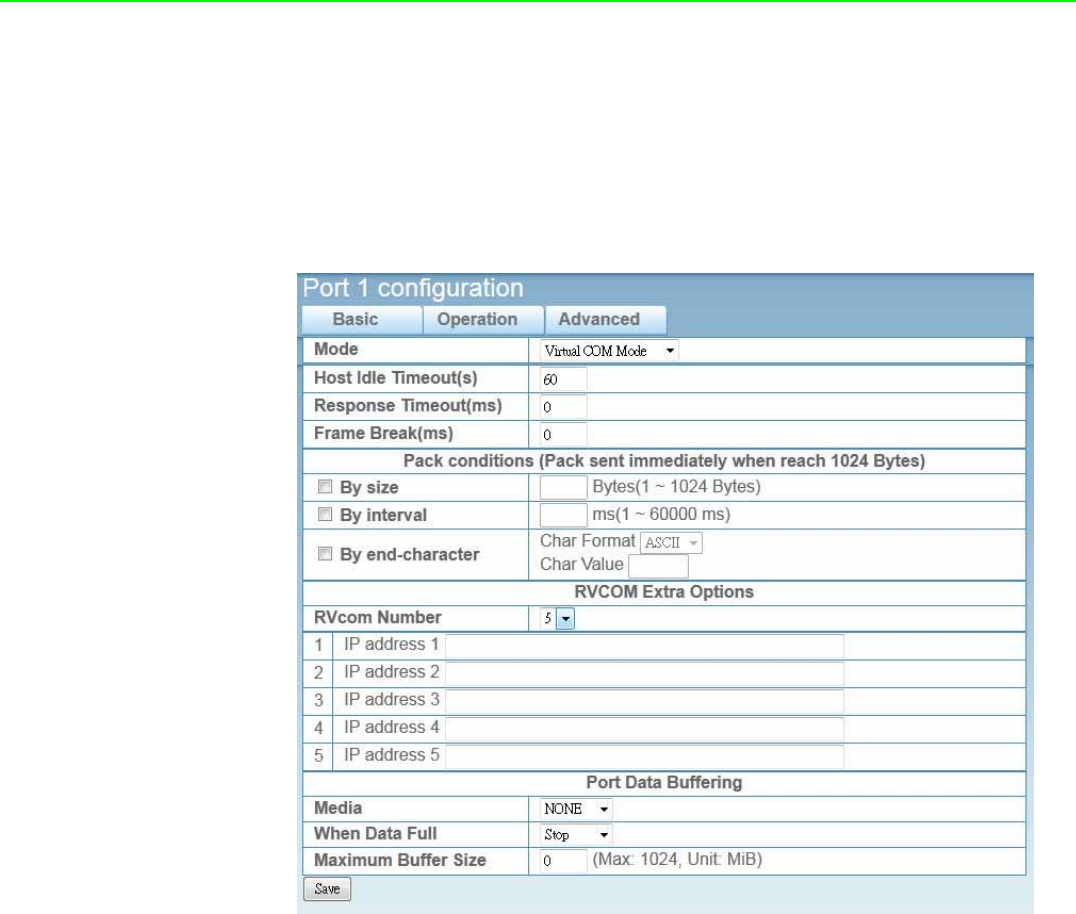
EKI-1361/EKI-1362 User Manual 50
nection between host and serial device by mapping the IP of the EKI-152X seriesse-
rial device server serial port to a local COM port on the host computer.
The EKI series provides Multi-access function through Ethernet connection path.
Allow the maximum of 5 connections to open one serial port simultaneously. In this
mode, all connection has to use the same serial setting. If one serial setting of these
connections is different from others, the data communication may operate incorrectly.
Host Idle Timeout
The “Host Idle Timeout” setting monitors the connection between the host and
the device. If the “Host Idle Timeout” setting time is reached, the device server
will release the resources allocated to the port mapping. This prevents a stalled
host from affecting the connective device.
The EKI device provides Multi-access function through Ethernet connection
path. Allow the maximum of 5 connections to open one serial port simultane-
ously. In the mode, all connection has to use the same serial setting. If one
serial setting of these connections is different from others, the data communica-
tion may operate incorrectly.
There are two operating mode of Multi-access function. One is Normal mode;
another is Round-Robin mode.
Normal mode
Disabling “Response Timeout” parameter, the EKI device will operate in “normal
mode”. When multiple hosts open the serial port simultaneously, the EKI device
only offers control ability for the first connected host and provides data commu-
nication function for others. Each serial port supports up to five simultaneous
connections, so multiple hosts can transmit/receive data to/from the same serial
port simultaneously. Every host can transmit data to the same serial port, and
the EKI device will also transmit data to every hosts. When the multiple hosts
transmit data to the same serial port at the same time, the received data from

51 EKI-1361/EKI-1362 User Manual
Chapter 5 Web-Based Configuration
Ethernet and the outputs of serial port are mixed. When the EKI device receives
data from serial port, the data will also be transmitted to the connected hosts
simultaneously.
Round-Robin mode:
Enabling “Response Timeout” parameter, the EKI device will operate in “Round-
Robin mode”. Each serial port supports up to five simultaneous connections, so
multiple hosts can transmit/receive data to/from the same serial port simultane-
ously. Every host can transmit data to the same serial port simultaneously, but
the EKI device will process the data communication in order. The EKI device will
process the first host’s request and reply the response to the first host. The EKI
device serial device server can determine the end of the serial acknowledge-
ment via response timeout. When EKI device serial device server receives noth-
ing from serial port after the setting of response timeout, the device will reply the
acknowledgement to the host and then process the next host’s request. While
the connected hosts are more and “Response Timeout” is long, the process
time is much longer.
Frame Break is a very import parameter for Round Robin mode. This parameter
is the smart way to reduce inefficient waiting time and the EKI device can trans-
mit data more efficiently. Disabling the Frame Break function, the EKI device will
wait “Response Timeout” period, whether the device have transmitted the data.
During this period, the commands from hosts will be queued and the EKI device
just processes this command. Enabling “Frame Break”, if the serial port idle is
longer than the “Frame Break” period, the EKI device will assume the communi-
cation is completed and continue the next host’s query. This is an efficient way
to reduce the waiting time and improve the performance.
5.6.2.2 Data Mode (USDG Mode)
The EKI device can be Data server or Data client either. Both operations support
TCP and UDP protocol. The EKI device makes your serial devices behave just like
networking devices. You can issue commands or transmit data from serial devices,
which connected to the EKI device, to any devices that are connected to the Internet.
The EKI device allows most 5 host PCs accessing data simultaneously via polling
networking architecture. You can use it according to your application. If you want to
access the EKI device, you must ascertain your application software supports stan-
dard networking application programming interface (API) such as: WinSock Socket.
You might select “USDG Mode” as the following figure to change the mode of the port
to TCP server/client or UDP mode.
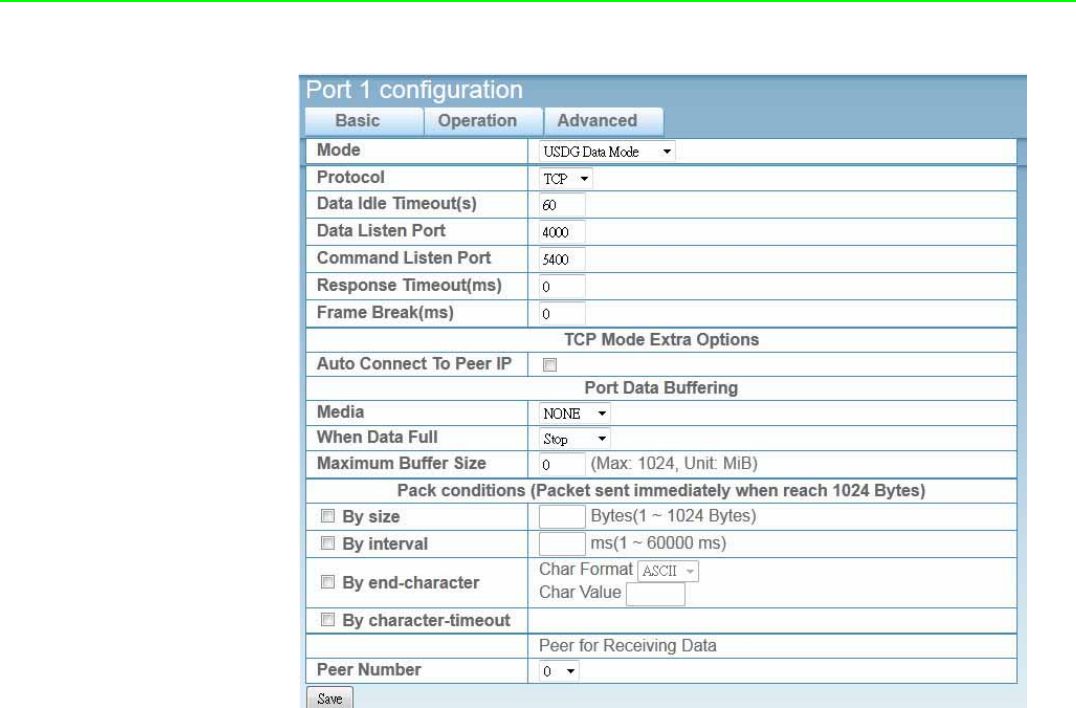
EKI-1361/EKI-1362 User Manual 52
Protocol
The EKI device provides TCP/IP and UDP two protocols. In settings, you can
choose either TCP mode or UDP mode according to your application.
Data Listen Port
The TCP/UDP port number represents the source port number, and the number
is used to identify the channel for remote initiating connections. Range: 1024-
65533. If an unknown caller wants to connect to the system and asks for some
services, they need to define the TCP/UDP port to carry a long-term conversa-
tion. Each node on a TCP/IP network has an IP address, and each IP address
can allow connections on one or more TCP port. The well known TCP ports are
those that have been defined; for example, port 23 is used for Telnet connec-
tions. There are also custom sockets that users and developers define for their
specific needs. The default TCP/UDP port of the EKI device is 5300. The exam-
ple initial 5300 is System Port, and 5301 is Data Port. But users can adjust them
by one's preference or application.
Each port has its own data listen port to accept connected request of other net-
work device. So, the data listen port can’t be set the same value. You can trans-
mit/receive data to/from device via the data listen port.
Command Listen Port
Each port has its own command listen port to accept connected request of other
network device. So, the command listen port can’t be set the same value. You
can use ‘AT command’ to change the port setting via the command listen port.
The Command Listen Port should be different from the Data Listen port.
Data Idle Timeout
The default is 60 seconds. If you want to keep connection continually, you can
disable the Data Idle Timeout. Data idle Time is the time period in which the
device waits for data. If the EKI device does not receive data over an estab-
lished idle time, the EKI device will disconnect temporarily. When the data

53 EKI-1361/EKI-1362 User Manual
Chapter 5 Web-Based Configuration
comes to the EKI device, it will reconnect automatically. Users do not need to
reconnect.
Enable Time Sharing
The EKI device provides Multi-access function through Ethernet connection
path. Allow the maximum of 5 connections to open one serial port simultane-
ously. In the mode, all connection has to use the same serial setting. If one
serial setting of these connections is different from others, the data communica-
tion may operate incorrectly.
There are two operating mode of Multi-access function. One is Normal mode;
another is Round-Robin mode.
Normal Mode
Disabling “Response Timeout” parameter, the EKI device will operate in “normal
mode”. When multiple hosts open the serial port simultaneously, the EKI device
only offers control ability for the first connected host and provides data commu-
nication function for others. Each serial port supports up to five simultaneous
connections, so multiple hosts can transmit/receive data to/from the same serial
port simultaneously. Every host can transmit data to the same serial port, and
the EKI device will also transmit data to every hosts. When the multiple hosts
transmit data to the same serial port at the same time, the received data from
Ethernet and the outputs of serial port are mixed. When the EKI device receives
data from serial port, the data will also be transmitted to the connected hosts
simultaneously.
Round-Robin Mode
Enabling “Response Timeout” parameter, the EKI device will operate in “Round-
Robin mode”. Each serial port supports up to five simultaneous connections, so
multiple hosts can transmit/receive data to/from the same serial port simultane-
ously. Every host can transmit data to the same serial port simultaneously, but
the EKI device will process the data communication in order. The EKI device will
process the first host’s request and reply the response to the first host. The EKI
device serial device server can determine the end of the serial acknowledge-
ment via response timeout. When EKI device serial device server receives noth-
ing from serial port after the setting of response timeout, the device will reply the
acknowledgement to the host and then process the next host’s request. While
the connected hosts are more and “Response Timeout” is long, the process
time is much longer.
Frame Break is a very import parameter for Round Robin mode. This parameter
is the smart way to reduce inefficient waiting time and the EKI device can trans-
mit data more efficiently. Disabling the Frame Break function, the EKI device will
wait “Response Timeout” period, whether the device have transmitted the data.
During this period, the commands from hosts will be queued and the EKI device
just processes this command. Enabling “Frame Break”, if the serial port idle is
longer than the “Frame Break” period, the EKI device will assume the communi-
cation is completed and continue the next host’s query. This is an efficient way
to reduce the waiting time and improve the performance.
Auto Connect Peer IP
If enabling this option, EKI device will connect to TCP/IP which are set at Peers
page automatically after boot up.
Peer Number
Set the number of network device which you want to connect. You can set max-
imum sixteen network devices which you want to connect. You need to fill out
the IP Address and Port (including local port and peer port) of network devices
which you want to connect.
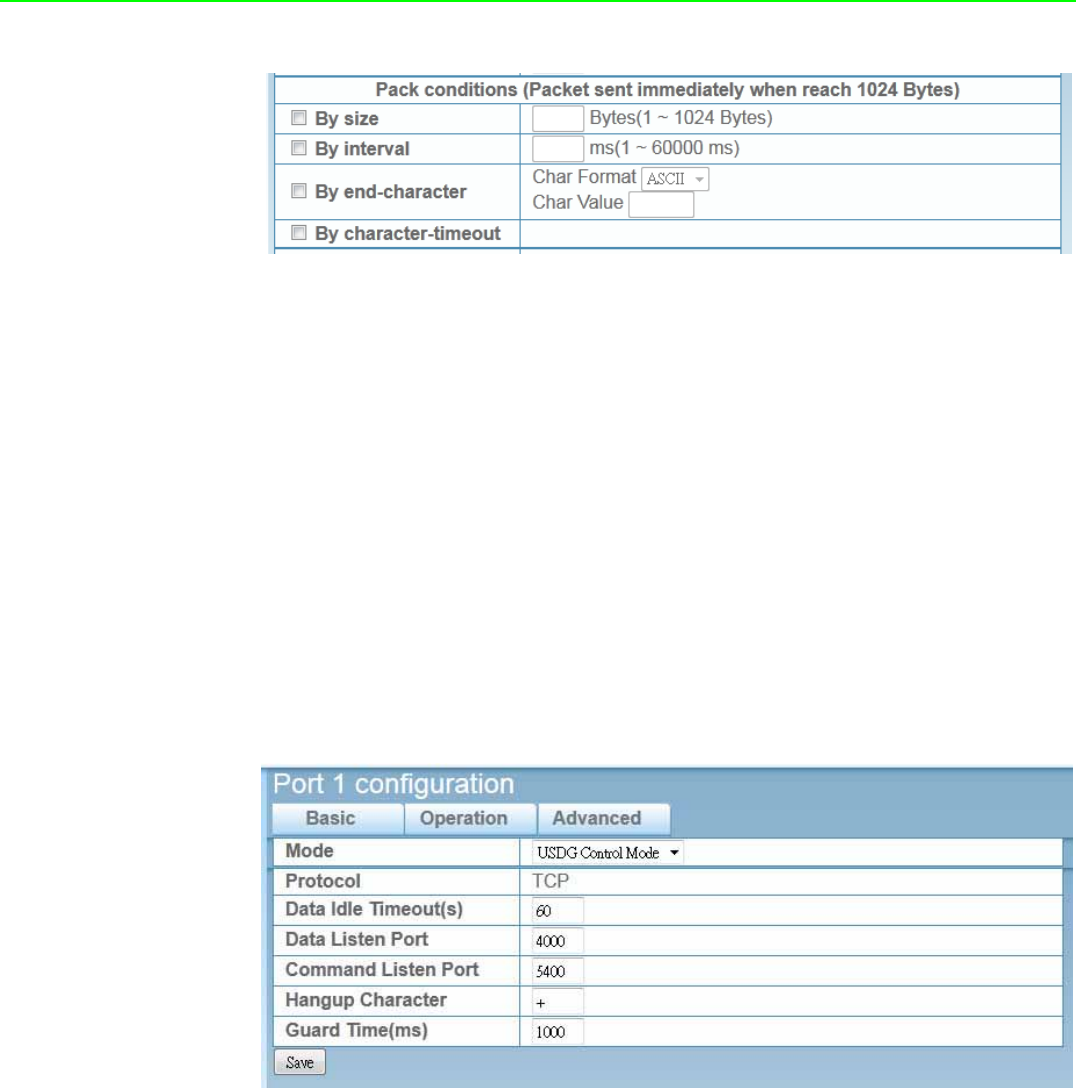
EKI-1361/EKI-1362 User Manual 54
Data Pack
Data pack means you can set condition of receiving data from serial port to be a
package according to your application. There are four options to set the data
packing: by data size (Byte), by time interval (ms), by character timeout (4
Bytes), or by end of character.
5.6.2.3 USDG Control Mode
In controlling mode, the EKI device presents a modem interface to the attached serial
device: it accepts AT-style modem commands to connect/disconnect to other net-
working device. If you want serial device running application program to connect/dis-
connect to different devices dynamically, you can use controlling mode.
The “Control mode” provides three kinds of modem AT-style commands. The serial
devices can use these commands to control the EKI device to connect/disconnect to
remote networking device. Thus, intelligent serial devices such as standalone PLC
will send/receive data to/from devices one by one via Ethernet.
Please refer to the USDG Data Mode to setup the Data Listen Port, Command Listen
Port, and Data Idle Timeout.
Hangup Character
The default character is “+”. After you have connected to another serial device
via EKI device, you may need to disconnect. Then you can use the command
"+++" to disconnect. To do this leaves your keyboard idle (don't press any keys)
for at least several seconds, then press “+” three times. You can set “Guard
Time" to define the idle time. Be sure that you have to press “+” over the idle
time.
Guard Time
The default value is 1000 ms.
Example: <Guard Time>+++<Guard Time>

55 EKI-1361/EKI-1362 User Manual
Chapter 5 Web-Based Configuration
Control Mode is designed for use with legacy operating systems, such as MS-
DOS, that do not support TCP/IP Ethernet. By connecting one of EKI’s serial
ports to the MS-DOS computer’s serial port, it is possible to use legacy software
originally designed to transmit data via modem, but now transmit the data over
the Ethernet.
Dial-in (Use TCP connect to serial port of EKI)
EKI listens for a TCP/IP connection request from the remote host. when a TCP
connection is coming, there will have prompt string "RING" shows on serial port
site. After the system prompting the "RING" string, user can use "ATA" com-
mand to accept the connection or just ignore it. After accepted the connection,
EKI will enter data mode.
Dial-out (From serial port connect to specific TCP host target)
User can user the AT Comand "ATD <IP>#<TCP port>" to connect to a specific
TCP target host from serial port. when the TCP connection is accepted by the
remote host, EKI will show "CONNECT" string to serial port and enter data
mode.
Disconnect from serial port
When EKI is in data mode, user can type the hangup character triple times,
such as "+++". EKI will shut down the TCP connection and back to command
mode, and shows “NO CARRIER” to indicate the connection has been shut
down.
Disconnect from remote TCP connection
When EKI shows "NO CARRIER" on serial port, it means the TCP connection
has been shut down. EKI will back to command mode automatically.
AT Commands
EKI supports the following common AT commands used with a typical modem:
Note! The “+++” command cannot be divided. The “+” character can be
changed in Hang-up Character, and the guard time, which prefixes and
suffixes the “+++” in order to protect the raw data, can be changed in
Guard Time (ms). See picture.
AT command Description
ATA Answer
ATD Dial up the IP address#Port No.
ATE ATE0=Echo OFF
ATE1=Echo ON (default)
ATH On-hook
ATZ Reset and Recall user’s settings
AT&F Restore factory’s Default settings
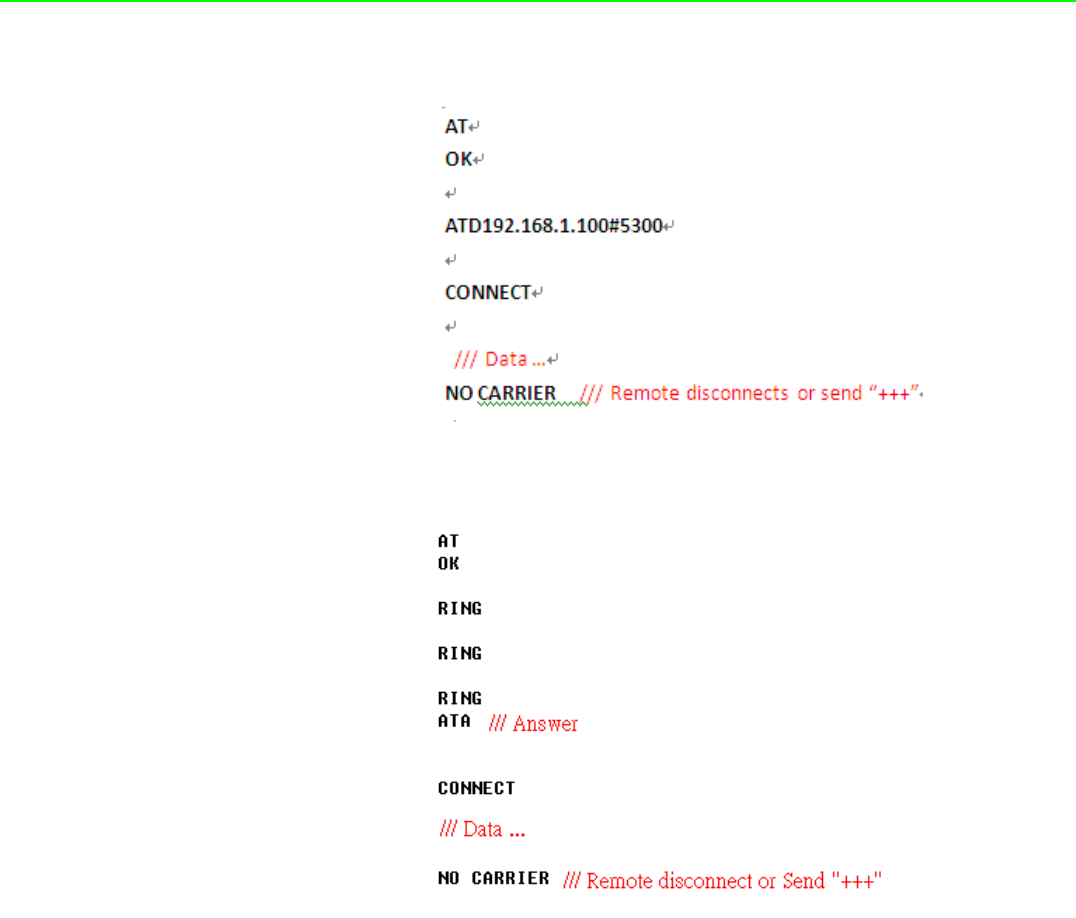
EKI-1361/EKI-1362 User Manual 56
Example 1 (Local connect to remote)
Example 2 (Remote connect to local)
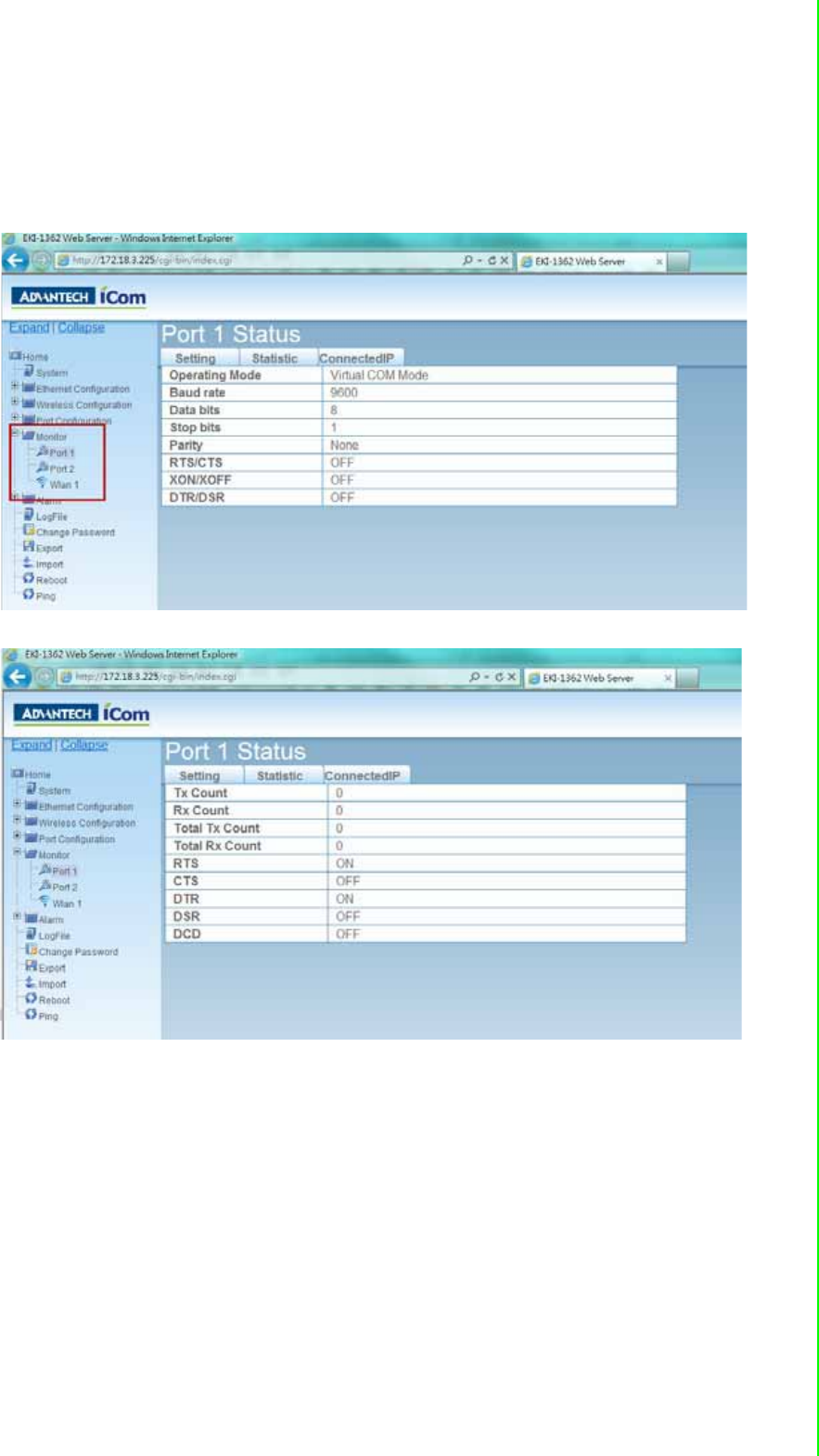
57 EKI-1361/EKI-1362 User Manual
Chapter 5 Web-Based Configuration
5.7 Monitor
You can monitor the serial ports settings, statistic, and the connected IP address by
click on Monitor function on the main menu.
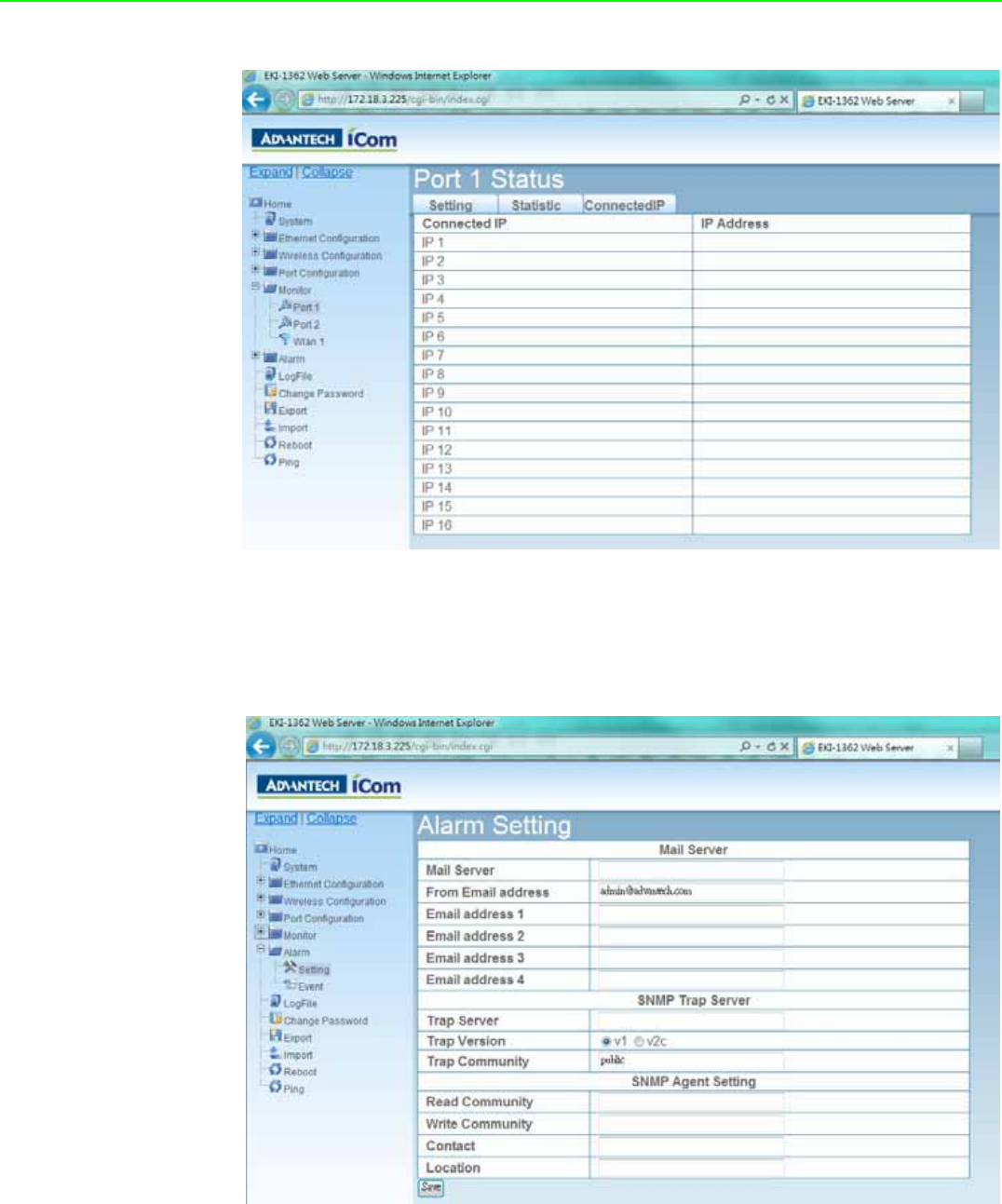
EKI-1361/EKI-1362 User Manual 58
5.8 Auto Warning (Alarm)
You can set the e-mail server and SNMP Trap server in the Setting page, and set the
event type in the Event page.
5.8.1 Email Alert
Consult your ISP or Network Administrator for the proper SMTP mail server settings.
The auto warning functions may not work properly without proper settings.
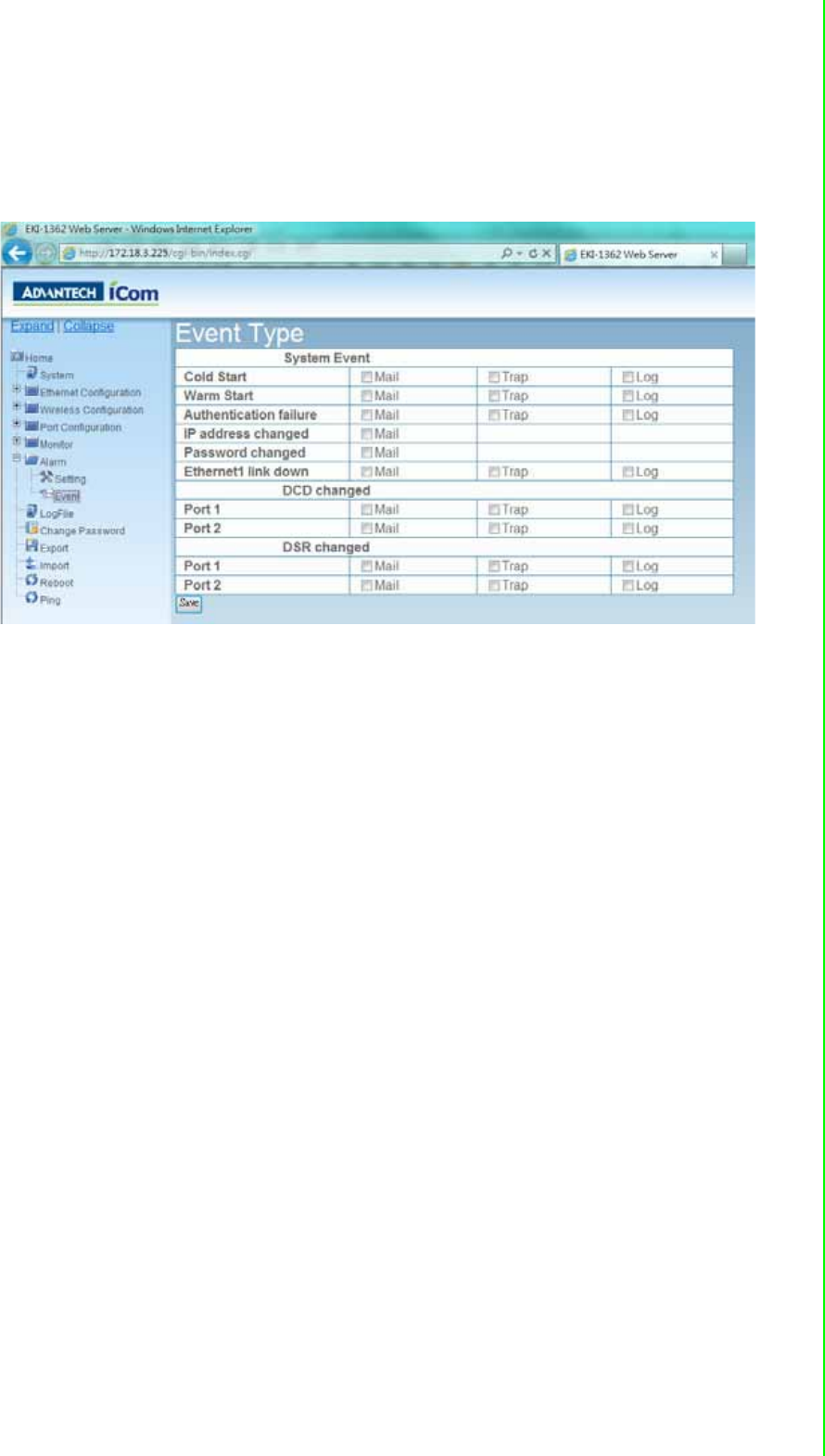
59 EKI-1361/EKI-1362 User Manual
Chapter 5 Web-Based Configuration
5.8.2 SNMP Trap
You need to set the proper IP address of SNMP Trap Server. And choose the Trap
Version; there are “SNMP v1” and “SNMP v2c” options.
5.8.3 System Event
Cold Start
This refers to starting the system from power off. When performing a cold start,
the EKI device will send an e-mail, or send a SNMP trap after success reboot-
ing.
Warm Start
This refers to restarting the system without turning the power off. When perform-
ing a warm start, the EKI device will send an e-mail, or send a SNMP trap after
restarting the system.
Authentication failure
The user types a wrong password from Console or Administrator. When authen-
tication failure occurs, the EKI device will send an e-mail, or send a SNMP trap.
IP Change
The user changes the EKI device’s IP address. When the IP address changes,
the EKI device will send an e-mail, or send a SNMP trap after restarting the sys-
tem.
Password Change
The user changes the EKI device’s password. When the password changes, the
EKI device will send an e-mail, or send a SNMP trap after restarting the system.
Ethernet 1 Down
The Ethernet 1 port has link failure condition. When the Ethernet 1 links fail, the
EKI device will send an e-mail, or send a SNMP trap immediately.
Ethernet 2 Down
The Ethernet 2 port has link failure condition. When the Ethernet 2 links fail, the
EKI device will send an e-mail, or send a SNMP trap immediately.
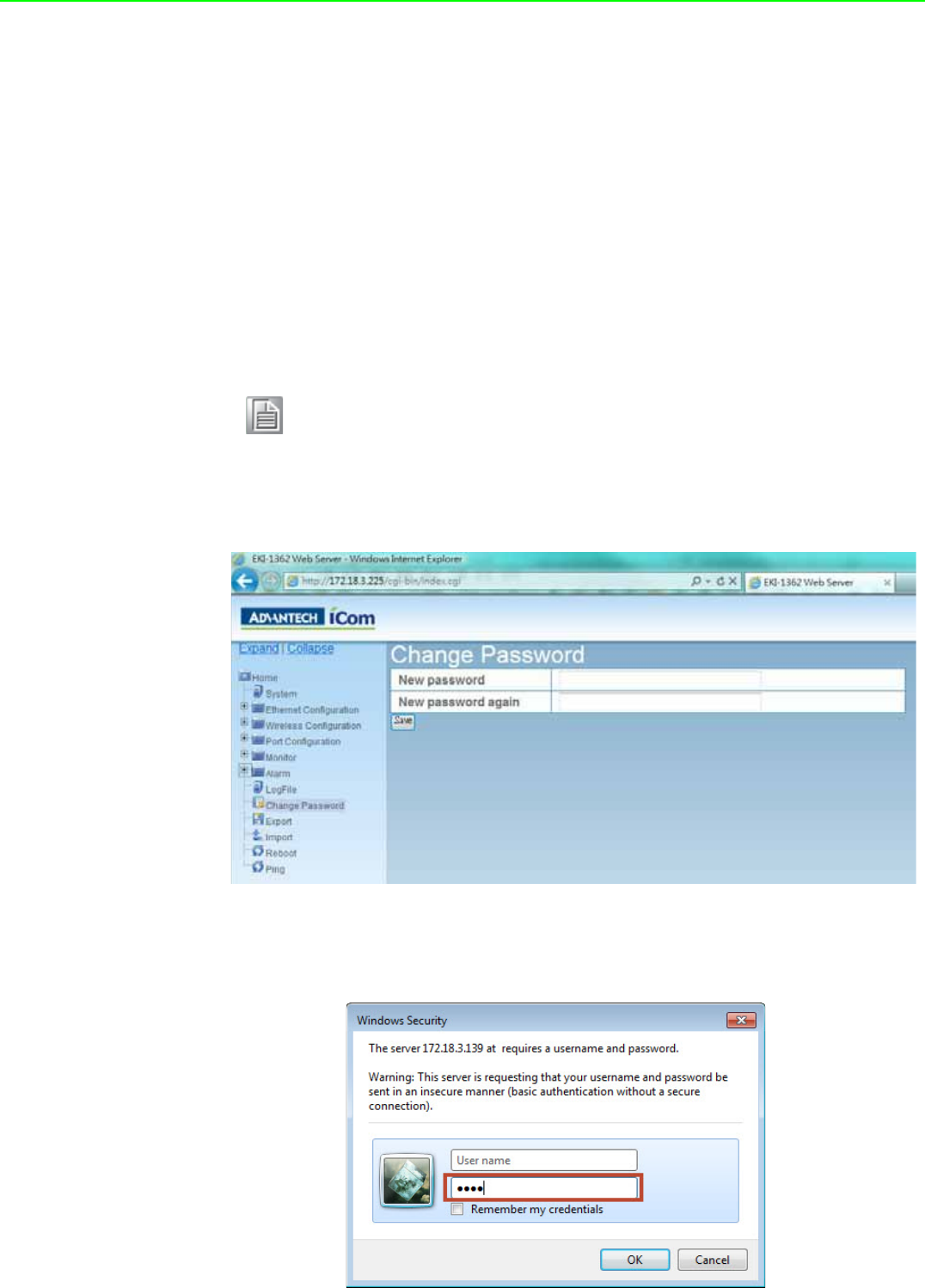
EKI-1361/EKI-1362 User Manual 60
5.8.4 Serial Port Event
DCD Change
The DCD (Data Carrier Detect) signal has changed, also indicating that the
modem connection status has changed. For example, a DCD change to high
also means “Connected” between local modem and remote modem. If the DCD
signal changes to low, it also means that the connection line is down. When the
DCD signal changes, the EKI device will send an e-mail, or send a SNMP trap.
DSR Change
The DSR (Data Set Ready) signal has changed, also indicating that the data
communication equipment’s power is off. For example, a DSR change to high
also means that the DCE is powered ON. If the DSR signal changes to low, it
also means that the DCE is powered off. When the DSR signal changes, the
EKI device will send an e-mail, or send a SNMP trap.
5.9 Change Password
You can change the serial device server password on here:
If you have set a password via the configuration utility or Telnet or serial console,
when you access the web configuration, you need to key in the password. Do not
need to enter the user name in the dialog.
Note! All new configurations will take effect after rebooting. The reboot func-
tion is located on the main menu of the Web Configuration.
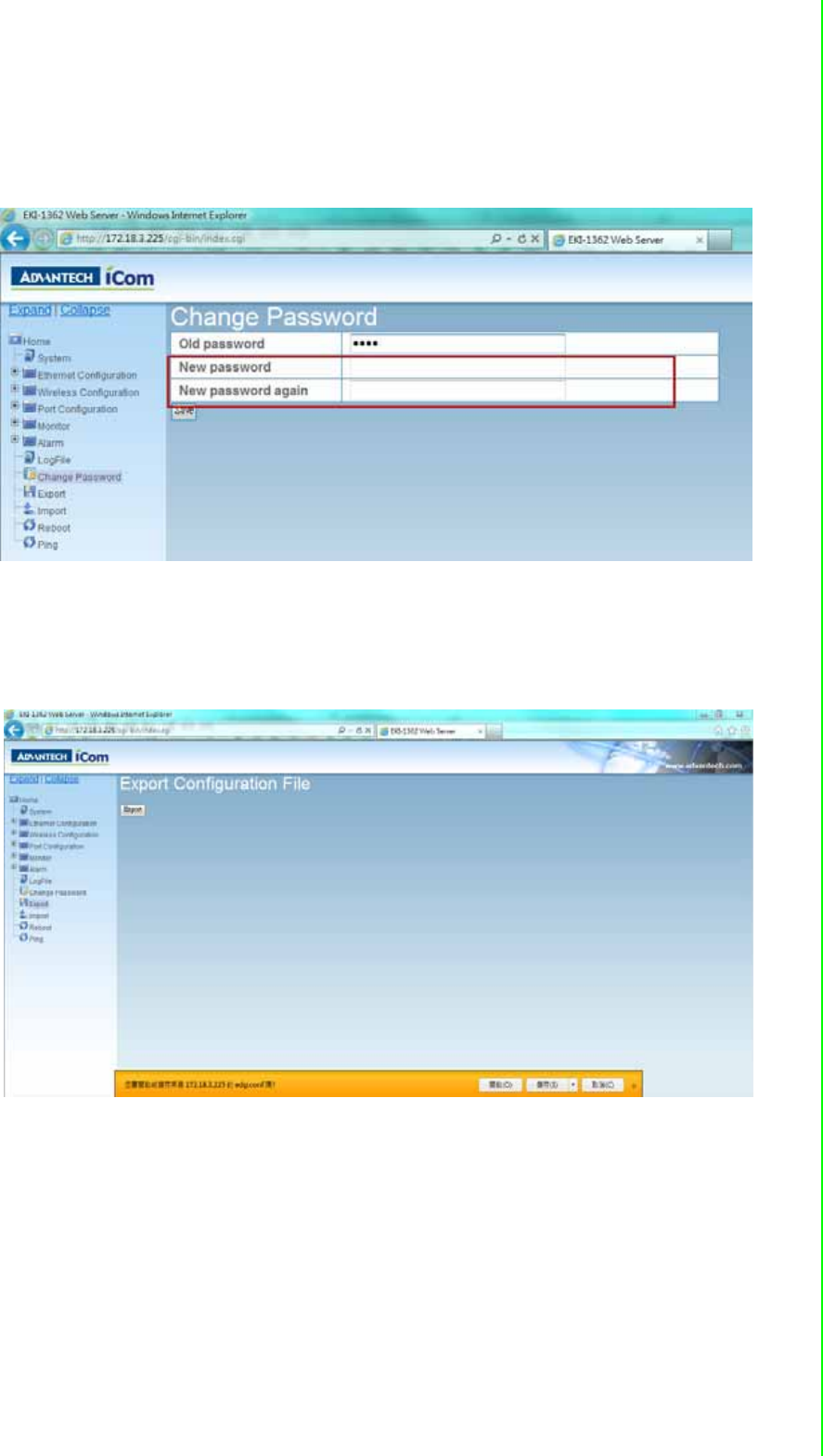
61 EKI-1361/EKI-1362 User Manual
Chapter 5 Web-Based Configuration
If you want to disable the password protection, just change the password to the
default “None” (leave the new password column blank), Be sure to press the “Save”
button and reboot the serial device server to make the change effective.
5.10 Import/Export Device Settings
You can Import or Export the serial device server all setting as the “.conf” file format.
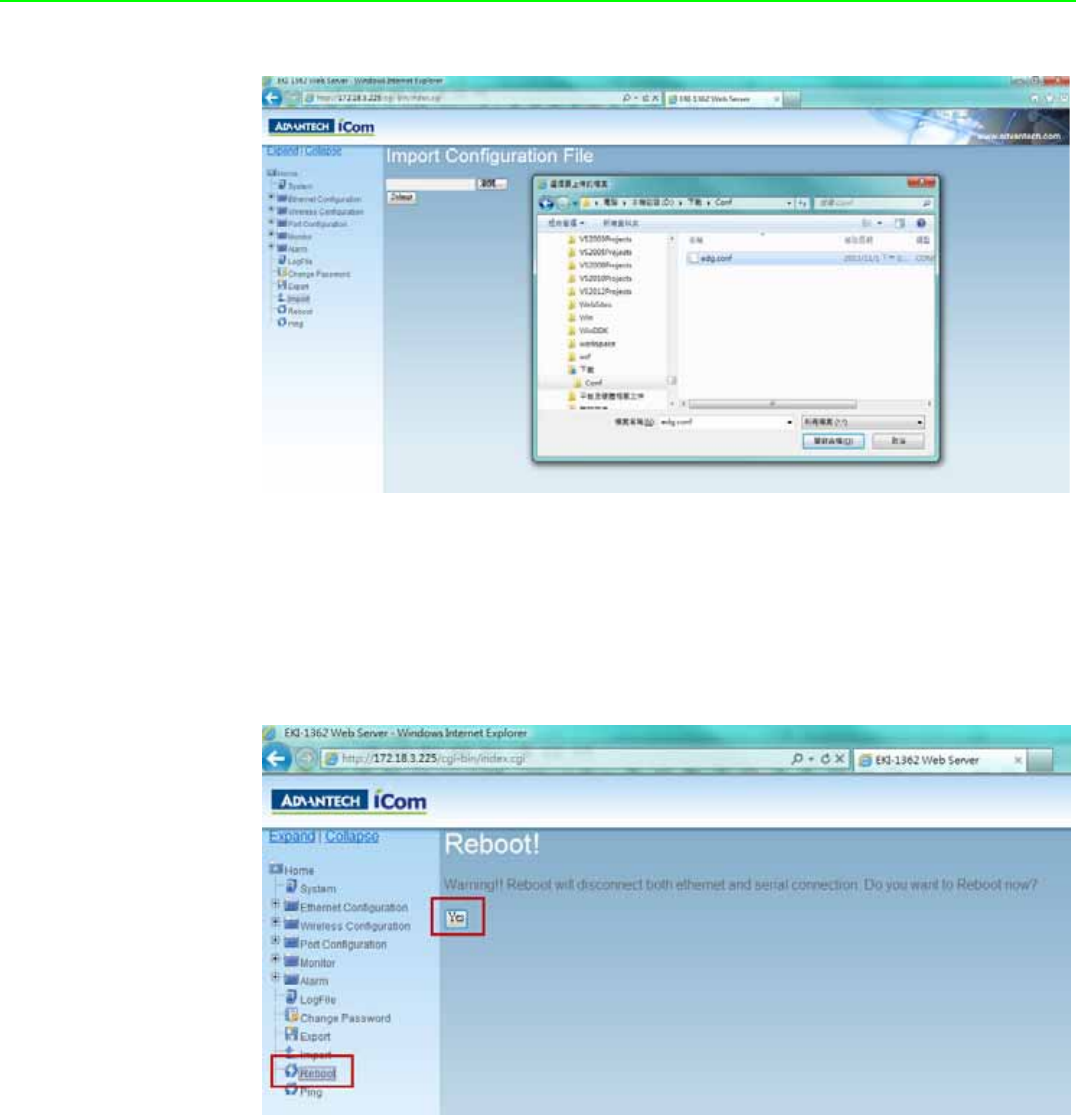
EKI-1361/EKI-1362 User Manual 62
5.11 Reboot
The configuration will take effect after clicking “Save” button. But all configurations
will save to flash memory after this reboot step. Press the “Reboot” button and the
system will give a reset response. It will take a few seconds to reconnect with the
new values.

Chapter 6
6Telnet Configuration
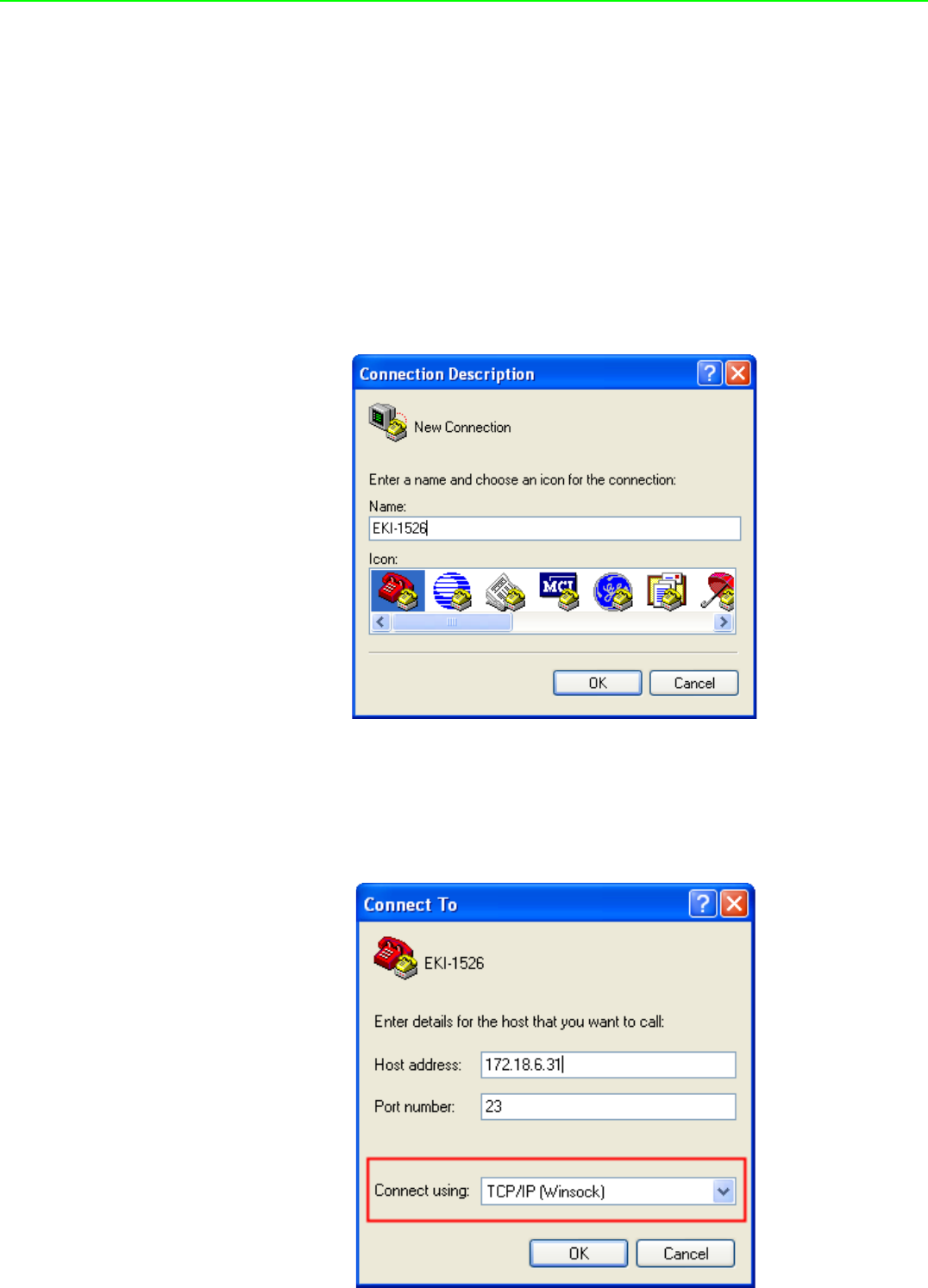
EKI-1361/EKI-1362 User Manual 64
6.1 Overview
The purpose of the Console Configuration is to help you manage your device in con-
sole mode. One of the main functions of the console mode is to change the web con-
figuration login password. You can use terminal software like Hyper Terminal, Telix
and other related terminal software.
6.2 Telnet Console
Create a new connection
You can create a new Telnet connection and assign a connection name for the con-
sole configuration.
Input the IP address
Confirm that the Telnet console configuration works ok. Be sure that your host PC
Ethernet network IP domain is as same as the EKI-152X series serial device server,
and the Telnet TCP port number is “23”.
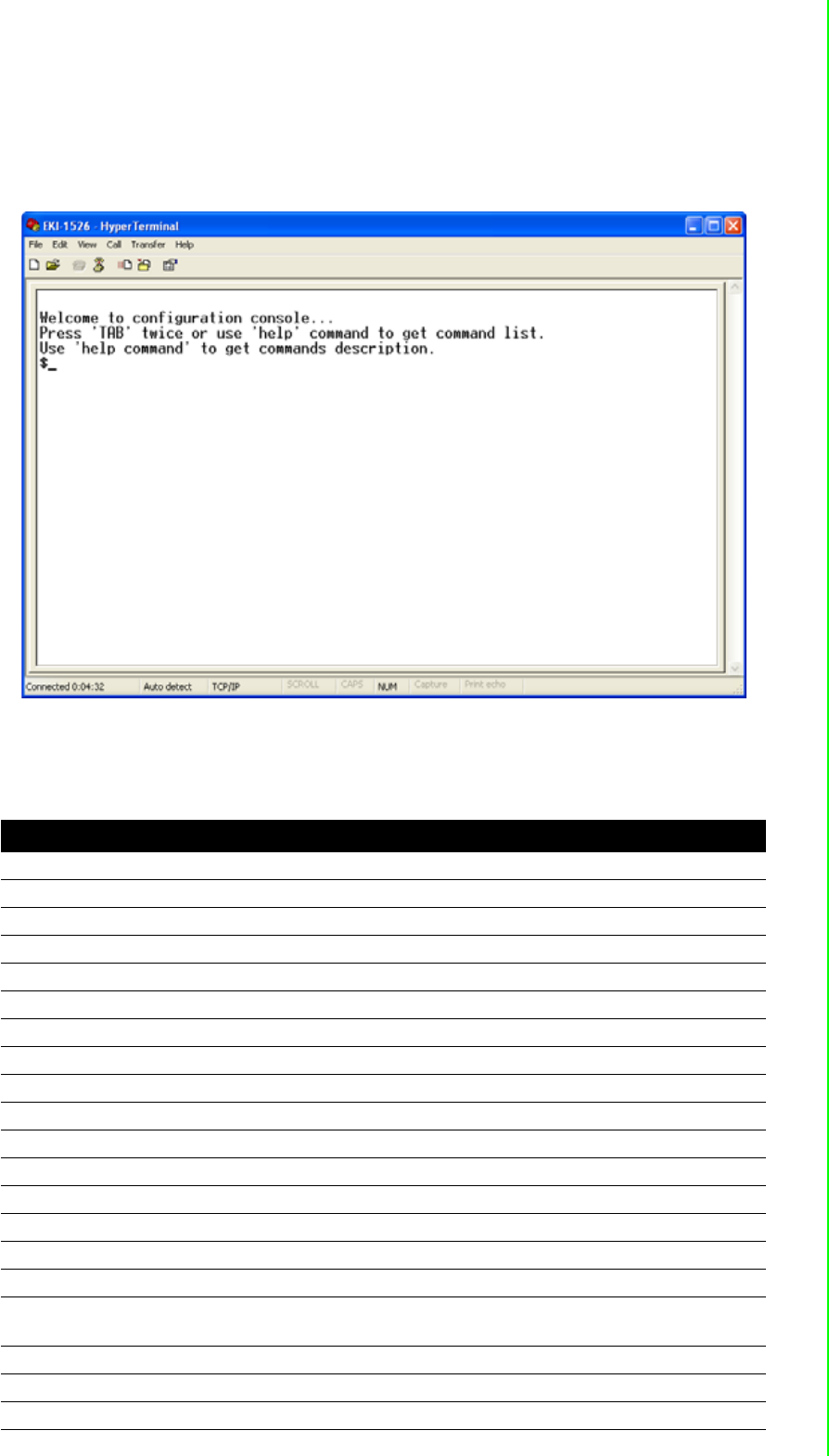
65 EKI-1361/EKI-1362 User Manual
Chapter 6 Telnet Configuration
Connecting Success
After connection the serial device server in Telnet console mode, you can see the
welcome message in the Hyper Terminal Windows.
6.3 Command List
Table 6.1: Console Command List
Command Function Description
system Show or configure the system information
port Show or configure the serial ports information
portadv Show or configure the serial ports advanced settings
mvcom Show or configure the serial ports in Virtual COM mode
mctrl Show or configure the serial ports in Control mode (USDG)
mdata Show or configure the serial ports in Data mode (USDG)
net Show or configure the Ethernet ports settings
password Set or change the password
apply Write settings to the flash memory and reboot the system immediately
exit Terminate the shell session
help Display help information of command list
<Tab> <Tab> Display help information of command list
import Import the serial device server all settings
export Export the serial device server all settings
monitor Monitor the serial ports status
alarm Show or configure the auto warning functions including mail alarm and
SNMP alarm
time Show or configure the time information
service Enable or disable the web, Telnet and SNMP functions
wireless Show or configure the wireless settings or informations
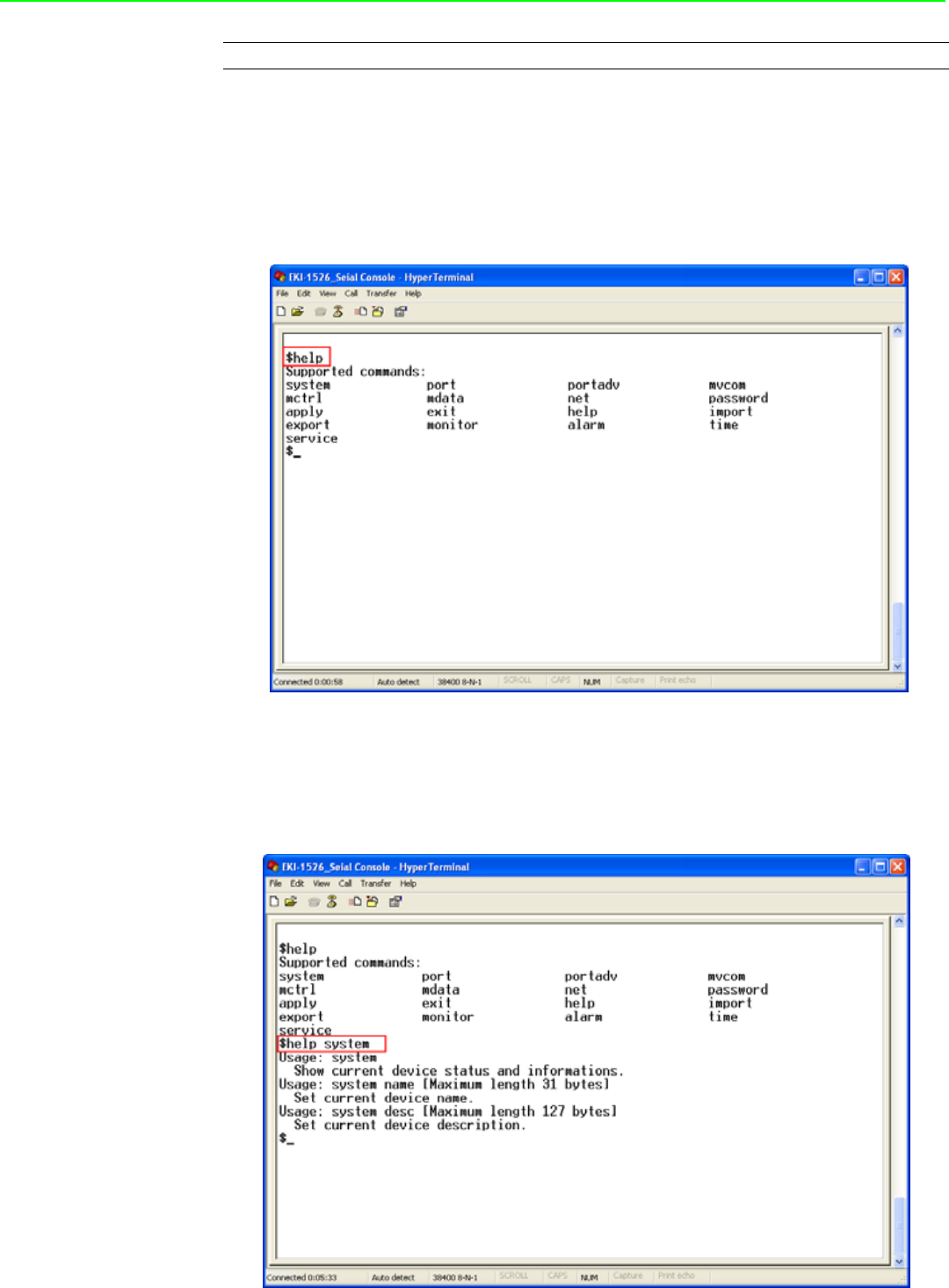
EKI-1361/EKI-1362 User Manual 66
Help
You might type the “help” command or press <Tab> twice to show the supported
command list.
[Usage] help
[Function] Display help information of command list
You might use “help” command to show the usage of all commands.
[Usage] help [command]
[Function] Show the usage of command
wirelessadv Show or configure the advanced wireless settings or informations
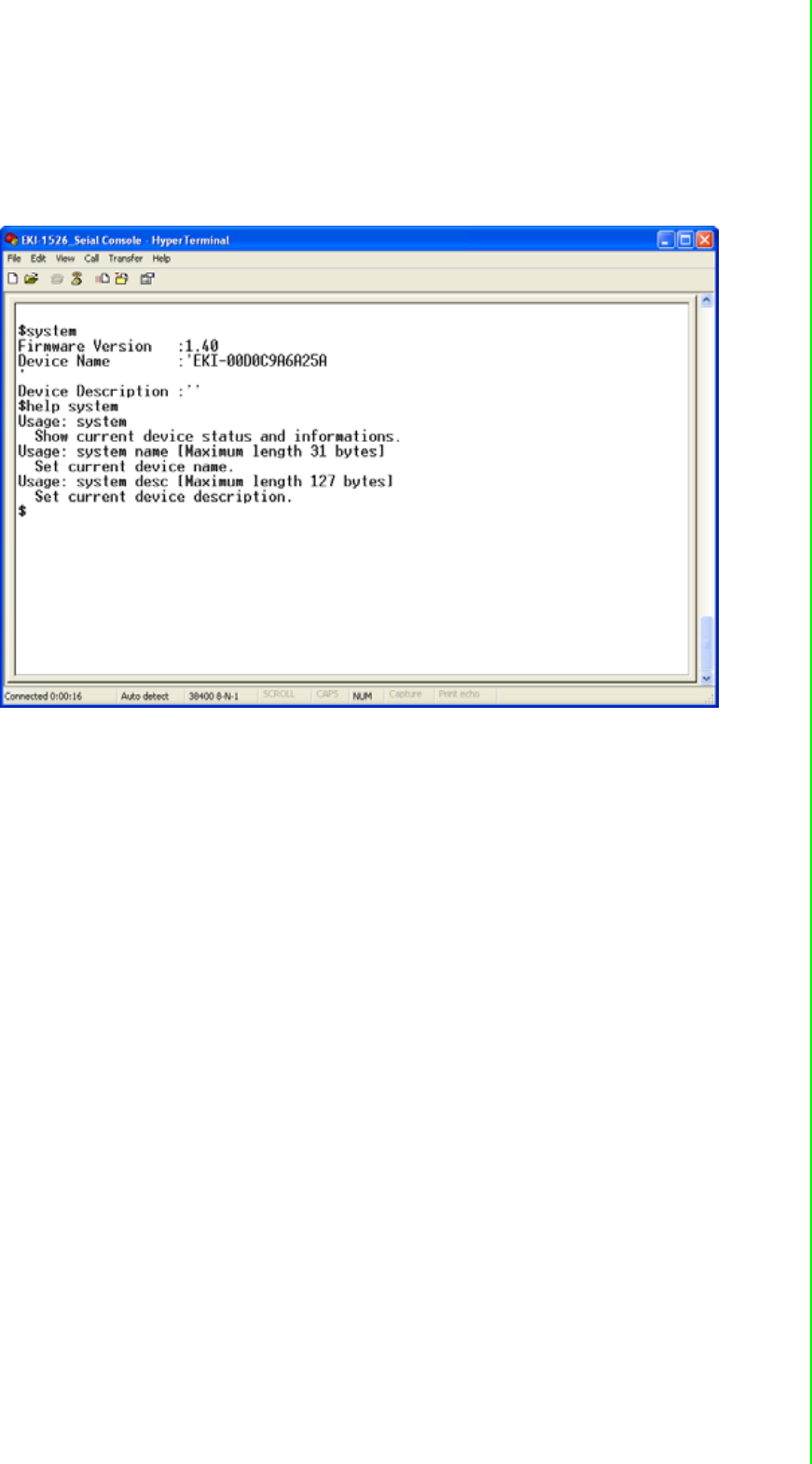
67 EKI-1361/EKI-1362 User Manual
Chapter 6 Telnet Configuration
System
[Usage] system
[Function] Show firmware version, device name and description
[Usage] system
[Function] Show current device status and information
[Usage] system name XXXX
[Function] Set current device name [XXXX: maximum length 31 bytes]
[Usage] system desc XXXX
[Function] Set current device description [XXXX: maximum length 127 bytes]
Port
“Port” is the command to show all serial ports information and configure the serial
ports settings.
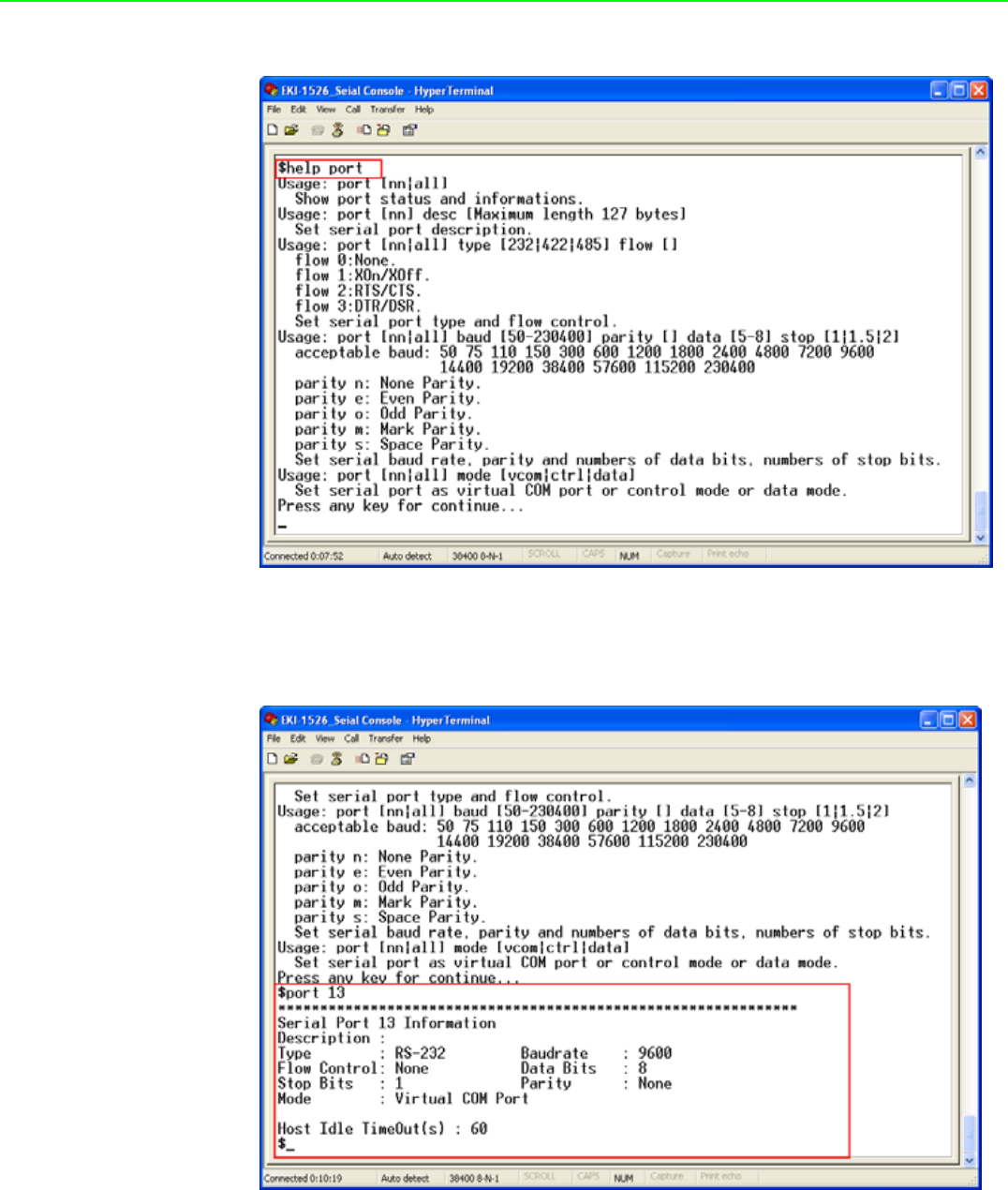
EKI-1361/EKI-1362 User Manual 68
[Usage] port nn or port all
[Function] Show the “nn”th port or all ports information
[Usage] port nn desc XXXX
[Function] Set the “nn”th port’s description [XXXX: maximum length 127 bytes]
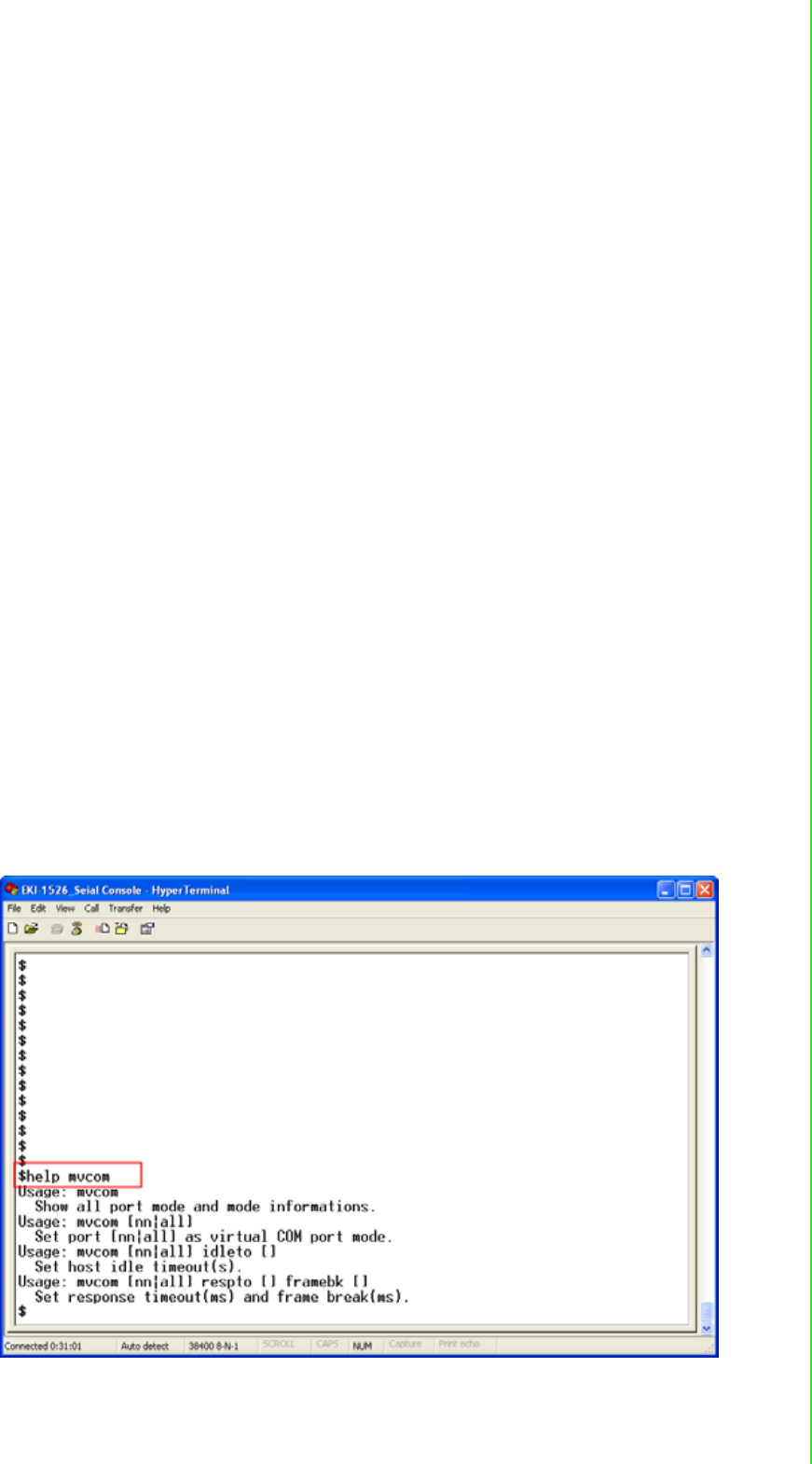
69 EKI-1361/EKI-1362 User Manual
Chapter 6 Telnet Configuration
[Usage] port nn||all type 232|422|485 flow 0|1|2|3
[Function] Set serial ports’ type and flow control
Flow 0: None
Flow 1: XOn/XOff
Flow2: RTS/CTS
Flow3: DTR/DSR
[Usage] port nn|all baud XXXX parity n|e|o|m|s data 5|6|7|8 stop 1|1.5|2
[Function] Set the serial ports’ baud rate, parity, data bits, and stop bits.
Acceptable baud rate: 50, 75, 110, 150, 300, 600, 1200, 1800, 2400, 4800, 7200,
9600, 14400, 19200, 38400, 57600, 115200, 230400, 460800, and 921600
Parity n: None
Parity e: Even
Parity o: Odd
Parity m: Mark
Parity s: Space
[Usage] port nn|all mode vcom|ctrl|data
[Function] Set the serial ports as virtual COM mode, control mode, or data mode
mvcom
Show and setup the VCOM mode
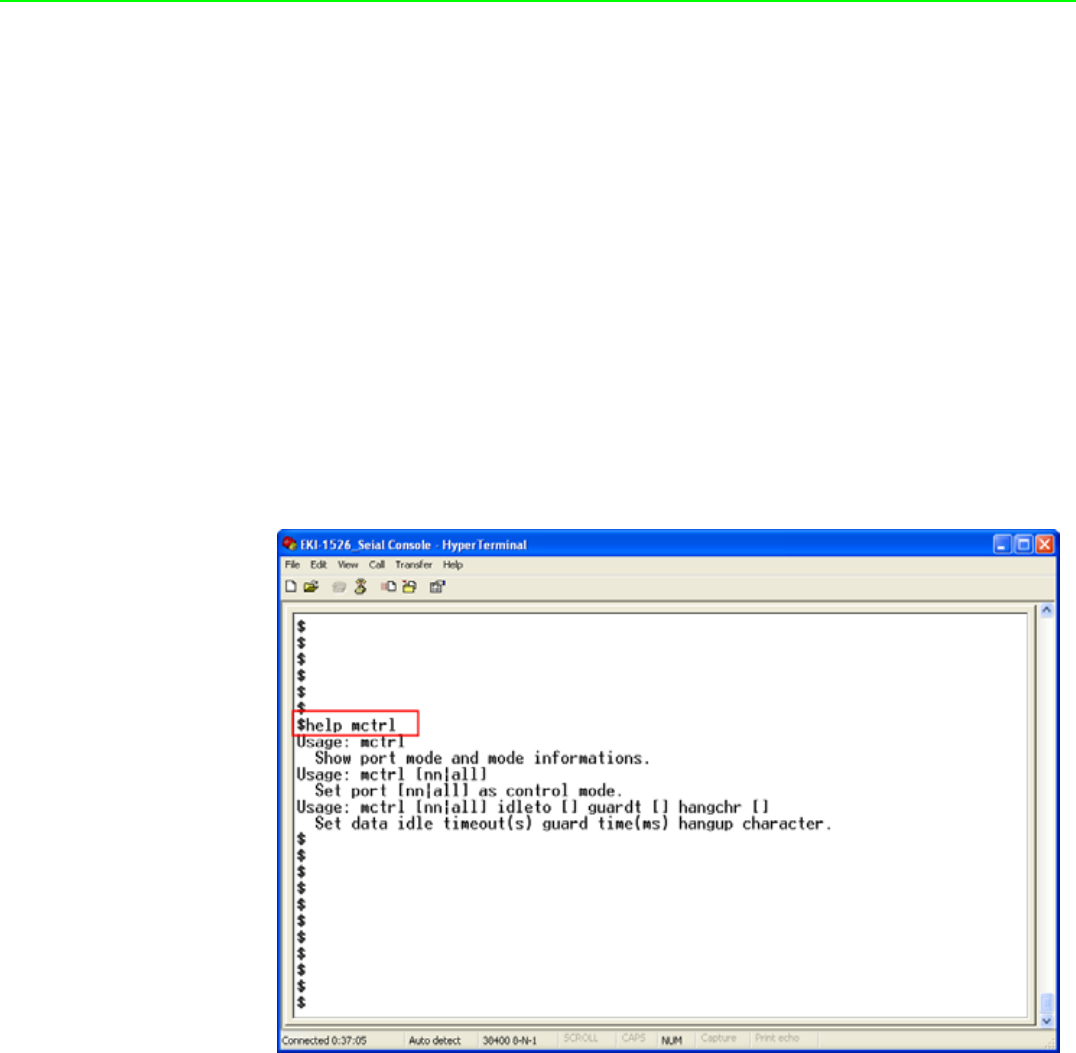
EKI-1361/EKI-1362 User Manual 70
[Usage] mvcom
[Function] Show all serial ports mode and related information
[Usage] mvcom nn|all
[Function] Set the “nn”th or all serial ports as the Virtual COM mode
[Usage] mvcom nn|all idleto XX
[Function] Set the “nn”th or all serial ports host idle timeout (S)
[Usage] mvcom nn|all respto XX framebk XX
[Function] Set the “nn”th or all serial ports response timeout and frame break
mctrl
Show and setup the Control mode
[Usage] mctrl
[Function] Show all serial ports mode and related information
[Usage] mctrl nn|all
[Function] Set the “nn”th or all serial ports as the Control mode
[Usage] mctrl nn|all idleto XX guardt XX hangchr XX
[Function] Set the “nn”th or all serial ports data idle timeout, guard time and hang
character
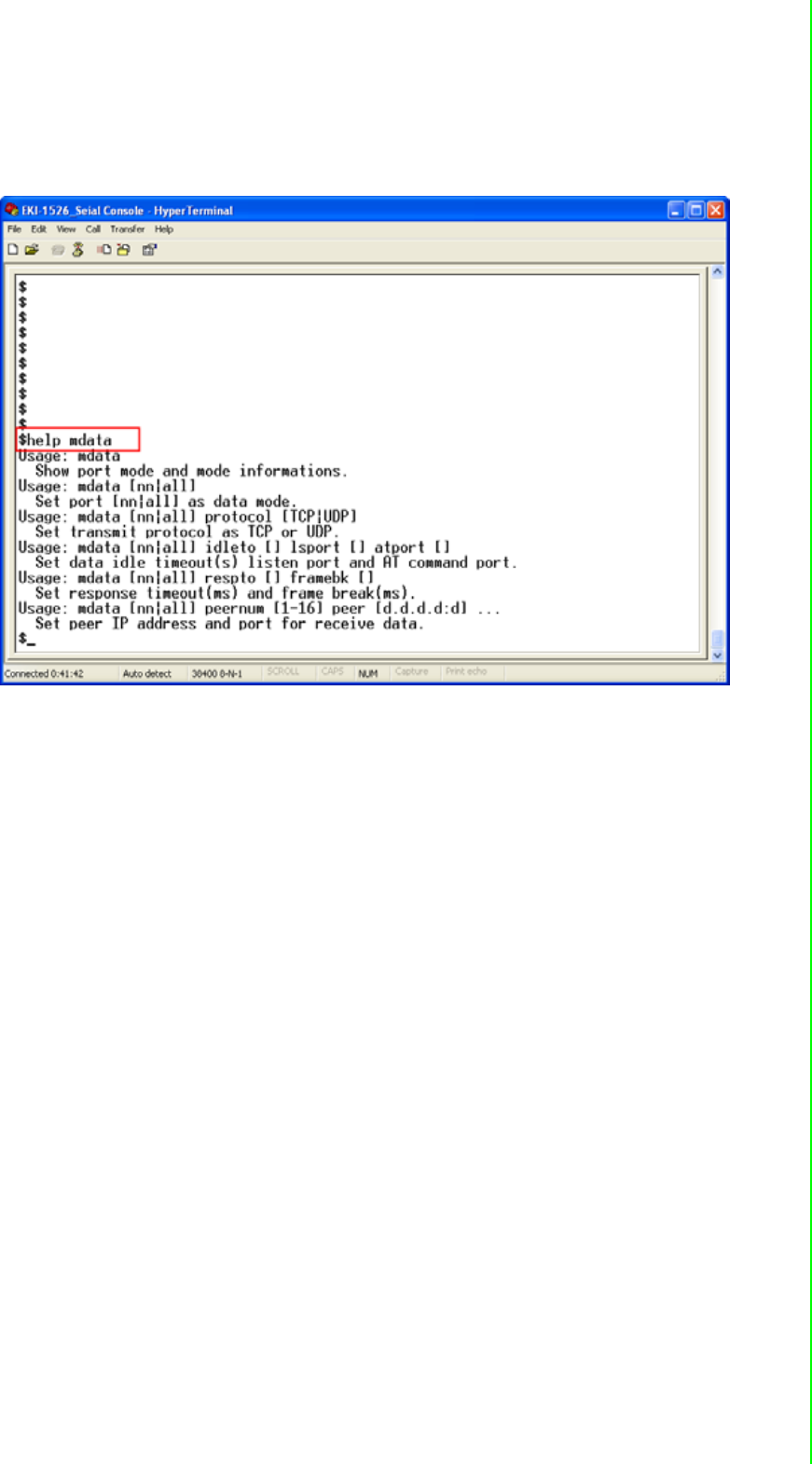
71 EKI-1361/EKI-1362 User Manual
Chapter 6 Telnet Configuration
mdata
Show and setup the Data mode
[Usage] mdata
[Function] Show all serial ports mode and related information
[Usage] mdata nn|all
[Function] Set the “nn”th or all serial ports as the Data mode
[Usage] mdata nn|all protocol TCP|UDP
[Function] Set the “nn”th or all serial ports’ transmit protocol as TCP or UDP
[Usage] mdata nn|all idleto XX lsport XXXX atport XXXX
[Function] Set the “nn”th or all serial ports data idle timeout, listen port, and AT com-
mand port
[Usage] mdata nn|all respto XX framebk XX
[Function] Set the “nn”th or all serial ports response timeout and frame break
[Usage] mdata nn|all peernum 1|2|3|4|5|6|7|8|9|10|11|12|13|14|15|16 peer
XX.XX.XX.XX:ppp
[Function] Set the peer IP address and port for receive data
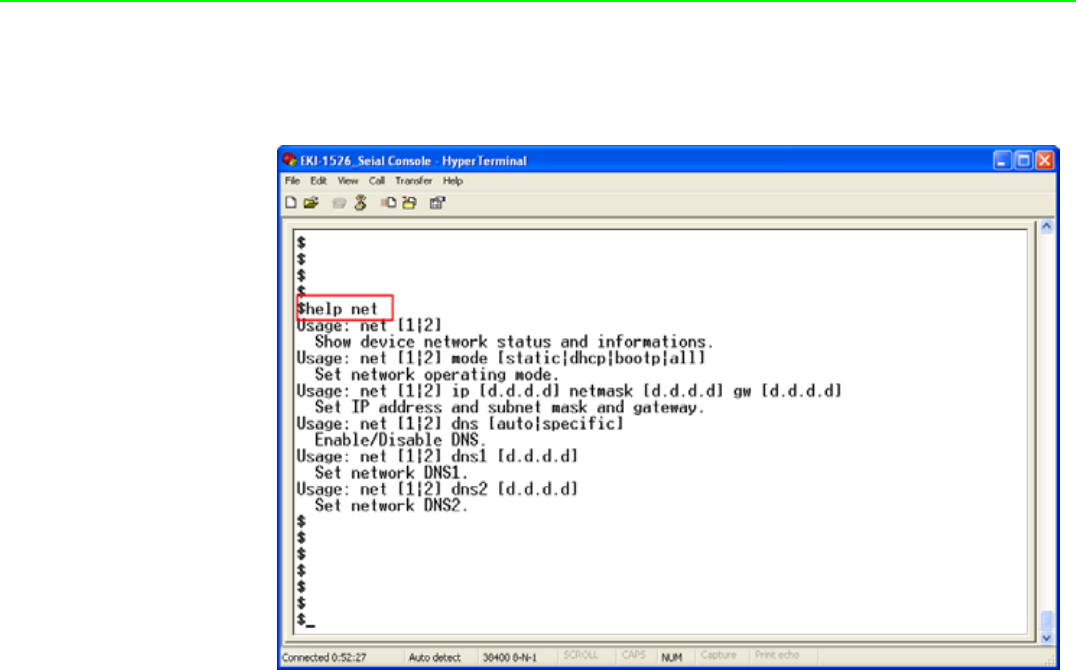
EKI-1361/EKI-1362 User Manual 72
net
Show and setup the Ethernet port configuration
[Usage] net 1|2
[Function] Show the first or second Ethernet port status and information
[Usage] net 1|2 mode static|dhcp|boot|all
[Function] Set the network operating mode
[Usage] net 1|2 ip XX.XX.XX.XX netmask XX.XX.XX.XX gw XX.XX.XX.XX
[Function] Set IP address, subnet mask, and default gateway
[Usage] net 1|2 dns auto|specific
[Usage] net 1|2 dns1 XX.XX.XX.XX
[Usage] net 1|2 dns2 XX.XX.XX.XX
[Function] Set the DNS function
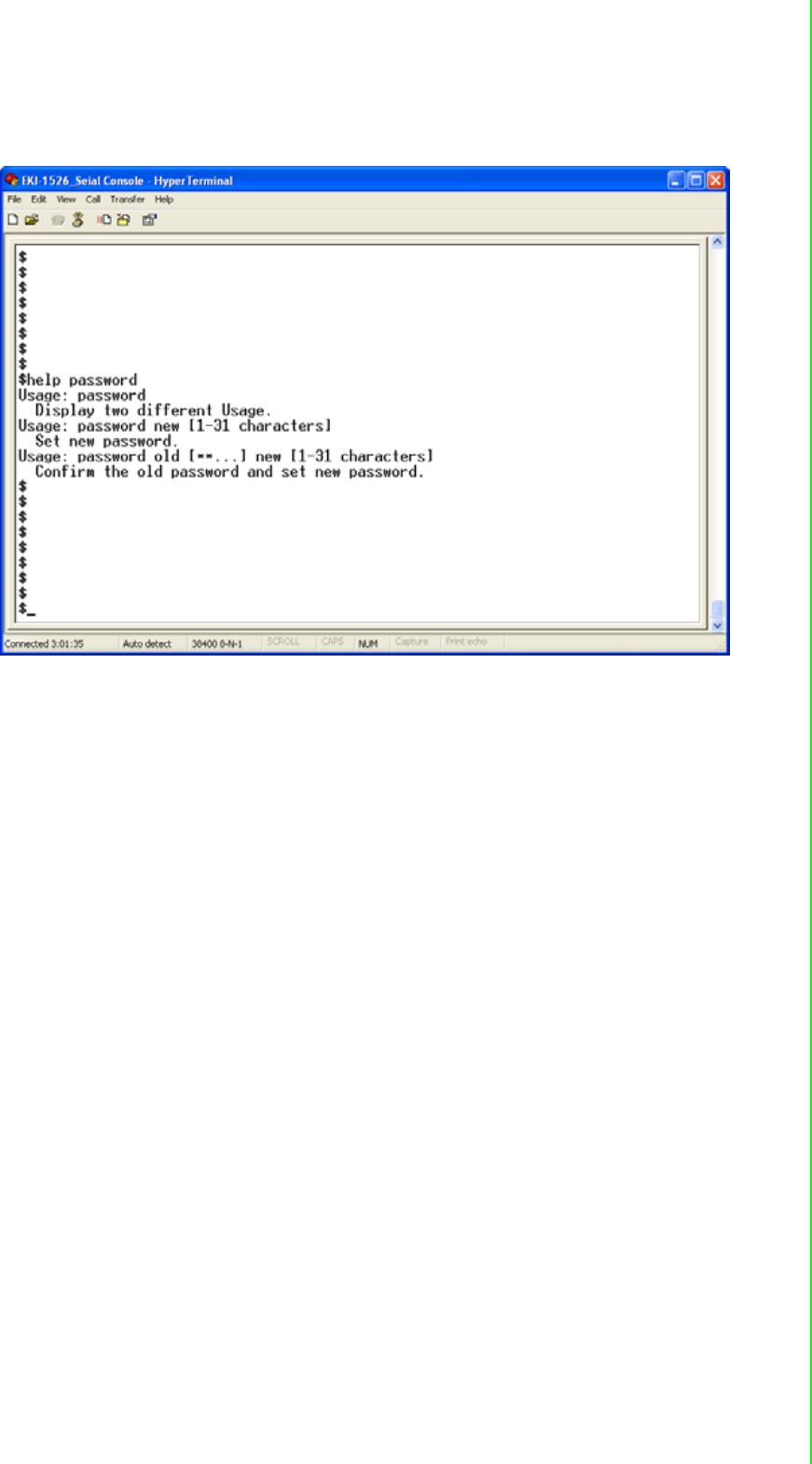
73 EKI-1361/EKI-1362 User Manual
Chapter 6 Telnet Configuration
password
[Usage] password new XXXX
[Function] Set new password [XXXX: maximum 31 characters]
[Usage] password old XXXX new XXXX
[Function] Confirm the old password and set a new password
apply
[Usage] apply
[Function] Save the settings to the flash memory and reboot the system immediately
exit
[Usage] exit
[Function] Terminate the shell session
import/export
[Usage] import
[Function] Import the serial device server settings’ file
[Usage] export
[Function] Export the serial device server settings’ file
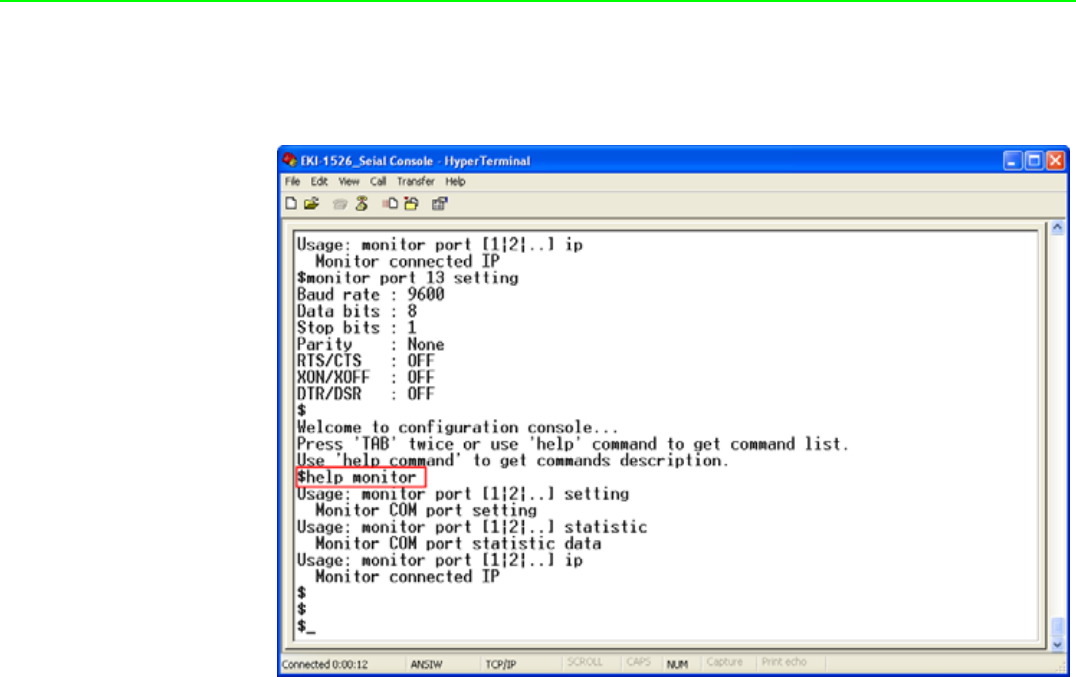
EKI-1361/EKI-1362 User Manual 74
monitor
Show the serial ports settings, statistic, and connected IP address
[Usage] monitor port 1|2|…|16 setting
[Function] Monitor the serial ports settings
[Usage] monitor port 1|2|…|16 statistic
[Function] Monitor the serial ports statistic
[Usage] monitor port 1|2…|16 ip
[Function] Monitor the serial ports connected IP address
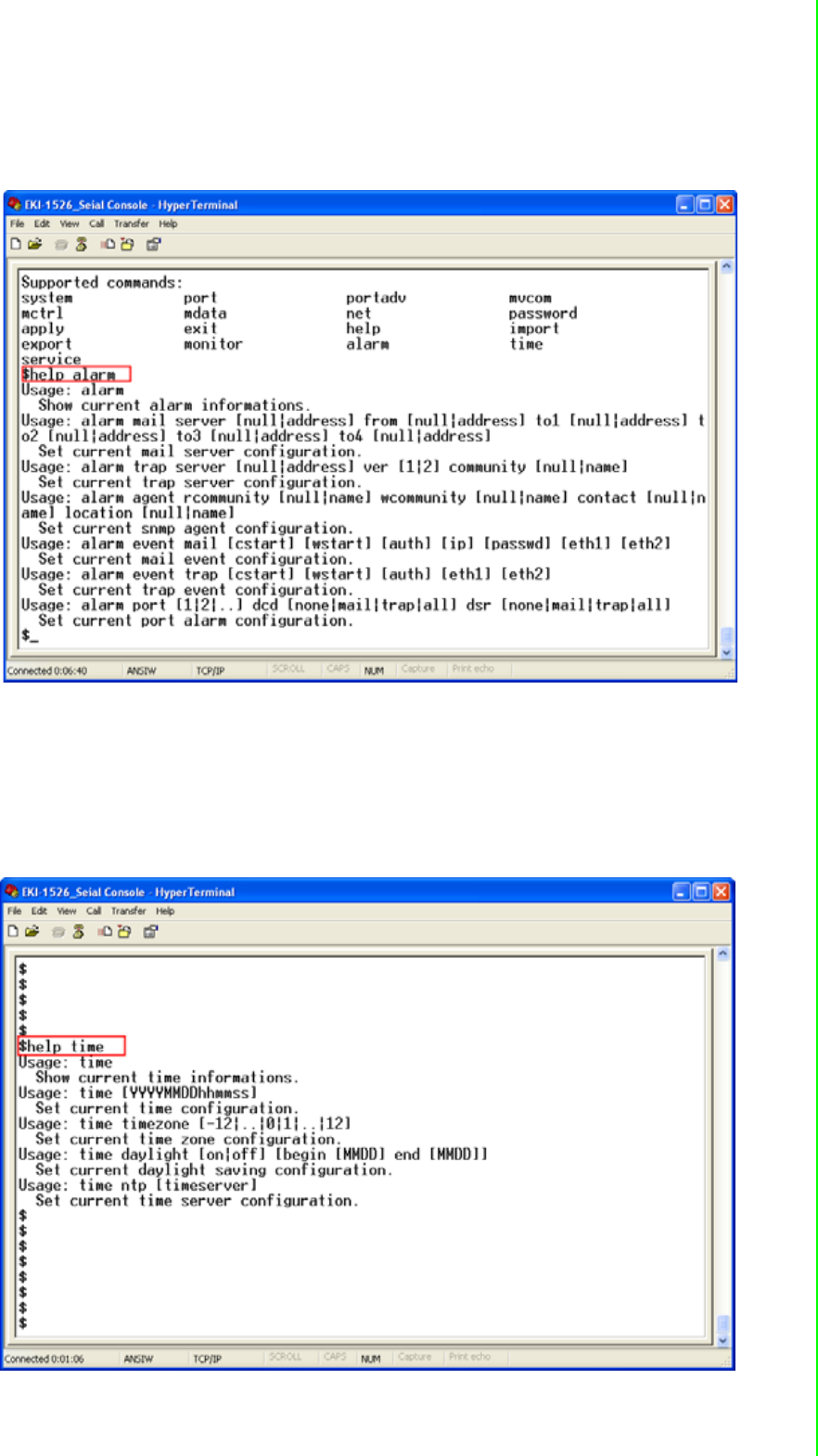
75 EKI-1361/EKI-1362 User Manual
Chapter 6 Telnet Configuration
alarm
Show or configure the auto warning function
For more detailed setting for auto warning, please refer to chapter 3.7
time
Show or configure the time information
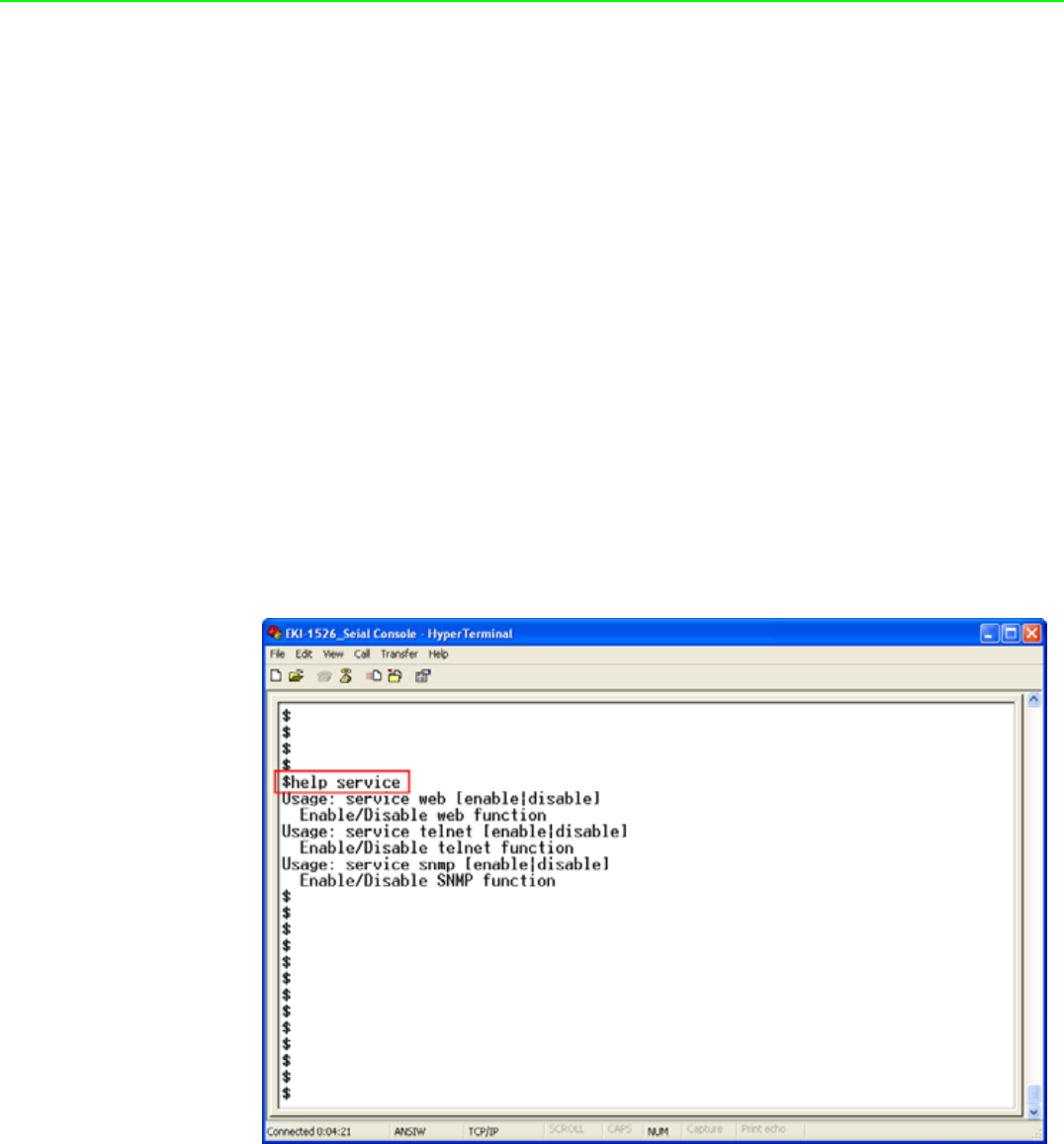
EKI-1361/EKI-1362 User Manual 76
[Usage] time
[Function] Show the current time information
[Usage] time YYYYMMDDhhmmss
[Function] Modify the current time information
[Usage] time timezone -12|…|0|1|…|12
[Function] Set the current timezone configuration
[Usage] time daylight on|off begin MMDD end MMDD
[Function] Set the current time daylight saving configuration
[Usage] time ntp XXXX
[Function] Set the NTP timeserver [XXXX: time server]
service
Enable or disable some extra service
[Usage] service web enable|disable
[Function] Enable or disable the web-based configuration
[Usage] service telnet enable|disable
[Function] Enable or disable the telnet console
[Usage] service SNMP enable|disable
[Function] Enable or disable the SNMP function

77 EKI-1361/EKI-1362 User Manual
Chapter 6 Telnet Configuration
wireless
Show or configure the wireless settings or informations
[Usage] wireless
[Function] Show or configure the wireless settings or informations
[Usage] wireless ssid XXXX
[Function]Set SSID as XXXX
[Usage] wireless country us|de|fr|es|jp|kr|cn channel 0|1|…|14
[Function] Set country code and channel.
us - United States
de – Germany
fr – France
es - Spain
jp – Japan
kr – Korea
cn - China
channel 0 - Auto
[Usage] wireless encryption none|wep|wpa-psk|wpa-enterprise
[Function] Set encryption type.
[Usage] wireless wepauth on|off
[Function] Set WEP authentication algorithm.
[Usage] wireless wepidx 0|1|2|3
[Function] Set WEP key index.
[Usage] wireless wepkey asc|hex XXXX
[Function] Set WEP key as XXXX in specific format
[Usage] wireless wpakey XXXX
[Function] Set WPA-PSK key as XXXX
[Usage] wireless wpaeap tls|ttls|peap
[Function] Set WPA-Enterprise EAP method.
[Usage] wirelesswpa11w 0|1|2
[Function] Set WPA-Enterprise management frame protected.
0 – Disable
1 – Optional
2 – Required
[Usage] wireless wpaid XXXX
[Function] Set WPA-Enterprise identity as XXXX.

EKI-1361/EKI-1362 User Manual 78
[Usage] wireless wpapw XXXX
[Function] Set WPA-Enterprise as XXXX.
[Usage] wireless wpaphase mschapv2|md5
[Function] Set WPA-Enterprise inner authentication.
[Usage] wireless capw XXXX
[Function] Set private key as XXXX.
[Usage] wireless cacert
[Function] import the CA certification from host PC to device.
[Usage] wireless caclient
[Function] import the Client certification from host PC to device.
[Usage] wireless cakey
[Function] import the private key from host PC to device.
wirelessadv
Show or configure the wireless advanced settings or information
[Usage] wirelessadv
[Function] Show device wireless advance informations.
[Usage] wirelessadv rts 256|…|2347
[Function] Set RTS threshold.
[Usage] wirelessadv frag 256|…|2346
[Function] Set fragmentation threshold.
[Usage] wirelessadv roaming on|off
[Function] Enable/disable Roaming.
[Usage] wirelessadv rssi 10|…|95
[Function] Set connection quality monitor RSSI threshold.
[Usage] wirelessadv preamble short|long
[Function] Set preamble.
[Usage] wirelessadv scanint_high 10|…|600
[Function] Set scan interval when received signal strength is better than RSSI
threshold.
[Usage] wirelessadv scanint_low 10|…|600
[Function] Set scan interval when received signal strength is worse than RSSI
threshold.

Appendix A
APin Assignments

EKI-1361/EKI-1362 User Manual 80
A.1 Pin Assignments
A.1.1 RS-232 Pin Assignments
A.1.2 RS-422/485 Pin Assignments
A.1.2.1 1. RS-422
A.1.2.2 2. RS-485
Pin # Description
1DCD
2Rx
3Tx
4DTR
5GND
6DSR
7RTS
8CTS
9RI
Pin #. Description
1Tx-
4Tx+
5GND
7Rx+
9Rx-
Pin # Description
1Data-
4Data+
5GND

Appendix B
BList of Known TCP and
UDP Port Numbers

EKI-1361/EKI-1362 User Manual 82
B.1 List of Known TCP and UDP Port Numbers
Port Protocol Service
5048 (TCP/UDP) Configuration Utility
5058 (TCP/UDP) Configuration Utility
5202 (TCP) VCOM/RVCOM
9999 (TCP) Firmware Download
22 (TCP) SSH
23 (TCP) Telnet
25 (TCP) SMTP(Mail Client)
53 (TCP/UDP) DNS
67 (UDP) BOOTP Server/DHCP
68 (UDP) BOOTP Client/DHCP
80 (TCP) Web Interface/HTTP
123 (TCP) NTP
161 (UDP) SNMP
162 (TCP/UDP) SNMP Trap
443 (TCP) HTTPS
502 (TCP) Modbus/TCP(Default)
514 (UDP) Syslog
546 (TCP/UDP) DHCPv6 Client
547 (TCP/UDP) DHCPv6 Server

83 EKI-1361/EKI-1362 User Manual
Appendix B List of Known TCP and UDP Port Numbers

www.advantech.com
Please verify specifications before quoting. This guide is intended for reference
purposes only.
All product specifications are subject to change without notice.
No part of this publication may be reproduced in any form or by any means,
electronic, photocopying, recording or otherwise, without prior written permis-
sion of the publisher.
All brand and product names are trademarks or registered trademarks of their
respective companies.
© Advantech Co., Ltd. 2013
Federal Communication Commission Interference Statement
This equipment has been tested and found to comply with the limits for a Class B
digital device, pursuant to Part 15 of the FCC Rules. These limits are designed to
provide reasonable protection against harmful interference in a residential installation.
This equipment generates, uses and can radiate radio frequency energy and, if not
installed and used in accordance with the instructions, may cause harmful interference
to radio communications. However, there is no guarantee that interference will not
occur in a particular installation. If this equipment does cause harmful interference
to radio or television reception, which can be determined by turning the equipment off
and on, the user is encouraged to try to correct the interference by one of the
following measures:
zReorient or relocate the receiving antenna.
zIncrease the separation between the equipment and receiver.
zConnect the equipment into an outlet on a circuit different from that to which
the receiver is connected.
zConsult the dealer or an experienced radio/TV technician for help.
15.21
FCC Caution: Any changes or modifications not expressly approved by the party
responsible for compliance could void the user's authority to operate this equipment.
15.19
This device complies with Part 15 of the FCC Rules. Operation is subject to the
following two conditions: (1) This device may not cause harmful interference, and (2)
this device must accept any interference received, including interference that may
cause undesired operation.
FCC RF Radiation Exposure Statement:
1. This Transmitter must not be co-located or operating in conjunction with any other
antenna or transmitter.
2. This equipment complies with FCC RF radiation exposure limits set forth for an
uncontrolled environment. This equipment should be installed and operated with a
minimum distance of 20 centimeters between the radiator and your body.